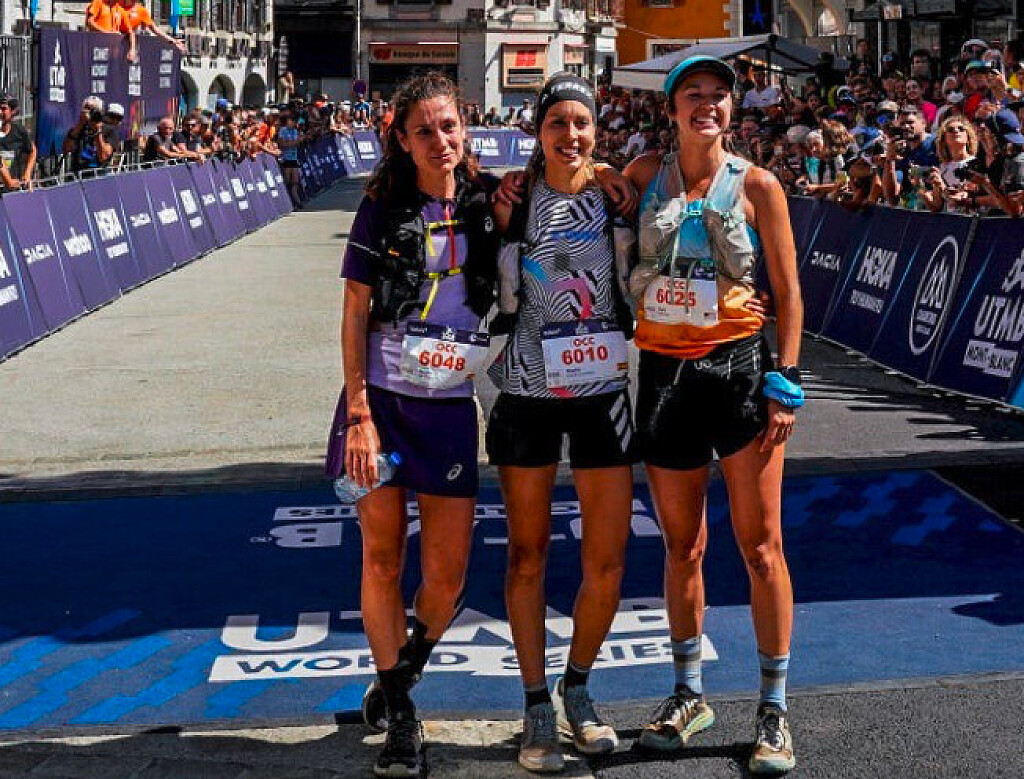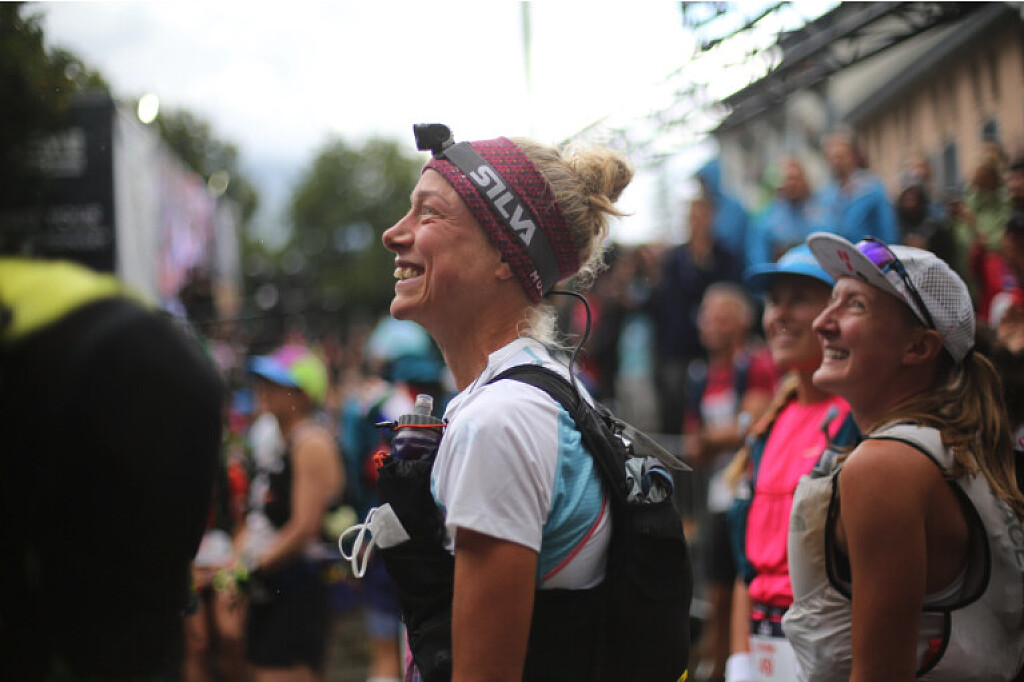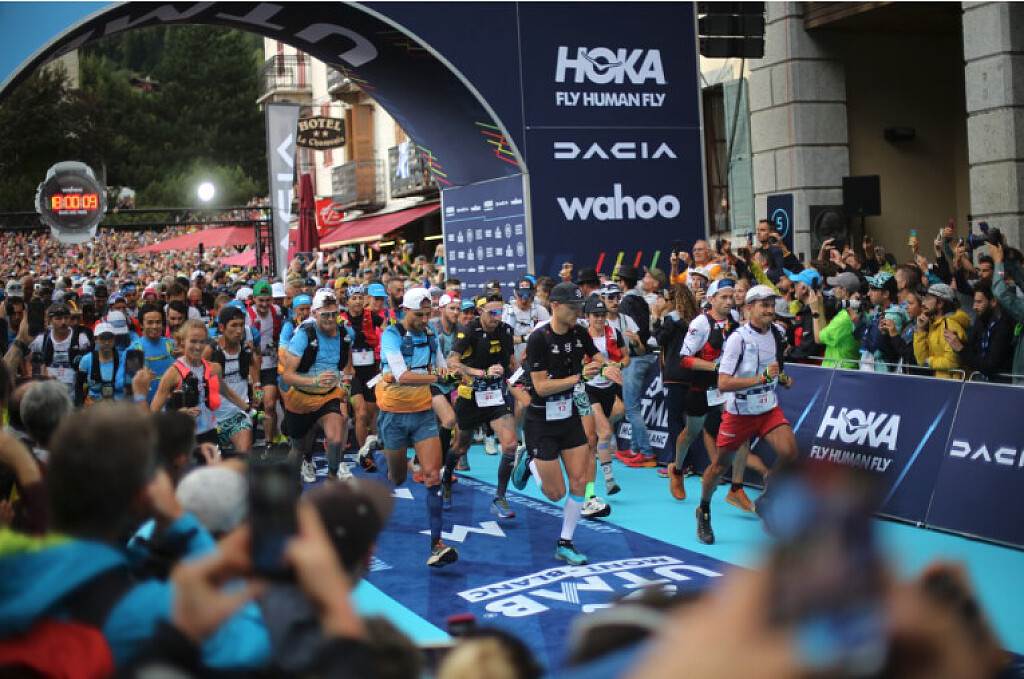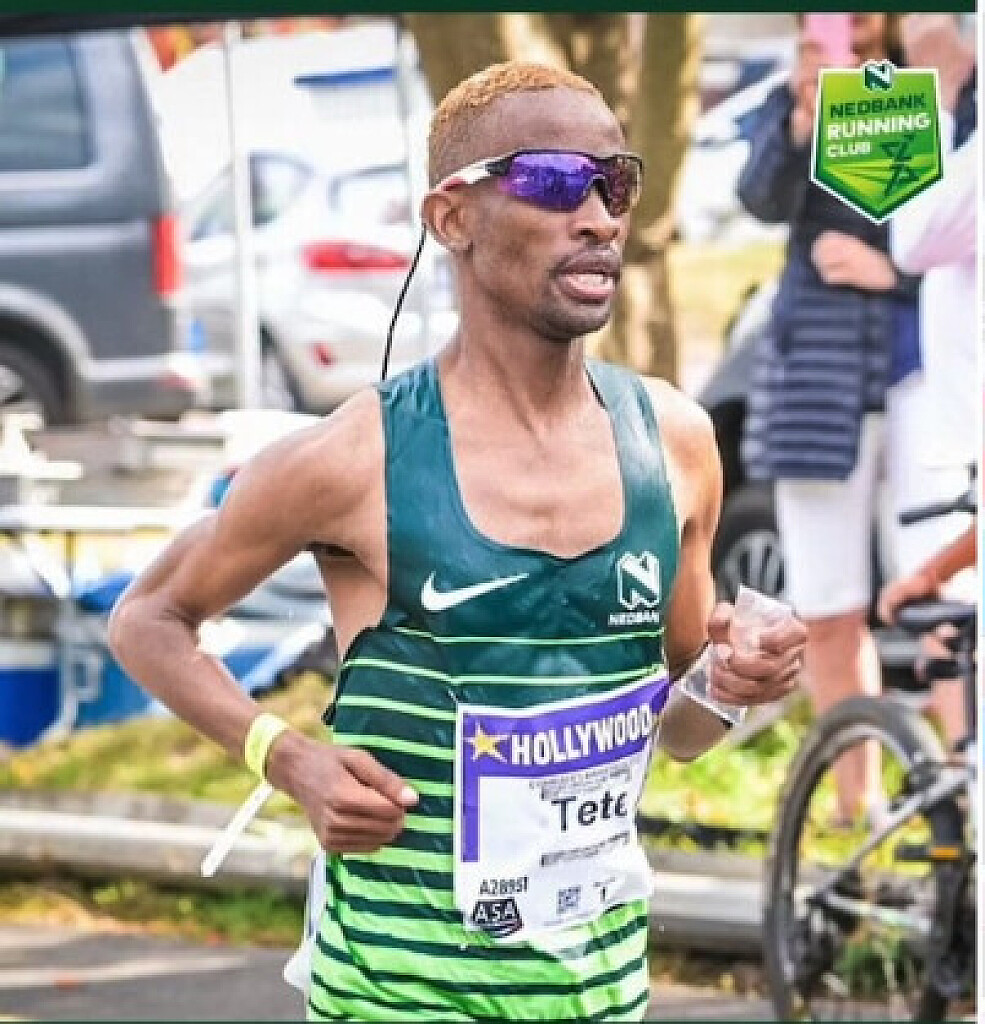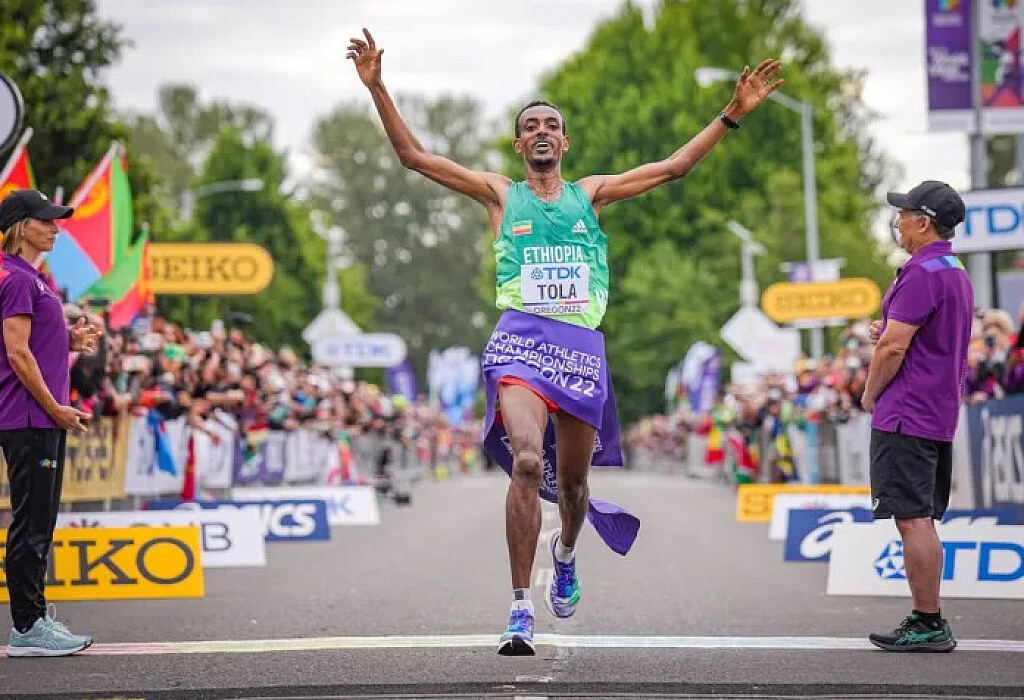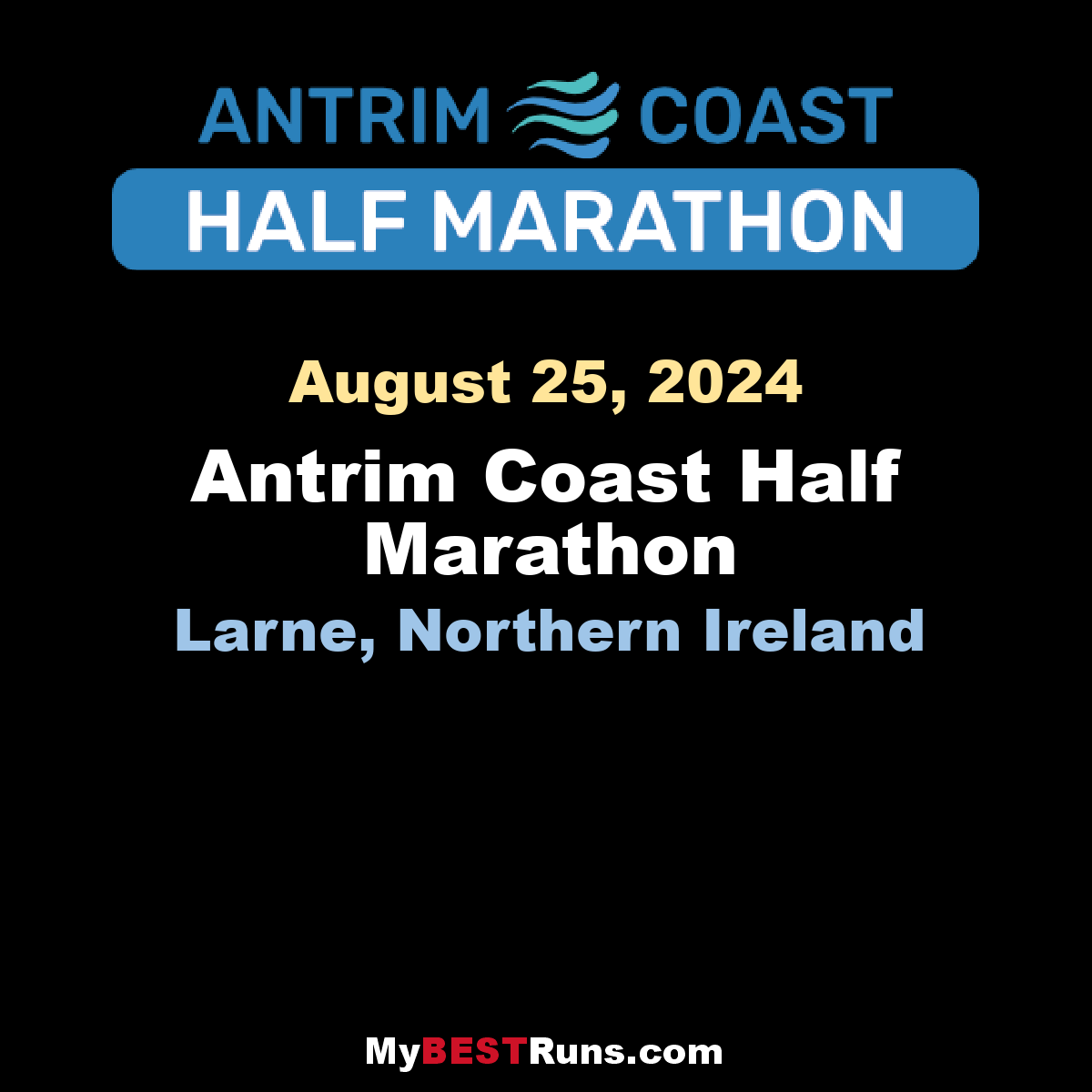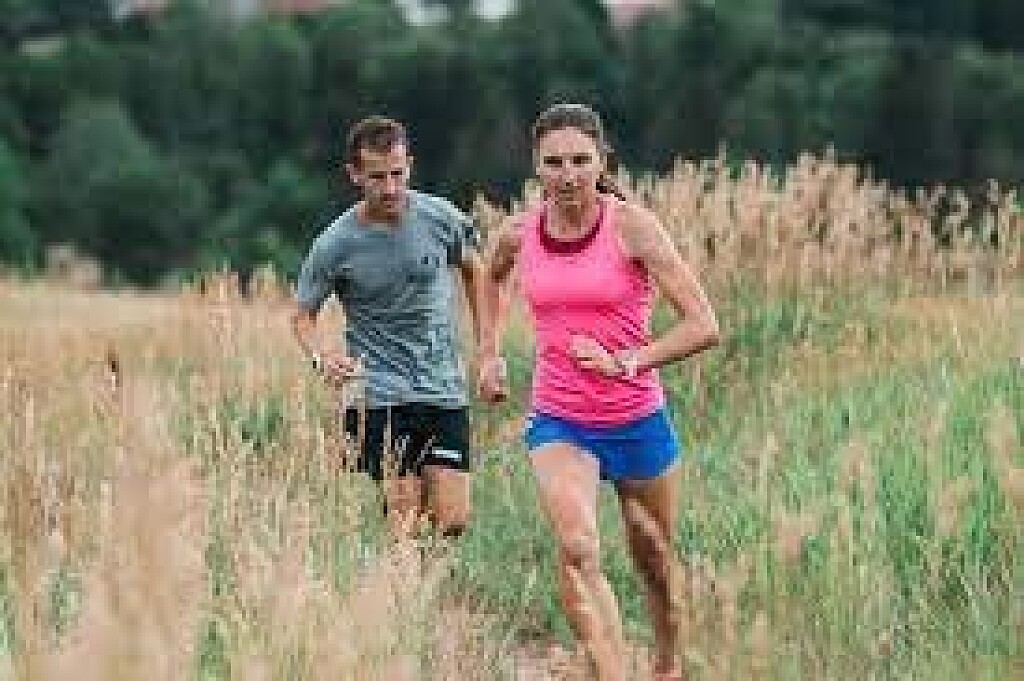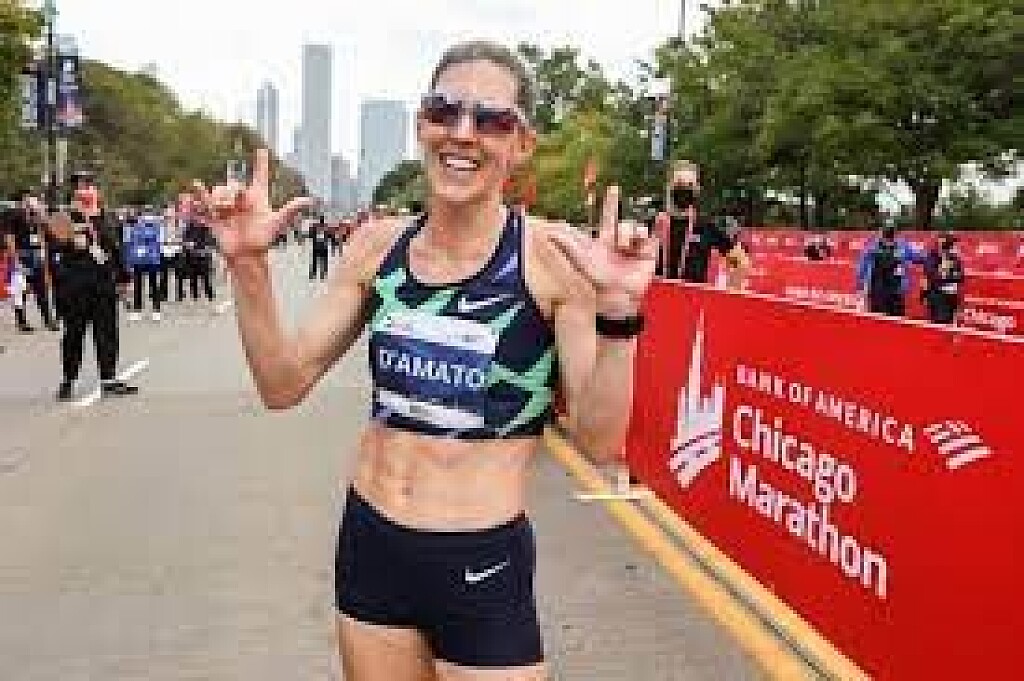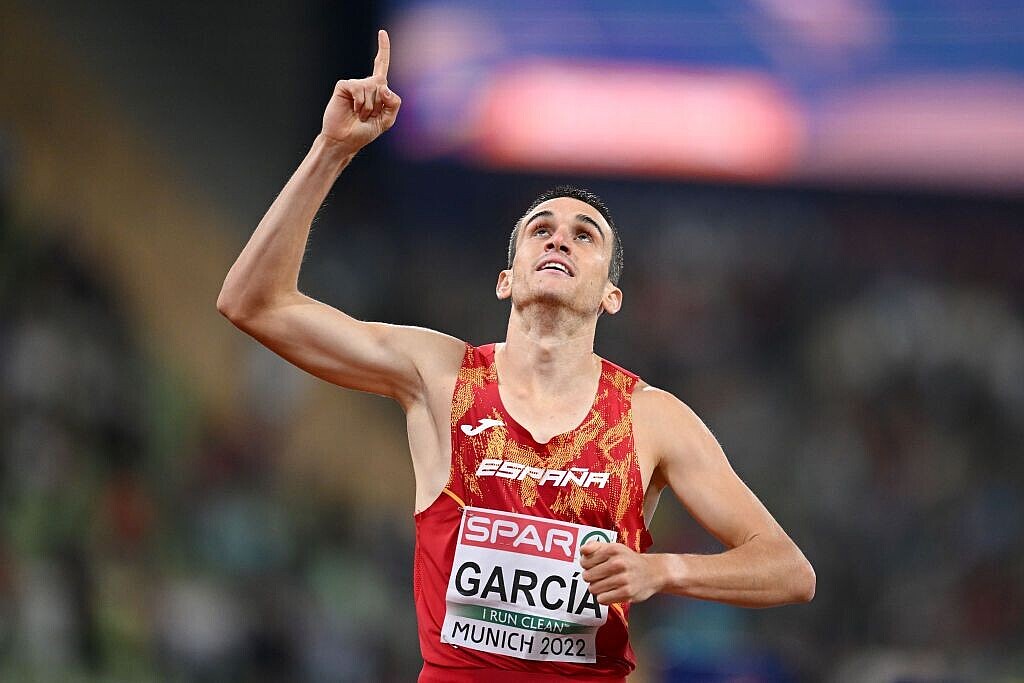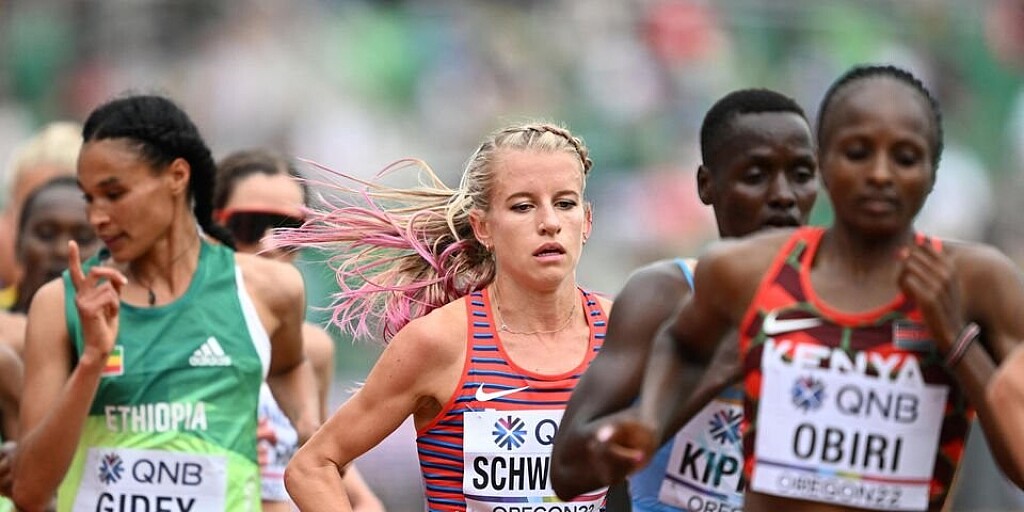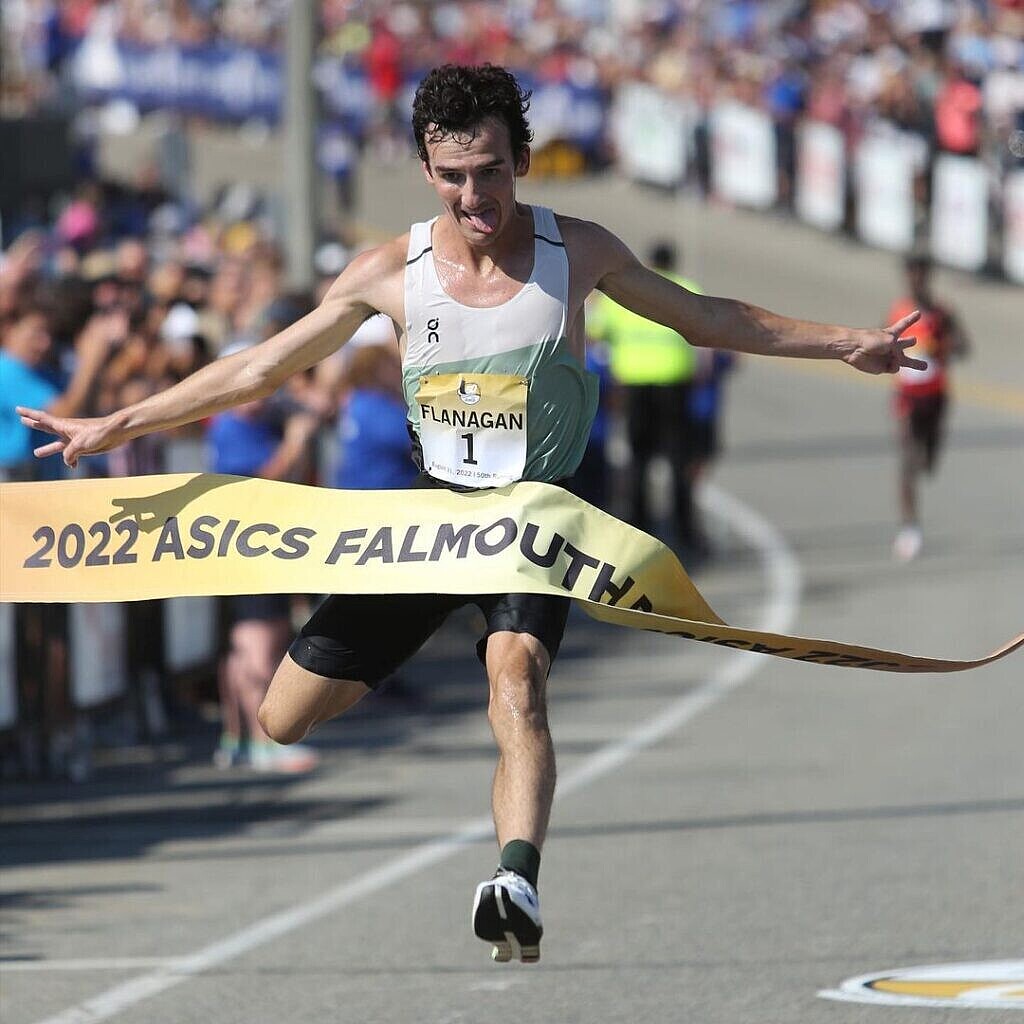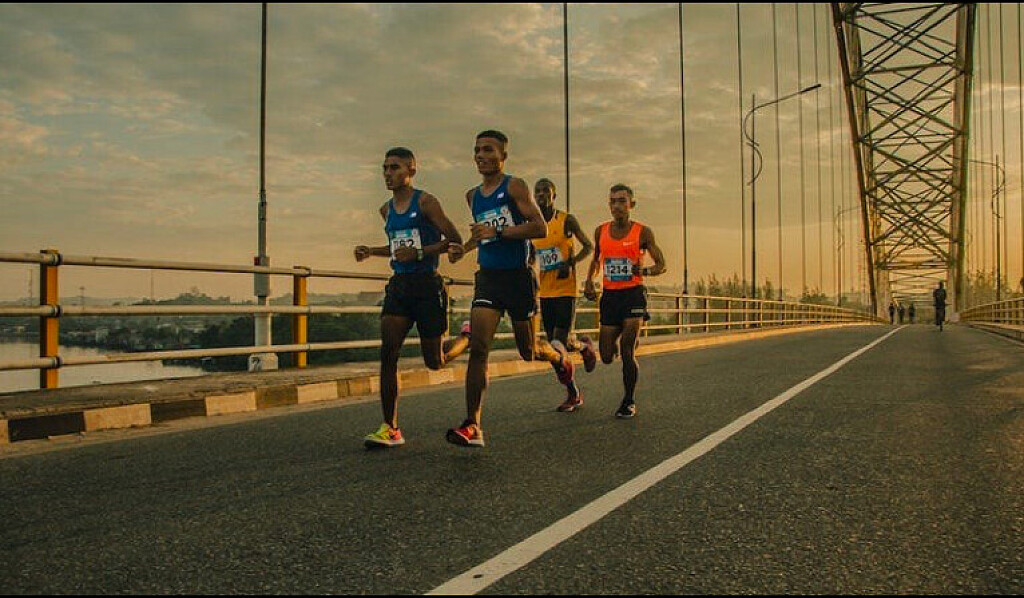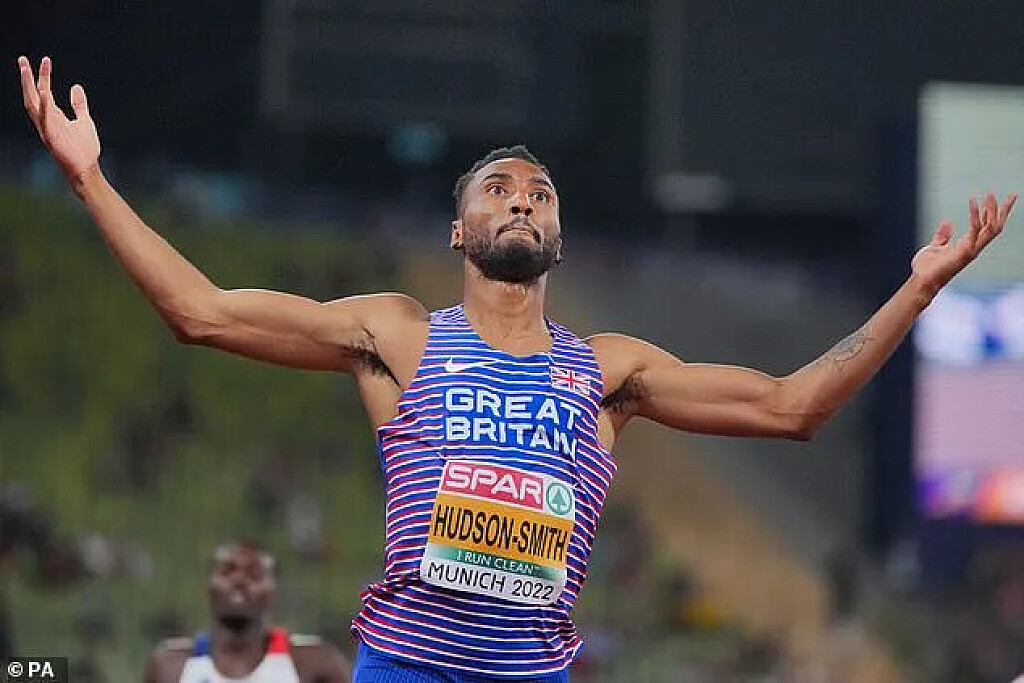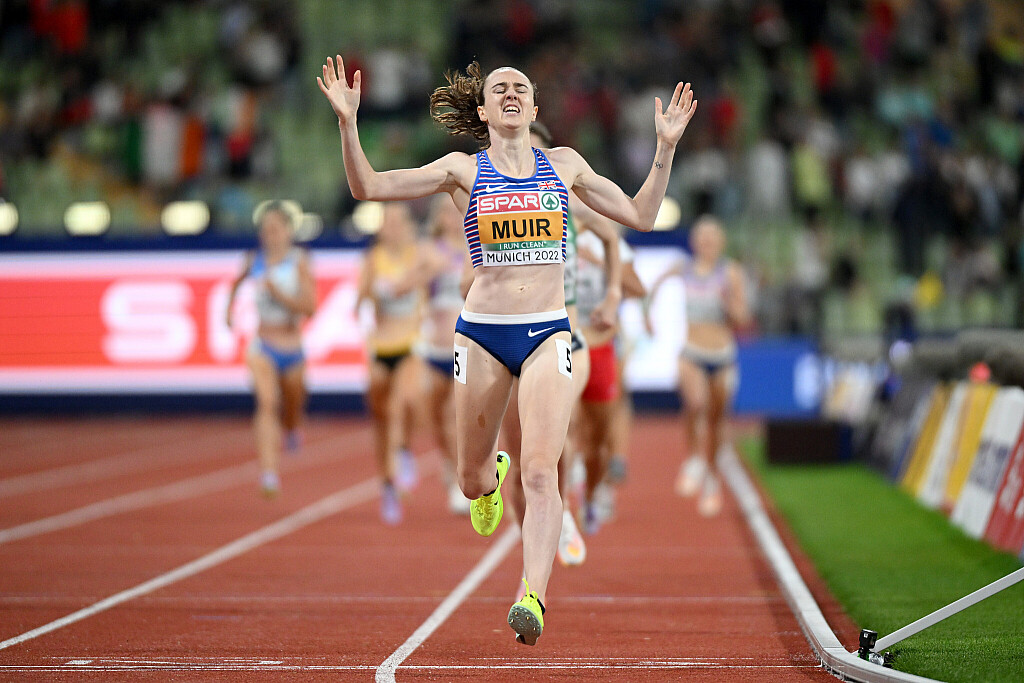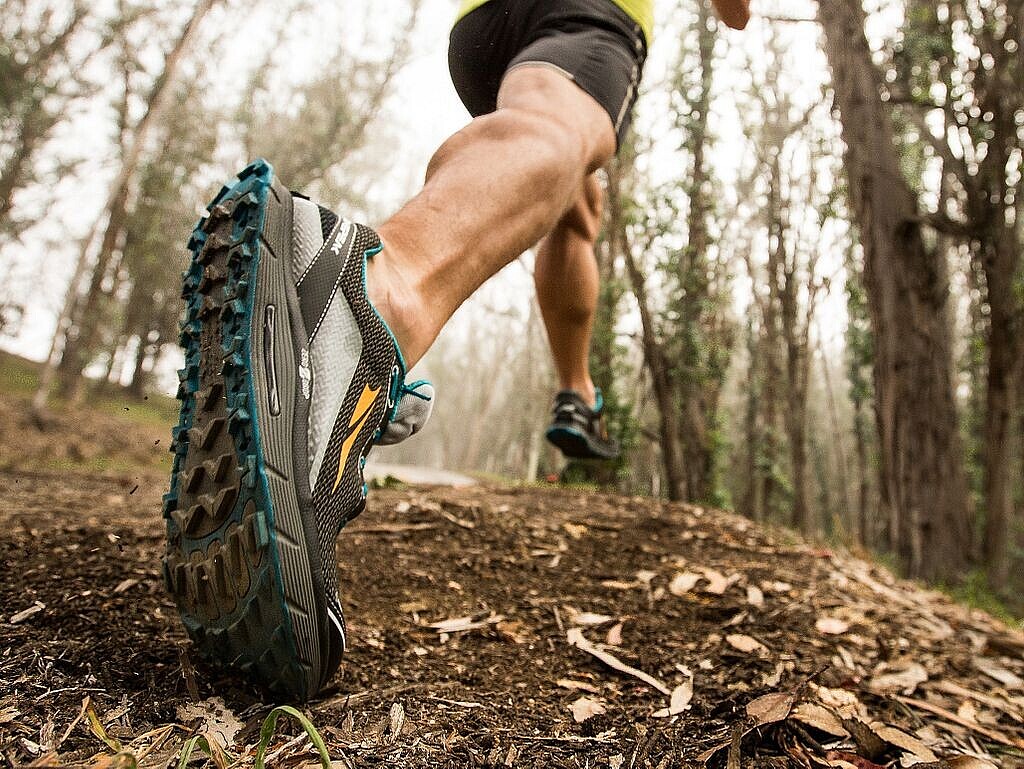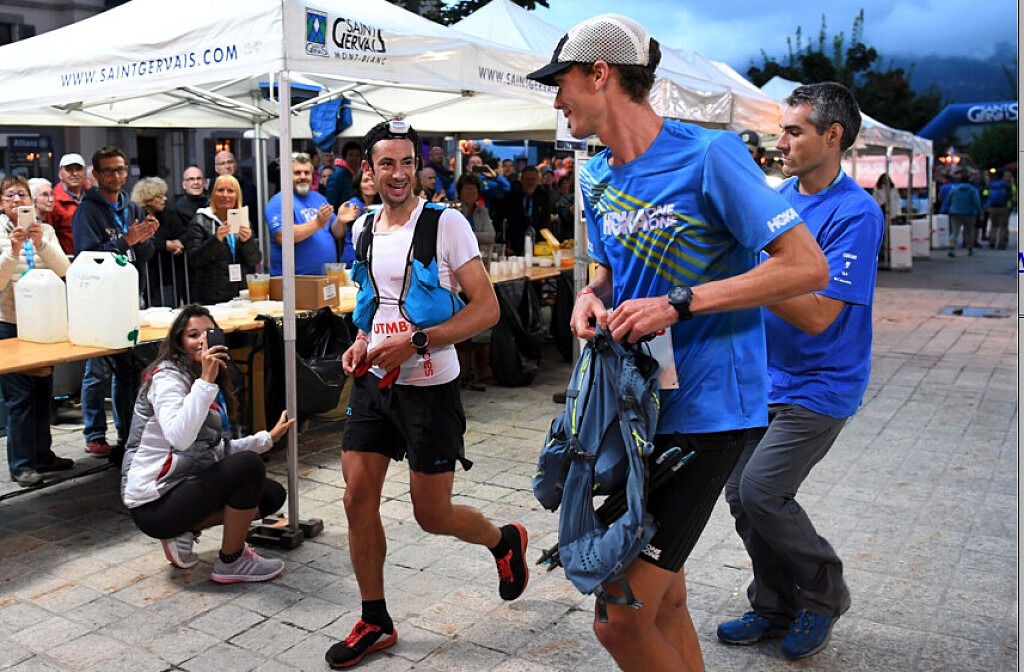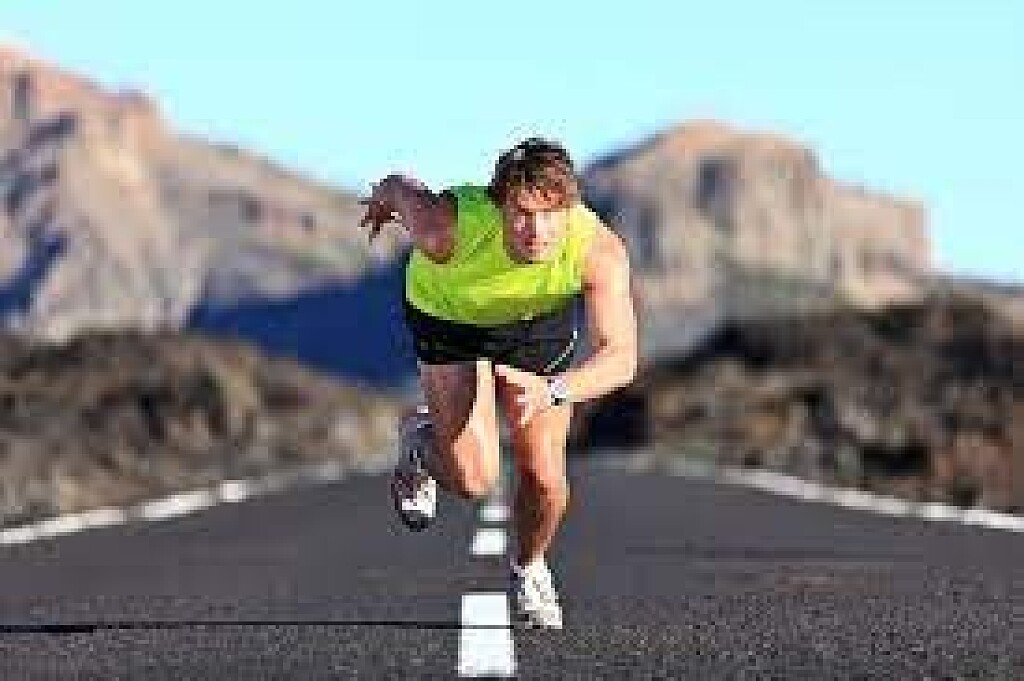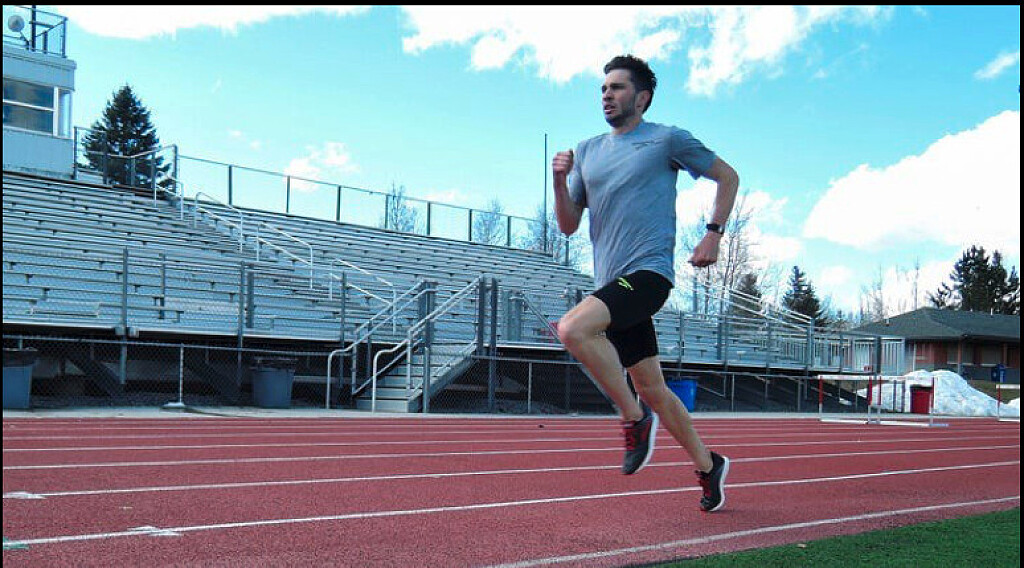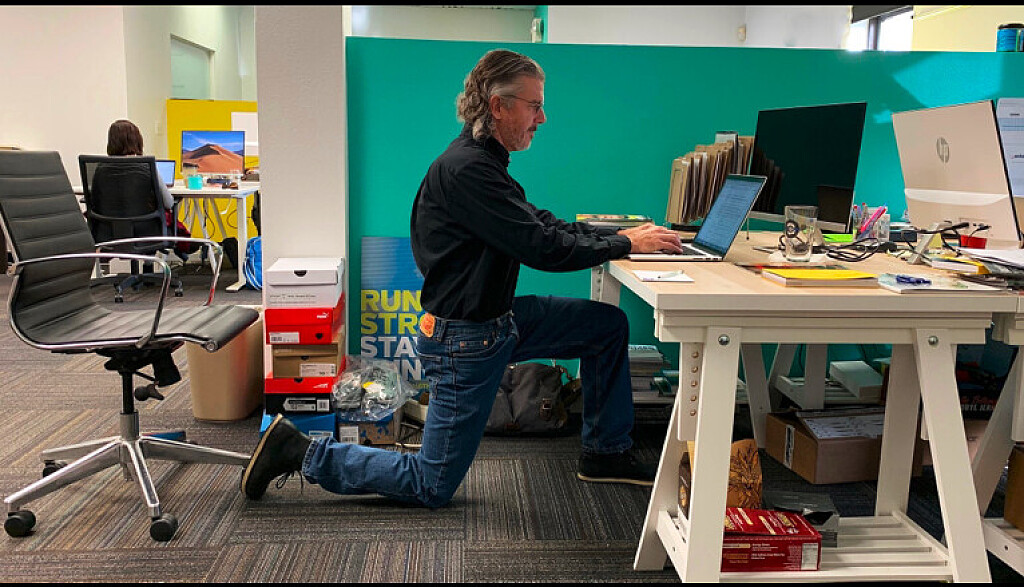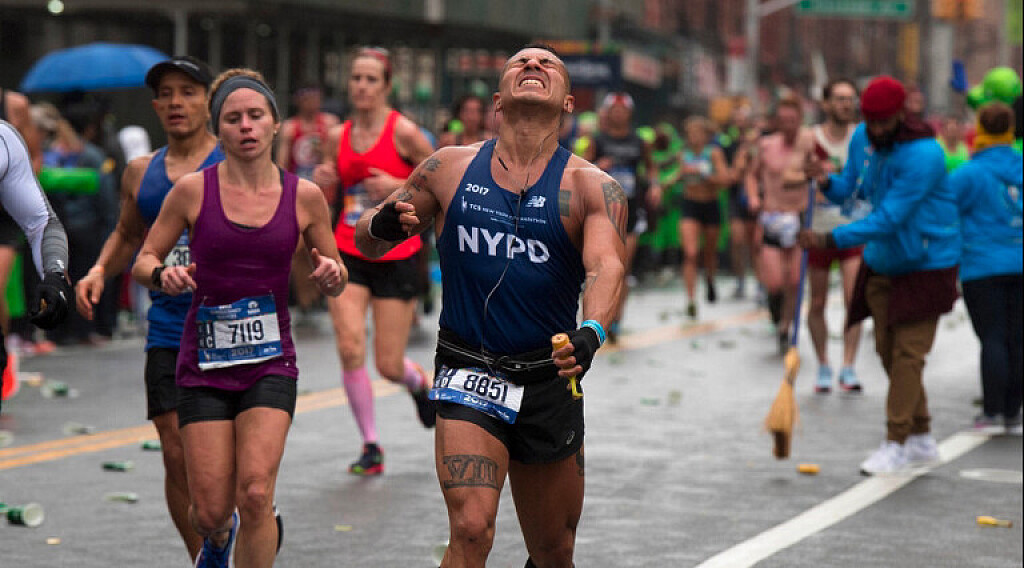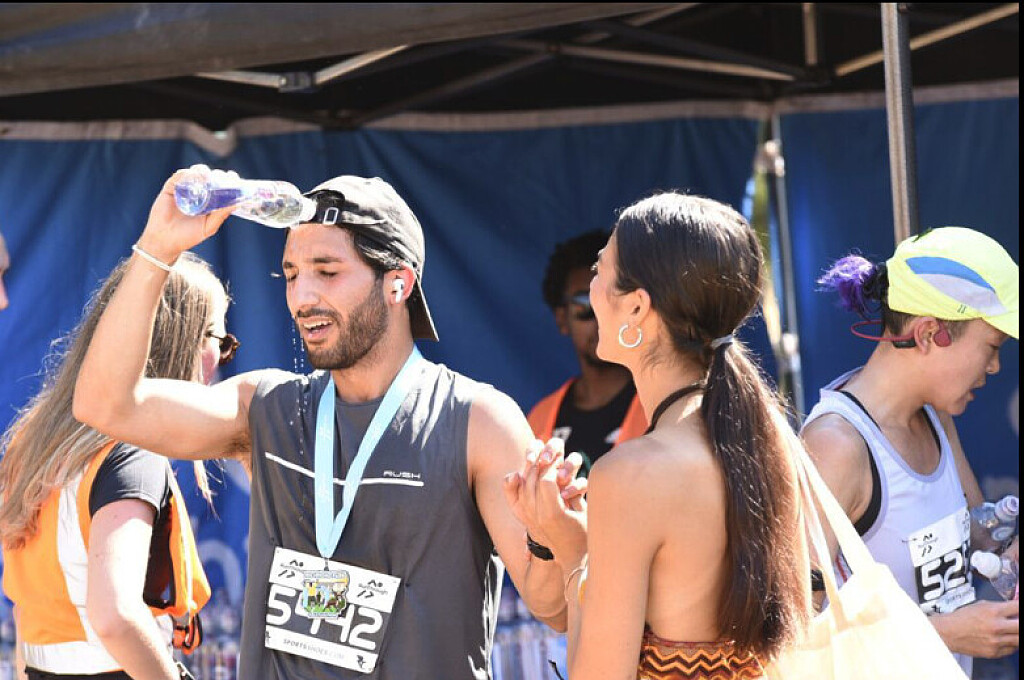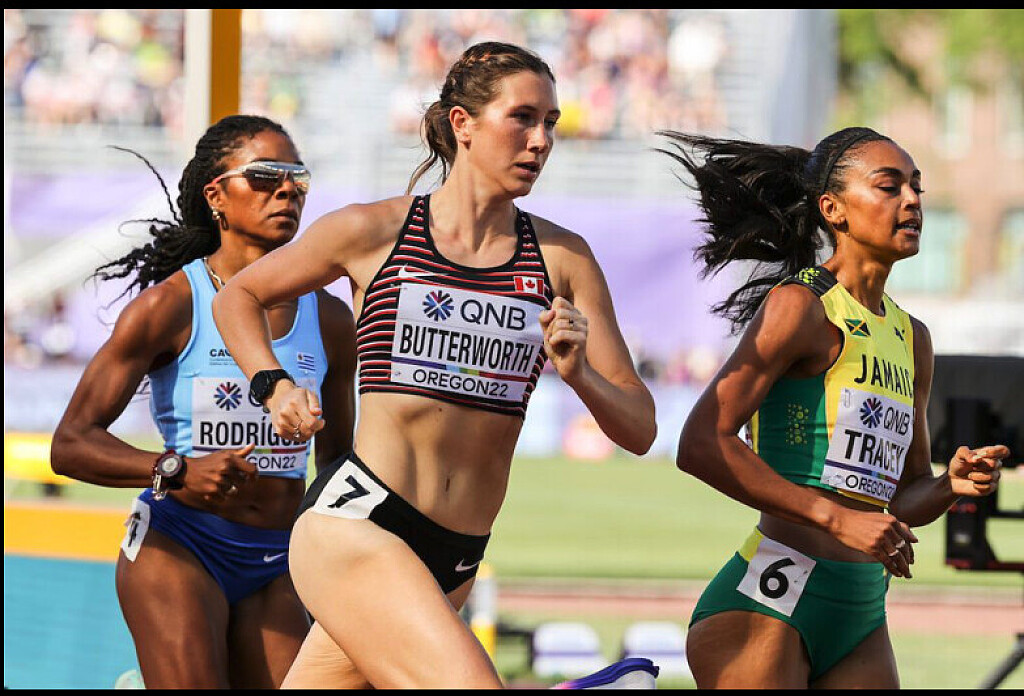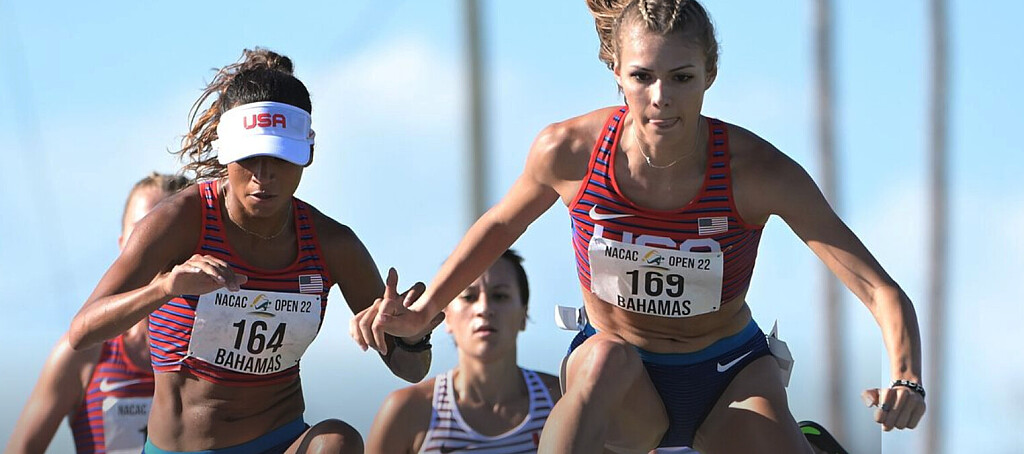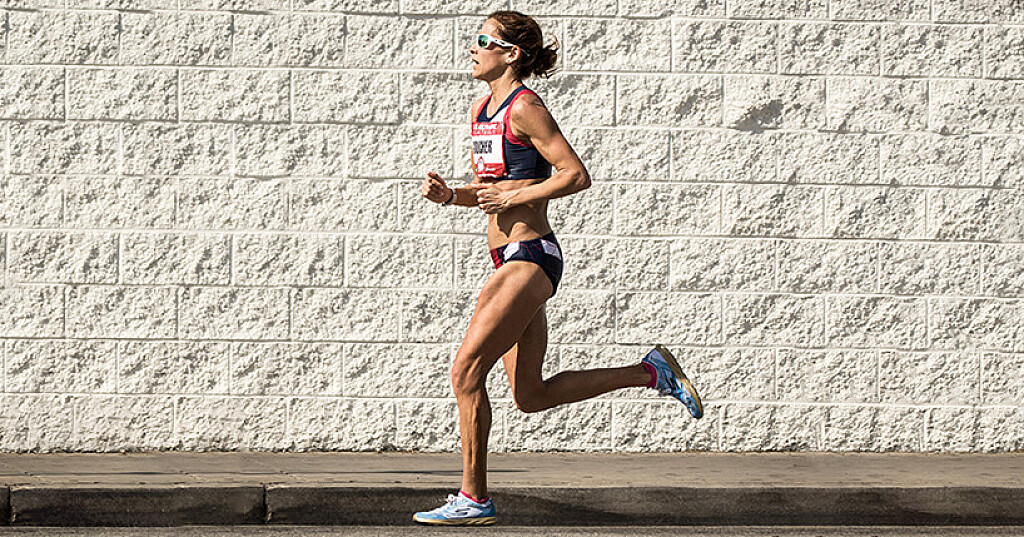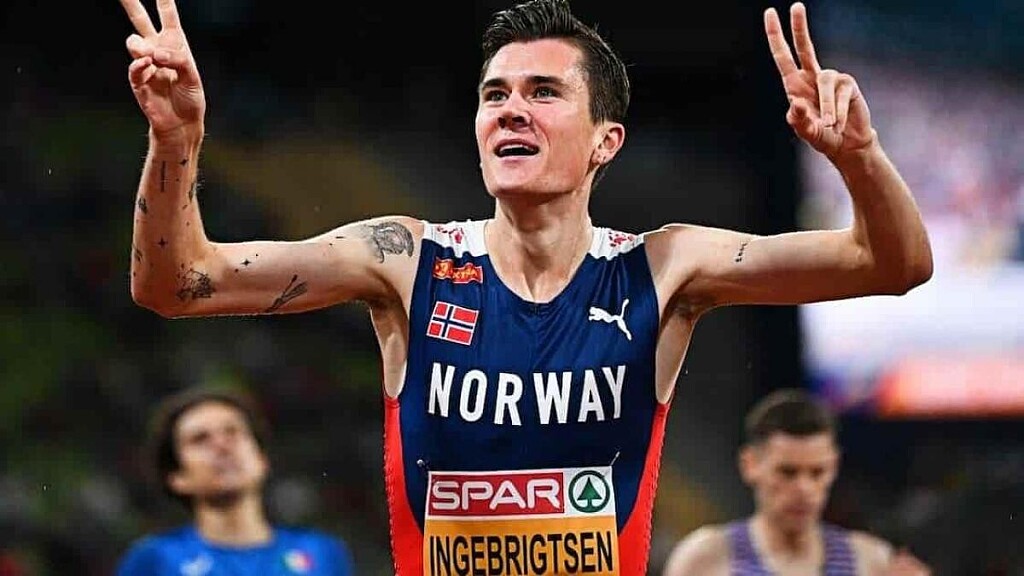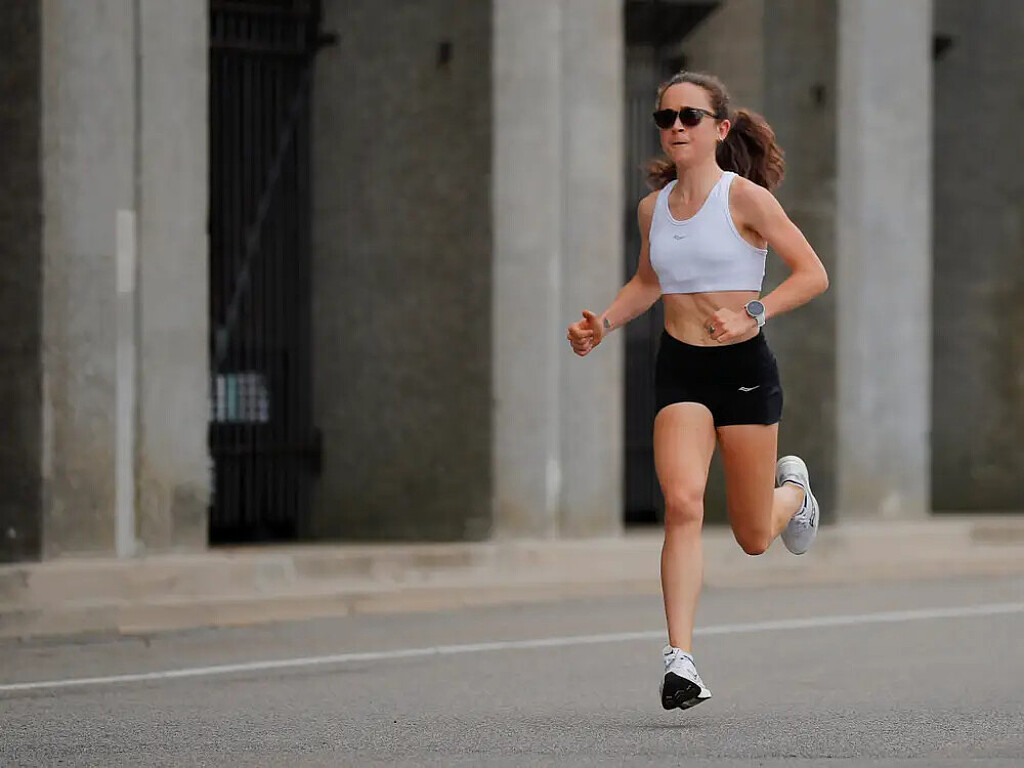Running News Daily
Running News Daily is edited by Bob Anderson in Mountain View, California USA and team in Thika Kenya, La Piedad Mexico, Bend Oregon, Chandler Arizona and Monforte da Beira Portugal. Send your news items to bob@mybestruns.com Advertising opportunities available. Over one million readers and growing. Train the Kenyan Way at KATA Running Retreat Kenya. (Kenyan Athletics Training Academy) in Thika Kenya. Opening in june 2024 KATA Running retreat Portugal. Learn more about Bob Anderson, MBR publisher and KATA director/owner, take a look at A Long Run the movie covering Bob's 50 race challenge.
Index to Daily Posts · Sign Up For Updates · Run The World Feed
How Dani Moreno Became the First-Ever American Woman to Podium at the OCC Race at UTMB
"How far is the podium?!" Dani Moreno yelled to her French friend as she crested a high point in the race at this week's hyper-competitive OCC race, based in Chamonix, France.
"Too far!" her friend responded.

He would later regret saying that. Why? Because 6 hours and 17 minutes after starting, Dani Moreno, 30, from the Mammoth Lakes, California, secured her spot on the podium to finish in third place, the first-ever American woman to reach this level at OCC.
The OCC (Orsieres-Champex-Chamonix) race is a 56km (35 mile) option with 3500 m (11,500 feet) of elevation gain. Unlike the UTMB 100-mile race that circumnavigates Mount Blanc, starting and finishing in Chamonix, France, the OCC option begins in Switzerland and stays in the Valais region, until the finish, where it drops into the Chamonix valley. Winners expect to arrive at the finish in under six hours, while the cutoff is 14 hours, 30 minutes.
Weeks prior to OCC, Moreno experienced an unusually difficult race at Sierre-Zinal, in Switzerland. Before the race, she lost someone close to her back at home and a funeral service was the week of the race. She thinks the emotion caught up with her.
"I went into that race realizing I hadn't fully grieved," said Moreno. "I didn't represent myself and all this work I'd done." But after overwhelming support from friends and family, she recalibrated for OCC and showed up ready to compete. Her fiance traveled to Chamonix to help crew, along with a couple of friends.
Early in the race, Moreno would pass competitors on the ups and get passed on the downs, and yet she kept saying to herself: trust, trust, trust. Trusting in her strengths and pacing was critical, and it paid off halfway into the race.
"I passed five girls and moved into fourth at the halfway point," she said. "I could see the third-place woman but didn't know what was happening in front of them. Then third place and I were battling it out."
"You are As Strong As You Think You Are"
Moreno's secret weapon? Having fun-no matter what.
"It was fun the whole time," said Moreno. "Well, maybe the last downhill was agonizing because I was really trying to see if I could catch second place." She would make airplane arms, pretending to fly, while high-fiving spectators, always with a smile. "It felt like a fun day out with my friends."
Before the last descent, she received a huge boost after seeing her ultrarunning hero, Ruth Croft, who offered her words of encouragement. And at one of the last spots along the course, she remembers her fiance yelling to her: "You are as strong as you think you are!"
"Those last 90 minutes I sort of blacked out," said Moreno, digging deep to try and catch up to the second place woman. A few hundred yards from the finishing chute, she knew she'd done it, and the joy of her last few hundred yards was palpable. "It was a lot. First, I was like, I did it, but then I was like we did it. My coach, my family, everyone that believed in me."
Moreno finished in 6 hours and 17 minutes, only 7 minutes off the winning woman, Sheila Aviles, from Spain. The second-place woman, Nria Gil, finished only one minute ahead. Other American women in the top ten were Kimber Maddox (4th) and Allie McLaughlin (6th).
Running As Expression, Running As Order.
Dani Moreno moved to the eastern slope of California's Sierra Nevada Mountains after living and attending university at UCSB, where she ran cross country. Moreno is a four-time member of Team USA and a two-time USA champion. In addition to competing at the highest levels of the sport, Moreno maintains a full-time job at a construction firm, working in mergers and acquisitions.
"First, I was like, I did it, but then I was like we did it."
OCC was the longest race-both time and distance-that Moreno had ever pursued. But on her website, she writes that her goal is "to solidify myself as one of the best mountain runners in the world at the sub-ultra-distances." Refreshingly, she appears content with fine-tuning her performances in shorter trail races. So often in this sport, athletes feel pressure to level up to increasingly longer distances. For the next couple years, Moreno hopes to focus on marathon trail distances. However, more ultras are very much on the horizon.
"My plan is to do a 100K in the next year and a half, nestled between other shorter races, and keep inching my way up," she said. Moreno mentioned not wanting to do the CCC yet, the 101K option at UTMB. Yet.
"I'd like to do OCC again, and go about a little more aggressively this time." She plans to finish the Golden Trail Series, too, which she did last year.
Want to Run a UTMB Race? Here are Moreno's Three Rules:
Respect the weather. The weather in this dramatic region can change in an instant. Be ready for anything. "Practicing with your equipment is key," she says.
Learn how to move and fuel. Moreno is strict about practicing eating and drinking while training. During her OCC race she mixed up sports drinks and foods, things she was familiar with. The best place to learn what works-and what doesn't-is during training. "It's okay to fail during training," she said. Better to fail in training than in a race.
Be prepared for undulations. Constant ups and downs. "The undulations. Sometimes in the U.S. we tend to only go up and then down, and that's it. Here, there are multiple [big] ups and downs."
Beyond the competition, Moreno seeks trails not only as an elite athlete, but as a way of becoming a whole person, of building order and resiliency into her life.
"It helps me get through a lot of stuff," said Moreno. "It helps me organize and compartmentalize stuff in my life. Sometimes in life I can get overwhelmed by my emotions, Running provides important guidelines for that."
(08/28/2022) ⚡AMPNorth Face Ultra Trail du Tour du Mont-Blanc
Mountain race, with numerous passages in high altitude (>2500m), in difficult weather conditions (night, wind, cold, rain or snow), that needs a very good training, adapted equipment and a real capacity of personal autonomy. It is 6:00pm and we are more or less 2300 people sharing the same dream carefully prepared over many months. Despite the incredible difficulty, we feel...
more...U.K.'s 'Forrest Gump' runs across Ireland in under 24 hours
British marathoner and podcast host Robert Pope, 44, downed a pint of Guinness in Galway City, Ireland, and hit the road. The Liverpool native ran the 213 km trek to Dublin, the capital city, in a record-setting 23 hours, 39 minutes (pending verification). Upon arrival, Pope had his post-run beverage of choice: another Guinness.
Pope made the decision to attempt the feat only two months earlier and told the BBC that, while he had originally planned to follow an eight-week training regime, the Glastonbury music festival got in the way. “I was also working, so it was probably just five weeks of ‘yeah, I’m happy with that’ training,” said Pope.Pope dedicated his run to raising funds for the World Wildlife Foundation (WWF) and well surpassed his goal of $3,100.

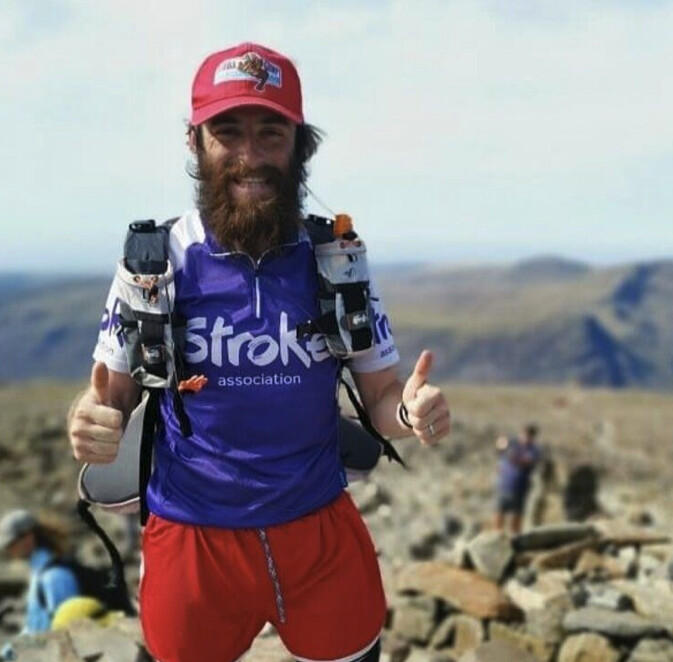
The athlete posted about his effort on social media, his ever-present sense of humour apparent throughout: “People have asked why I want to do this and, like Forrest, they’re asking if I’m running for world peace, the homeless, women’s rights, the environment or animals. Well, I’ll take any opportunity I can to tell you to PLEASE go and check out the work of the WWF and Peace Direct and see how you can help, but this is more the classic answer: #justfeltlikerunning.”
Pope had promoted his run under the hashtag #EdgetoEdge to celebrate U2 guitarist the Edge’s birthday, so, over the course of his run, he listened to the band’s entire catalogue in chronological order.This adventure was far from Pope’s first unique personal challenge. In 2016, he ran the length of America five times, following the route of the fictional movie character Forrest Gump.
He covered 25,140 kilometres in 422 days, and wrote a ‘love letter to America’ about the adventure called Becoming Forrest.Pope is a renowned marathoner, with a marathon PB of 2:27:13 from the 2016 Liverpool Rock’n’Roll Marathon.
He holds the Guinness World Record for the fastest marathon dressed as a film character, set for running the 2018 London Marathon in 2:36:28 (finishing 82 overall) while dressed as–who else? Forrest Gump.
“Maybe seeing me win, lose, or draw will inspire you to do something, to challenge yourself, or make a difference. Just remember and this is the most important point of this run – it’s giving it your best that counts, not whether you impress others, or present the perfect image,” Pope said.“Take pride in the struggle, you’re ace, you are,” he added.
(08/28/2022) ⚡AMPby Running Magazine
2022 UTMB Women’s Race
An American living in France and eighth-place finisher at UTMB in 2021, Katie Schide set out to make her mark on the race from the beginning, leading the women’s field after seven kilometers into Les Houches while being trailed closely by the trio of Marianne Hogan from Canada, Kaytlyn Gerbinfrom the USA, and Hillary Allen from the USA.
Schide grew the gap over the next 13 kilometers into Saint-Gervais. With only one hour and 48 minutes on the race clock, a truly raw opening effort, her lead over second place Hogan was already five minutes, and she had eight minutes on third place Audrey Tanguy (pre-race interview) of France. Jocelyne Pauly and Manon Bohard, both from France also, came through in fourth and fifth with Mimmi Kotka (pre-race interview), a Swede living in Chamonix, just behind them in sixth.
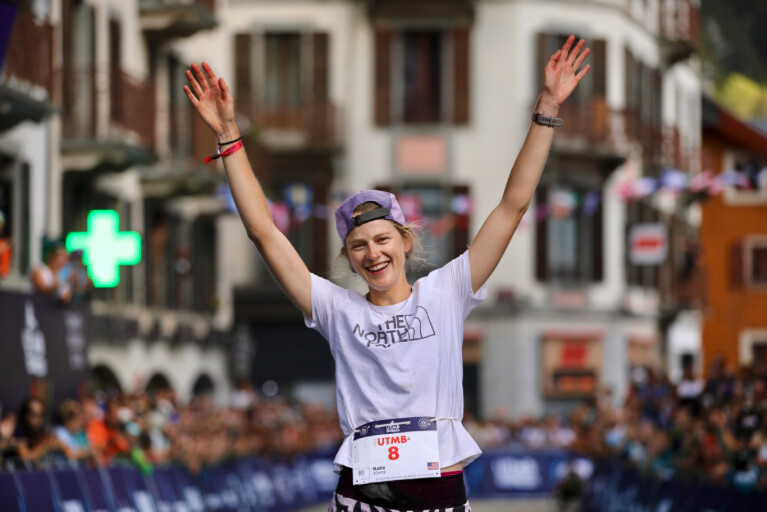

Fu-Zhao Xiang (pre-race interview) of China, Ragna Debats (pre-race interview), who is Dutch but lives in Spain, and Azara García (pre-race interview) of Spain rounded out the top 10, running together 13 minutes behind Schide.Keeping up her consistent and strong pace, Schide continued to increase her lead on the rest of the women’s field, coming into Les Contamines at 31 kilometers with 2:50 on the race clock.
By then, she’d extended her lead on Hogan to over nine minutes, Tanguy to 12 minutes, and Bohard and Pauly to 15 minutes. Tanguy was probably relieved to make it past Les Contamines where she had dropped last year from severe stomach cramps. A visibility limping Kotka, who had challenged Courtney Dauwalter during last year’s UTMB during the early miles of the race before finishing third as Dauwalter won, came into Les Contamines nearly 20 minutes off the lead in sixth and would not continue.
Schide continued to smile coming through the Col du Bonhomme, at about a marathon’s distance into the race, clearly enjoying her run through the night and appreciating the cheers of the spectators. Climbing one of the largest passes of the race only seemed to make her stronger. Her gap to Hogan and Tanguy had grown to about 20 minutes as the two chasers crested the col.
The cheers from the enthusiastic French crowd brought smiles to both women’s faces as they passed through. The cheers continued for Bohard and Pauly, who were still running together.
The crowd at Les Chapieux, 50 kilometers in, was enthused to see Schide, erupting in huge cheers as she came in. While the gaps between the women in second through 10th grew and shrunk over the kilometers, Schide’s gap on the field had only gone one direction so far: up. She was now more than 22 minutes up on second place Hogan. By the time Schide got to Lac Combal, 66 kilometers into the race, the gap was up to 25 minutes, and it would be an additional 20 minutes for Tanguy to arrive after that.With 80 kilometers run, Schide came into Courmayeur flying, spending only eight minutes at the aid station approximately halfway into the race.
The crowds were thrilled to see her, providing a warm and raucous welcome as she ran into the aid station looking smooth. But for the first time in the race thus far, Hogan had started to close the gap to the leader, whittling it down to just over 20 minutes. Smiling but with a stomach that couldn’t handle gels any more, she quickly drank a Coke and opted for pizza for fuel. The gap between the top two women and the rest of the field continued to grow, and it was over an hour before Tanguy, Pauly, and Gerbin ran through, and a few more minutes after them to the sixth woman, Emily Hawgood, of Zimbabwe, who lives in the USA.
While Schide had seemed unstoppable before Courmayeur, the tables seemed to turn over the next 17 kilometers to Arnouvaz as night turned to day. Schide came in with stomach issues, clearly in a rough spot, with Hogan hot on her heels, now only two minutes behind. Closing a gap of more than 18 minutes is a feat to be acknowledged, and a feisty and strong Hogan seemed energized by the coming of the day and the idea of leading the race for the first time.
A struggling Schide maintained her lead over the Grand Col Ferret at 102 kilometers, but it was down to a minute, and when the women’s leader arrived at La Fouly at 112 kilometers, it was Hogan instead of Schide for the first time, with a sizable six-minute gap.
By Champex-Lac at 125 kilometers, it was still Hogan in the lead and well under course record pace, now with a 10-minute gap to second. But Schide wasn’t about to give up, slowing down to let her stomach recover from its previous rough spell, and finally eating a cheese sandwich and starting to move well again.
One hundred miles is a long distance to race, long enough that runners can get through rough spells and rebound. And that’s exactly what Schide did, regaining the lead in Trient at kilometer 142, not only eliminating the 10-minute gap but putting an additional 10 minutes on Hogan. By Vallorcine at 153 kilometers, the gap between the top two was up to 41 minutes, with Hogan nursing a hurt left leg.
By the time the pair reached the finish line in Chamonix, they maintained their one-two position with Schide having extended the gap to some 75 minutes.It was another 35 minutes later that we saw the final member of the women’s podium arrive, Gerbin, who ran for much of the second half of the race in what she described as “no woman’s land,” well in front of those behind her but out of contact with the lead.
It was apparently a comfortable spot for her, though, as she held her position strongly, and crossed the finish line back in Chamonix like she could run plenty more kilometers if needed.
Pauly finished fourth, the successful conclusion of a focused day of racing. Eszter Csillag, who is from Hungary but lives in Hong Kong, moved up later on to take fifth. Emily Hawgood ran strong all day to set and maintain a very similar position of sixth place. Xiang held tight to seventh place with Spain’s Aroa Sio just behind in eighth. Italy’s Francesca Pretto and Eva-Maria Sperger of Germany moved up into the top 10 in the last 50 kilometers.
(08/28/2022) ⚡AMP
2022 UTMB Men’s Race
As expected, the men took the race out fast from the start on the relatively flat roads and trails from Chamonix to the village of Les Houches. Spain’s Pau Capell, the 2019 UTMB winner, led a charging group through Les Houches, seven kilometers into the race, followed closely by Mathieu Blanchard, a Frenchman living in Canada, and Jia-Ju Zhao and Guo-Min Deng, both of China. All the top contenders were in a massive chase pack, settling in for the long night and day ahead.
It didn’t take long for Jim Walmsley (pre-race interview) of the USA to make his intentions for this year’s race clear, coming into Saint-Gervais, at 20 kilometers into the race, in the lead, looking strong and relaxed. Kilian Jornet and Capell were just seconds behind with Deng, Zhao, and American Zach Miller making up a chase group half a minute in arrears. They were followed by Frenchman Germain Grangier, Blanchard, Frenchman Thibaut Garrivier, and Yan-Qiao Yun of China.

Unsurprisingly, by Les Contamines, 31 kilometers into the race, it was shaping up to be a showdown between Walmsley and Jornet. They came into the aid station together looking relaxed, Walmsley taking the time to high-five fans, and were shortly on their way into the night together. Capell and Miller came in just 30 seconds back, and Grangier rounded out the top five, just a minute behind them.
A notable withdrawal around this time due to physical issues is last year’s second place finisher, Frenchman Aurélien Dunand-Pallaz (pre-race interview).
Climbing over the high Col du Bonhomme, 43 kilometers in, Walmsley, Miller, Jornet, and Tom Evans (pre-race interview) of the U.K. shared the lead. With 1,160 meters (3,800 feet) of climbing down just on this one climb, everyone in the group looked relaxed and was moving well. Capell was just 90 seconds back, trying not to let the elastic to the front group snap in the dark of the night on the run over to Col du Bonhomme before the long descent into the remote French outpost of Les Chapieux.
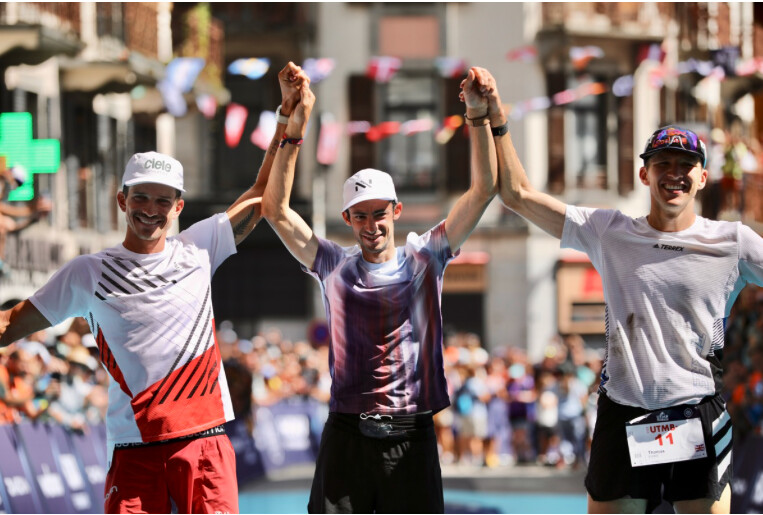
The four leaders stayed together down to Les Chapieux, 50 kilometers into the race, where last year’s winner, François D’Haene — not participating this year — was spectating and cheering on runners. Unfortunately, Capell had lost contact with the lead group over the previous section, coming into the aid station more than two minutes back. The rest of the top nine stayed relatively the same with Erik Sorenson of the USA slotting in 10th for the first time.Coming into Lac Combal, 66 kilometers into the race, after crossing country borders into Italy and traversing the most remote part of the course, Walmsley and Jornet had only slightly pulled away, their gap to Miller and Evans hung at a tenuous minute. All four looked strong, but it seemed like pre-race predictions of a two-man showdown were about to be realized.
Walmsley, with his arms and legs fully covered from the cold of the night but shirt front open, came into the town of Courmayeur, 80 kilometers in, solo and in the lead, but his gap on Jornet just 80 seconds.
Both men were moving well and left the aid station together after only a few minutes. It was a significant 12 minutes before Evans and Miller came through, staying in Courmayeur for under three minutes. Blanchard, looking more relaxed than any of the previous four, was also in and out of the aid station quickly, 18 minutes off the lead. Known for his slower starts and late race surges, Blanchard appeared to know exactly what he was doing.
It was never a question of if Walmsley or Jornet would strike out on their own, it was just a matter of when. Walmsley was the first to throw down a serious acceleration, coming into Arnouvaz (97 kilometers) solo and with a 2.5-minute gap on Jornet. Both were in and out of the aid station quickly, looking strong and motivated. Blanchard also chose the trail between Courmayeur and Arnouvaz to make his move, coming into the Arnouvaz aid station in third, looking very controlled and 14 minutes behind the leaders.
He was familiar with that position in the race, having finished third in UTMB in 2021. He was also familiar with the race tactic of starting slower, letting the leaders fight it out early and tire themselves out, and then moving up as the fast starters dropped back. It had brought him success the previous year, and he was seemingly employing the strategy again. Miller and Evans continued to run near each other, what Evans would later refer to as a “bromance” that lasted over half the race, and both looked like they had less spring in their step than the men ahead of them.
Committed to making the move stick, Walmsley climbed the Grand Col Ferret at 102 kilometers with a strong powerhike and held a five-minute gap over Jornet. Seemingly unconcerned with his position, Jornet chatted in French with both spectators and volunteers before vanishing into the night. Moving faster and looking stronger over the col than the previous two men, Blanchard continued the chase in third 17 minutes back. Miller and Evans continued to work together to keep the gap manageable.
The gap between Walmsley and Jornet stretched even further to 14 minutes by the sleepy Swiss village of La Fouly, 112 kilometers into the race. Both men were running under course-record pace, and both looked calm and collected. Still running strong into La Fouly, Blanchard kept the leaders within reach.
But Walmsley was committed to stretching the elastic on the field as much as he could, coming through Champex-Lac at 125 kilometers with 13 hours and 40 minutes on the race clock, gaining even more time on the course record and moving strongly. It’s generally a bad idea to bet against Walmsley after he’s put his mind to something, and after a fifth place finish in 2017 and DNF in 2018 and 2021 at UTMB, his commitment to the race and move to Europe to train on the trails seemed to be paying off.
But Walmsley is also known for going out fast and strong, and it doesn’t always stick.One could argue that Jornet was just biding his time, letting Walmsley burn his matches out front. However, there were times around this point in the race where Jornet just plain looked like he was working, enough so that we all began to wonder if the GOAT of trail running would have a crack in his armor today. However, by Trient at 142 kilometers, Jornet had decided to make his move, coming into the aid station in the lead. But instead of seeing Walmsley behind him, it was a surging Blanchard, less than a minute back that Jornet would have to now battle.
It was a long 19 minutes before Walmsley would arrive, appearing to be in discomfort. The dynamic duo of Evans and Miller continued to run together, still holding the gap to the race leader at just over 30 minutes, as they had for much of the race.As the kilometers ticked down, it was indeed a showdown between two men, except it was Blanchard challenging Jornet, with both men coming into Vallorcine at 153 kilometers together, well ahead of the course-record pace.
With Walmsley slowly losing time to the leaders but still in third, eyes moved to Evans who’d finally dropped Miller after nearly a night and a day of racing side by side to see if he could make the pass.By this time, it felt nearly inevitable that Jornet would run to the win and it was no surprise when he came into Tete aux Vents solo looking focused and fast with an 11-kilometer downhill run to the finish. Blanchard never gave up the chase, seven minutes back, while Evans passed a tired but “pumped” Walmsley to slot into third for the first time.
Jornet would finish with a course-record time of 19:49:30, besting both François D’Haene’s 2014 record time (20:11:44) on a course which did not include the Pyramides Calcaires, a gnarly little climb and descent added to the UTMB course a few years back, and Capell’s 2019 time (20:19:09), which did include those extra kilometers.
This is his fourth win at UTMB. Just five minutes back, Blanchard would also come into the finishing chute under the previous course record in second place. An elated Evans rounded out the podium, a stellar finish for his first UTMB.
Walmsley came across the line in fourth, releasing the two DNF monkeys on his back and finishing the next step in his goal of ultimately winning this race someday. Miller, no longer on the comeback trail following surgery and recovery, but fully back, crossed the line in fifth place.
Most of the back half of the men’s top 10 are runners who started slower and bided their time, moving up in the race’s second half, including France’s Beñat Marmissolle, France’s Arthur Joyeux-Bouillon,Jonas Russi of Switzerland, and Romania’s Robert Hajnal. The final member of the men’s top 10, however, is France’s Thibaut Garrivier, who went out hot and looked like he paid for it later, but ultimately holding onto 10th place.
(08/28/2022) ⚡AMPNorth Face Ultra Trail du Tour du Mont-Blanc
Mountain race, with numerous passages in high altitude (>2500m), in difficult weather conditions (night, wind, cold, rain or snow), that needs a very good training, adapted equipment and a real capacity of personal autonomy. It is 6:00pm and we are more or less 2300 people sharing the same dream carefully prepared over many months. Despite the incredible difficulty, we feel...
more...ADHD and runners: can diet help with management?
As a sports nutritionist, I commonly counsel runners and other athletes who have Attention Deficit Hyperactivity Disorder—generally referred to as ADHD (or ADD). ADHD is characterized by hyperactivity, impulsivity, and/or inattention. It affects 4-10% of all American children and an estimated 4.4% of adults (ages 18-44 years). ADHD usually peaks when kids are 7 or 8 years old. Some of the ADHD symptoms diminish with maturation but 65-85% of the kids with AHDH go on to become adults with ADHD.
Ideally, runners with ADHD get the help they need to learn how to manage their time and impulsiveness. Unfortunately, many youth athletes with ADHD just receive a lot of negative feedback because they have difficulty learning rules and strategies. This frustrates teammates and coaches. Older athletes with ADHD often run to reduce their excess energy, calm their anxiety, and help them focus on the task at hand. This article offers nutrition suggestions that might help coaches, friends, and parents, as well as runners with ADHD, learn how to calm the annoying ADHD behaviors.

• To date, no clear scientific evidence indicates ADHD is caused by diet, and no specific dietary regime has been identified that resolves ADHD. High quality ADHD research is hard to do because the added attention given to research subjects with ADHD (as opposed to the special diet) can encourage positive behavior changes. But we do know that when & what a person eats plays a significant role in ADHD management and is an important complimentary treatment in combination with medication.
• ADHD treatment commonly includes medications such as Concerta, Ritalin & Adderall. These medications may enhance sports performance by improving concentration, creating a sense of euphoria, and decreasing pain. These meds are banned by the World Anti-Doping Agency (WADA) and the International Olympic Committee (IOC). Hence, runners who hope to compete at a high level are discouraged from taking ADHD medications

• To the detriment of ADHD runners, their meds quickly blunt the appetite. Hence, they (like all athletes) should eat a good breakfast before taking the medication.
• The medication-induced lack of appetite can thwart the scrawny teen runner who wants to gain weight and add muscle. Teens should be followed by their pediatricians, to be sure they stay on their expected growth path. If they fall behind, they could meet with a registered dietitian (RD) with knowledge of sports nutritionist (CSSD) to help them reach their weight goals.
• An easy way for “too thin” runners to boost calories is to swap water for milk (apart from during exercise). The ADHD athlete who does not feel hungry might find it easier to drink a beverage with calories than eat solid food. Milk (or milk-based protein shake or fruit smoothie) provides the fluid the athlete needs for hydration and simultaneously offers protein to help build muscles and stabilize blood glucose.
• A well-balanced diet is important for all runners, including those with ADHD. Everyone’s brain and body need nutrients to function well. No amount of vitamin pills can compensate for a lousy diet. Minimizing excess sugar, food additives, and artificial food dyes is good for everyone.
• Eating on a regular schedule is very important. All too often, high school runners with ADHD fall into the trap of eating too little at breakfast and lunch (due to meds), and then try to perform well during afterschool sports. An underfed brain gets restless, inattentive, and is less able to make good decisions. This can really undermine an athlete’s sports career
• Adults with ADHD can also fall into the same pattern of under-fueling by day, “forgetting” to eat lunch, then by late afternoon are hangry and in starvation mode. We all know what happens when any runner gets too hungry – impulsiveness, sugar cravings, too many treats, and fewer quality calories. This is a bad cycle for anyone and everyone.
• All runners should eat at least every four hours. The body needs fuel, even if the ADHD meds curb the desire to eat. ADHD runners can set a timer: breakfast at 7:00, first lunch at 11:00, second lunch at 3:00 (renaming snack as second lunch leads to higher-quality food), dinner at 7:00.
•For high school runners with ADHD, the second lunch can be split into fueling up pre-practice and refueling afterwards. This reduces the risk of arriving home starving and looking for (ultra-processed) foods that are crunchy, salty, and/or sweet.
• (Adult) runners with ADHD are often picky eaters and tend to prefer unhealthy snacks. For guidance on how to manage picky eating, click here for adults and here for kids.
• Fiber-rich fruits, vegetables, and whole grains can be lacking on an ADHD runner’s food list. Their low fiber diet can lead to constipation. Fiber also feeds the zillions of microbes in their digestive tract that produce chemicals that can positively impact brain function and behavior. Everyone with ADHD should eat more fiber-rich foods like beans (hummus, refried beans in a burrito), seeds (chia, pumpkin, sunflower, sesame), and whole grains (oatmeal, brown rice, popcorn). They offer not only fiber but also magnesium, known to calm nerves.
• With more research, we’ll learn if omega-3 fish oil supplements help manage the symptoms of ADHD. At least, eat salmon, tuna, and oily fish as often as possible, preferably twice a week, if not more.
• Picky eaters who do not eat red meats, beans, or dark leafy greens can easily become iron deficient. Iron deficiency symptoms include interrupted sleep, fatigue, inattention, and poor learning and can aggravate ADHD. Iron deficiency is common among runners, especially females, and needs to be corrected with iron supplements.
• While sugar has the reputation of “ramping kids up”, the research is not conclusive about whether sugar itself triggers hyperactivity. The current thinking is the excitement of a party ramps kids up, more so than the sugary frosted cake. Yes, some runners are sugar-sensitive and know that sugar causes highs and crashes in their bodies. They should choose to limit their sugar intake and at least enjoy protein along with sweets, such as a glass of milk with the cookie, or eggs with a glazed donut. Moderation of sugar intake is likely more sustainable than elimination of all sugar-containing foods.
(08/27/2022) ⚡AMPby Colorado Runner
World lead for Jakob Ingebrigtsen in Lausanne
Olympic 1500m champion enjoys emphatic win at Diamond League on Friday as Noah Lyles, Jasmine Camacho-Quinn and Joe Kovacs also take victories in the Swiss city.
There were plenty of surprises at the Athletissima meeting in Lausanne on Friday (Aug 26) with world champions Ryan Crouser, Grant Holloway, Tobi Amusan and Mutaz Essa Barshim among those suffering end-of-season defeats. But there was no doubt about the winner in the men’s 1500m as Jakob Ingebrigtsen stormed to victory in a world-leading mark of 3:29.05.
Using his predictable yet effective tactics of taking the lead shortly after the pacemaker went through 800m in 1:51, the Norwegian built a small lead at the bell and held his advantage over the final lap as Abel Kipsang of Kenya battled his way into second in 3:29.93 and Stewart McSweyn of Australia showed a welcome return to form with 3:30.18 in third.
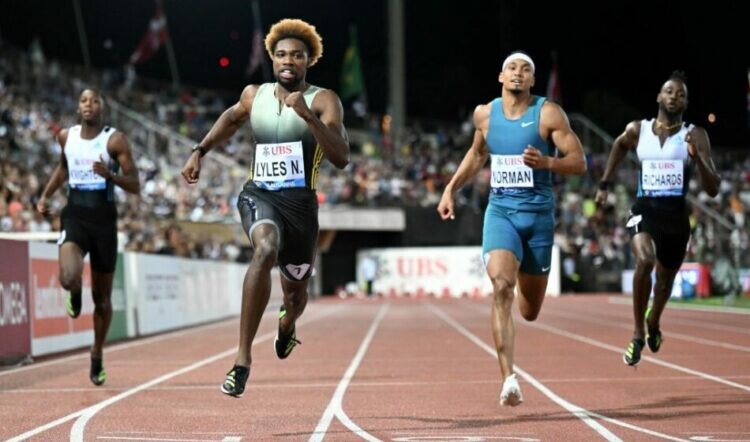
Josh Kerr bounced back from his dismal Commonwealth Games experience by finishing fourth in 3:32.28 with fellow Brits Jake Heyward (3:34.99) and Matt Stonier (3:35.57) ninth and tenth. Commonwealth champion Olli Hoare, meanwhile, faded badly on the last lap to finish 12th.
“It was a good race,” said Ingebrigtsen. “I would have liked to have gone a little faster but considering I’ve had a lot of races, it was good. I’m now looking forward to the races at the end of the season and running even faster next year.
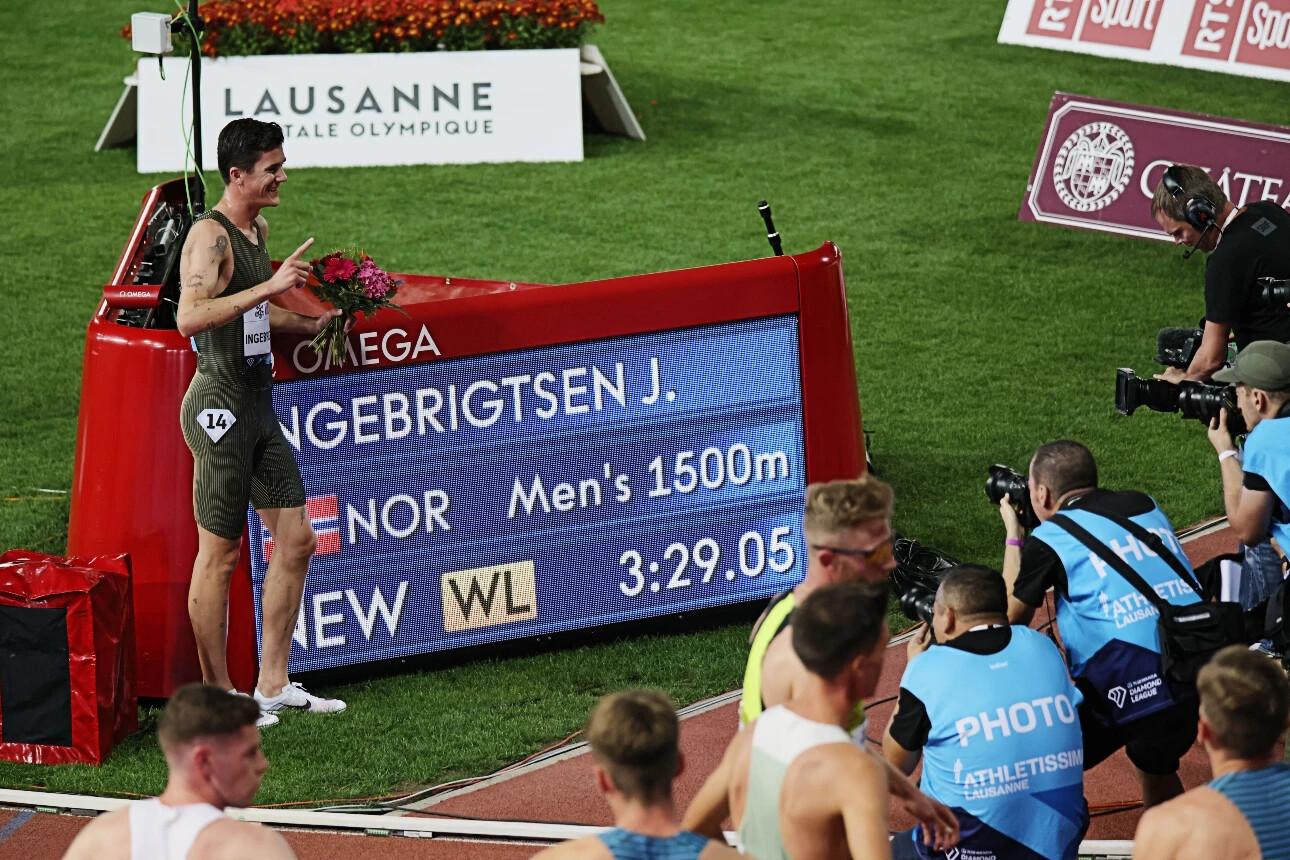
“All in all it’s been a good season but I’m ready to put in a lot of work this winter to win more races next summer. I don’t think we’re going to get any record times in Zurich (Diamond League final next month) but I think we will have a good competition there.”
Chilly conditions in Lausanne were not conducive to fast sprint times but Noah Lyles ran a quick 19.56 (1.3) despite a poor start. Mike Norman, who had led into the home straight, was runner-up in 19.76 as Britain’s Charlie Dobson, on his Diamond League debut, ran 20.34 in eighth from the inside lane.
The much-anticipated women’s 100m showdown turned into an anticlimax when firstly world champion Shelly-Ann Fraser-Pryce withdrew with a minor injury and then Elaine Thompson-Herah, the Olympic champion, false started. In their absence Aleia Hobbs won in 10.87 (0.0) from Shericka Jackson’s 10.88 and Marie-Josee Ta Lou’s 10.89.
(08/27/2022) ⚡AMPby Jason Henderson
Budapest 2023 World Athletics Championships schedule will favor double bids
Next year's World Athletics Championships in Budapest will last for nine days - one less than the last five editions of this event - and will favor athletes seeking double bids.
Popular doubles such as the 100m/200m, 800m/1500m, 1500m/5000m, 5000m/10,000m, 20km/35km race walk, women's long jump/triple jump and women's 200m/400m have all been made possible with athletes attempting them not having to contest more than one round in any given session.
The 2023 World Championships schedule - from August 19 to 27 - will involve 49 disciplines including six road events which will be spread across five separate mornings.
All track and field finals will be contested in the evening sessions, with at least four finals scheduled every day, even on the first day.

The final two days will feature eight medal events and both will end with women's relays.
And, as has been the case at recent major championships, the mixed and single-sex 4x400m finals are held either side of the individual one-lap disciplines to allow athletes to partake in both relays and individual disciplines should they so desire.
The first evening session will end with the mixed 4x400m final.

The men's 100m will be in the spotlight on the second day, while the women's 100m takes center stage on day three.
The women's 1500m will be one of four finals held on day four.
The men's 400m hurdles will conclude the action on day five.
Both 35km race walk finals will be held on the morning of day six and there will be no rest on the seventh day, as both 200m finals will conclude the evening session.
The women's marathon starts on the penultimate day, which will later include the men's pole vault and both 4x100m finals.
The men's marathon will be held on the morning of the final day and the championships will end with both 4x400m finals.
"The release of the timetable is a significant milestone for the World Athletics Championships Budapest 23, now less than a year away," World Athletics President Sebastian Coe said.
"After seeing the extraordinary crowds that descended on Birmingham for the Commonwealth Games and Munich for the European Championships in the last month, we know the appetite for our sport across Europe is as strong as ever and we're looking forward to taking our premier event to central Europe for the first time.
"Creating the timetable for an outdoor World Championships is a complex balancing act, taking into account the needs of athletes, broadcasters and the host city, as well as our other stakeholders.
"I’m confident that a return to a nine-day programme and evening-only finals in the stadium will be embraced by our athletes and audience in Budapest, and by those watching around the world."
Peter Deutsch, chief executive of the Budapest 2023 local organising committee, added: "We have created a schedule that best serves the interests of the athletes, including Hungarian athletes and the audience.
"There will be a lot of competitions late in the evening because that will be the right weather for the athletes.
"Every night there will be great excitement, there will be finals, and every night there will be Hungarians in the field for the home fans to cheer on.
"Our aim is for the World Championships to strengthen Hungarian athletics, to achieve the best results and to make this wonderful sport as popular as possible."
Tickets are due to go on sale in late 2022.
(08/27/2022) ⚡AMP
by Mike Rowbottom
World Athletics Championships Budapest 23
From August 19-27, 2023, Budapest will host the world's third largest sporting event, the World Athletics Championships. It is the largest sporting event in the history of Hungary, attended by athletes from more than 200 countries, whose news will reach more than one billion people. Athletics is the foundation of all sports. It represents strength, speed, dexterity and endurance, the...
more...South Africa’s Tete Dijana Storms to Victory in the 2022 Edition of Comrades Marathon
Tete Dijana won the Comrades Marathon from Pietermaritzburg to Durban ahead of his teammate Former champion Bongamusa Mthembu took fourth place and broke the Nedbank Running Club's dominance Nedbank Running Club had five athletes in the top 10 of the Comrades Marathon, including the top three
South Africa’s Tete Dijana has won the 2022 edition of the Comrades Marathon. The Nedbank runner stormed to victory, beating his teammate and defending champion, Edward Mothibi.

The duo were neck and neck with not too long to go before Dijana took control of the race and never looked back. Dijana, a security guard from the North West, finished the race in 5:30:38 while Mothibi finished in 5:33:46.
(08/27/2022) ⚡AMPBrazilian Runner Dies After Fall During UTMB Team Event
A Brazilian runner, 40, was fatally injured at the Petite Trotte à Léon, part of the UTMB ultra, earlier this week.
The unidentified man fell 30-50 feet around 1:30 a.m., only 23 miles into the race.

The Ultra Trail du Mont Blanc (UTMB) got off to a tragic start following the death of a Brazilian runner earlier this week. The 40-year-old runner, whose identity remains anonymous, was fatally injured on the first night of the 300K (186-mile) Petite Trotte à Léon (PTL) team event.
“The runner was with his team on an official trail, which is secured for the PTL and marked throughout the year, between the Col de Tricot and the Refuge de Plan Glacier,” UTMB officials said about the accident, which occurred about 23 miles into the race.
At around 1:30 a.m. CET, the two-person Brazilian team was in a remote portion of the course with loose stones. It was there, above the French village of Les Contamines, that the victim fell an estimated 30 to 50 feet.
An Italian team, which was pacing behind the Brazilians, reported the incident after discovering the victim’s teammate safe, but in shock. A helicopter team responded shortly after and pronounced the runner dead before flying his body and teammate to a local hospital.
“It’s so very sad, but it was an accident,” Catherine Poletti, cofounder of the UTMB and president of the UTMB Group, told Outside. “When you go into nature for adventure—it may be the mountains, it may be the sea—but all the time there is a risk. We cannot provide something with zero risk. It’s impossible. I think that’s a good thing because when you want to have an experience or adventure, you absolutely need to know where the limits are, what your experience is.”
The remaining 104 teams could choose whether they wanted to finish the race—all decided to keep running.
Approximately 240 participants began this year’s PTL in Chamonix, France, on August 22. They will cover 82,000 feet of elevation gain within the Mont Blanc massif, traversing France, Switzerland and Italy.
To enhance runner safety, the race has instituted specific protocols, like selecting athletes based on criteria meant to ensure their successful completion. Runners are required to possess sound knowledge of the mountain environment, since they will likely encounter precarious weather conditions while also navigating steep slopes, falling stones, narrow paths, and glaciers. Due to a lack of marked trails, participants must be able to read a map and use a compass and altimeter, too.
While the PTL must be completed in autonomy, there are aid stations where participants can sleep and eat by cashing in one of their four meal tickets. While on course, runners are tracked with GPS beacon and required to carry mountaineering helmets—which the Brazilian victim was not wearing at the time of his death.
This is not the first time a runner has died during the UTMB since the event was founded in 2003. In August 2021, a 35-year-old Czech runner fell to his death during the Sur les Traces des Ducs de Savoie (TDS) race.
Despite the inherent risk involved, approximately 10,000 runners are expected to compete in one of this year’s eight UTMB races, held from August 22-28.
(08/27/2022) ⚡AMPby Runner’s World
Two Promising Updates on Heart Health in Endurance Athletes
There’s encouraging new evidence on artery stiffening and the risks of too much exercise
Reporting on emerging science can sometimes feel like watching live coverage of an ultramarathon. Sure, there’s the occasional dramatic move, but for long stretches of time it feels like nothing is happening. Beneath the surface, though, the action continues. Fatigue mounts, blisters begin to form, an aid station is missed… the evidence gradually accumulates, and only later do we realize when the outcome was settled.

In that spirit, I have a couple of mid-race updates on a topic of longstanding interest: the potential deleterious effects of too much endurance exercise. I’ve been reporting on this controversy for more than a decade now, and summed up the current state of evidence most recently last summer. It would be nice, of course, if we now had final evidence about whether training for marathons or ultramarathons might damage the heart. Instead, it’s become clear that the perfect study is almost impossible to design, because you simply can’t randomize people to spend a few decades either running marathons or lying on the couch. Still, the steady drip of incremental evidence continues, and two new studies fill in some important gaps.
The first one, published in the British Journal of Sports Medicine, explores the links between exercise and atherosclerosis, the build-up of plaques that narrow and stiffen your arteries. One way to test for atherosclerosis is to get a coronary artery calcium (CAC) score, which uses a CT scan to assess how much calcium is present in your heart’s arteries. Recent evidence suggests that masters endurance athletes tend to have higher CAC scores than non-athletes, perhaps because of wear and tear from years of pumping all that blood during exercise. That’s not good, because high CAC scores reliably predict an elevated risk of serious and potentially fatal heart problems in the general population.
The good news is that endurance athletes tend to have different plaques compared to non-athletes. The athletes have plaques that are smooth, hard, and unlikely to rupture; the non-athletes have softer plaques that are more likely to break off from the artery wall and block the flow of blood. So there’s a theoretical argument that high CAC scores shouldn’t be considered as much of a problem in athletes as they are in others. But no one has demonstrated that this is how it pans out in the real world.
This is where the new study comes in. A group led by Pin-Ming Liu of Sun Yat-sen University in China analyzed data from a long-running study whose subjects got a baseline CAC test back in 2000 or 2001, a follow-up CAC test five or ten years later, and filled out questionnaires on their exercise habits on at least three different occasions during the study. These repeated measures are crucial, because it can distinguish between those whose CAC scores are high (perhaps simply because of genetic bad luck) and those whose scores are increasing (presumably due to some lifestyle factor such as exercise).
They looked at three groups with a total of about 2,500 subjects: those who consistently did less than the recommended amount of exercise; those who consistently hit or slightly exceeded the recommendations; and those who averaged at least three times the recommendations. In this case, the recommended amount of exercise, based on public health advice, is 150 minutes a week of moderate exercise or 75 minutes a week of vigorous exercise, with activities like running counting as vigorous.
There were two key conclusions. First, the group doing the most exercise was indeed more likely to have an increase in CAC score on their second test, consistent with previous studies. Second, despite their increased CAC scores, the high-exercise group was not more likely to suffer adverse cardiac events during the study’s follow-up. This, too, is consistent with the idea that exercise promotes the formation of plaques, but those plaques don’t carry the same risks as plaques in sedentary people.
This is far from the final word on this topic, in part because only a handful of subjects had exercise levels comparable to those of an elite endurance athlete. But it’s an encouraging sign that CAC scores mean something different in exercisers than they do in non-exercisers.
Debates about CAC scores and other risk factors sometimes feel a bit abstract. The study many of us crave is much simpler: take a bunch of people, find out how much they exercise, and wait to see who dies first. Many such studies have been done, but their results are difficult to interpret because there are so many other differences, beyond exercise habits, between those who choose to run 100 miles a week and those who choose not to run at all.
Despite those caveats, there were two such studies, one from the Cooper Clinic in Texas and the other from Copenhagen, that claimed to see a “reverse J-curve” in the relationship between exercise amount and mortality risk. Doing a little exercise produced a dramatic decrease in your chances of dying early; doing more produced a modest further increase; but doing too much bent the curve back upward and began increasing your risk again.
Numerous other studies have tested the same idea and failed to find evidence that more exercise, beyond a certain point, raises your risk of premature death. But given the imprecisions inherent in this kind of observational data, it’s hard to know which study to trust (especially when you really want a particular conclusion), so I normally wouldn’t report on yet another study finding that too much exercise isn’t bad for you after all.
This one has an interesting twist, though. It’s published in Circulation, by a group led by Dong Hoon Lee of Harvard’s T.H. Chan School of Public Health, and it follows 116,221 adults from the Nurses’ Health Study and the Health Professionals Follow-up Study, beginning in the 1980s. Over the course of 30 years, there were more than 47,000 deaths among the subjects, which means you’re not drawing conclusions on the basis of small numbers. (The Copenhagen study I mentioned above famously suggested that ”strenuous” running raises your risk of premature death on the basis of just two deaths in that group.)
The crucial detail is that subjects in the new study were asked about their exercise habits every two years, instead of just once at the beginning of the study. This allowed the researchers to divide subjects into groups based on their average exercise levels over the course of the study, rather than relying on a single snapshot of exercise habits to deduce someone’s health as much as 30 years later.
The headline result is that those doing 150 to 300 minutes a week of vigorous exercise such as running (or, somewhat equivalently, 300 to 600 minutes a week of moderate exercise such as walking) were about half as likely to die during the study. Even after adjusting for other secondary benefits of exercise like lower body mass index, their risk was still about a quarter less. Note that 300 minutes a week is five hours of running—not a heavy-duty ultramarathon training program, but still a substantial amount of exercise.
As for those doing more than five hours a week, the benefits stayed about the same. At least, they did if you use the average physical activity levels over the course of the study. When the researchers reran the analysis using just the first exercise questionnaire from the 1980s, the reverse J-curve reappeared. There are several problems with relying on a single measure of exercise habits, the researchers point out, including the risk of reverse causation: declining health before the baseline assessment might spur you to do more exercise, leading to the false impression that exercise causes bad health. This is the way nearly all the previous studies of exercise and mortality have been conducted, so the new results may finally explain why a few studies have observed that reverse J.
It’s still too early to declare that years of serious endurance training have no effect on the heart. In fact, it’s clear that training does change the heart—that’s kind of the point—and it wouldn’t be surprising if those changes sometimes end up having negative effects. But the epidemiological evidence continues to accumulate that the overall effects on longevity are either positive or, at worst, neutral. And that doesn’t even take into account how much fun it is.
(08/27/2022) ⚡AMPby Outside
What to Eat Before, During and After a Race
It is important to fuel your body with proper nutrition and water - before, after and during a race.
For a successful marathon, it’s critical to fuel your body with proper nutrition and keep it sufficiently hydrated before, during and after the race.

Before any big race, build up your energy reserves by loading on carbohydrates, starchy vegetables, fruits and lean protein for three days.
Inexperienced runners often make the mistake of taking heavy meals the day before the race. Overeating can overwhelm your digestive system. You may feel bloated or nauseous during the race.

What to eat before a race
Have a low-fat, high-carbohydrate and low-fibre meal about three hours before the race to prevent any indigestion, fatigue or stomach discomfort whilst running. Avoid heavy meals the day before the race and only eat familiar foods on the day itself.
Foods to eat
Bread/toast, bagel, peanut butter, fruit without skin (banana), pulp-free fruit juice or sports drink for a pre-race breakfast.
Rice, pasta, lean meat, starchy vegetables, fruits for “carbo-loading” at least three days before the race.
For hydration, drink 500 to 700 ml of fluid about three hours before the race.
Foods to avoid
Deep fried foods, foods high in saturated fats (red meat, processed foods like bacon, sausages and pastries).
Avoid dairy products (milk, cheese, yoghurt) on race day if you have a history of gastrointestinal problems. Some marathon runners skip morning coffee as it is diuretic.
Because the body uses more energy digesting fatty foods, your race performance might suffer if you consume excess fats.
What to eat during a race
Energy bars, energy gels and bananas are excellent for replenishing carbohydrate during a race. Take small bites while continuing the run.
Keep yourself hydrated. Dehydration occurs when water lost through heavy breathing and perspiration is not replaced adequately by fluid intake. You may lose up to 3 to 5 kg of water weight in a three-hour marathon.
To prevent dehydration during a race:
Take another 300 to 600 ml of fluid 15 minutes before the race begins.
Drink 150 to 250 ml of fluid at regular intervals to replace fluid loss. Take small sips while continuing to run.
Fluids include plain water (for runs lasting less than 90 minutes) and sports or isotonic drinks (for longer distances such as marathon).
Avoid soda, fruit juices and cordials. Their high sugar concentrations may delay gastric emptying and cause stomach discomfort during the run.
What to eat after a race
Hydrate with sport drinks after a marathon. Isotonic drinks are preferred as they contain similar concentration of salts and sugar as the human body. Avoid alcohol in the 24 hours following a race, as it promotes dehydration.
Do not drink just based on your thirst, as it won’t reflect all of your fluid needs. For a visual guide, your urine should be almost colourless a couple of hours after the run.
Within one hour after a race or marathon, grab a carbohydrate-rich snack such as banana sandwich, red bean bun, energy bar, peanut butter on a banana and a sports drink.
Within two to three hours after a race or marathon, have a balanced meal comprising a lean protein (fish, chicken), carbohydrates (rice, pasta, potatoes) and good fats (avocados, nut butter).
(08/26/2022) ⚡AMP
by Dr Darren Tay
Current world champion, Tamirat Tola will run the Valencia Marathon
The Ethiopian athlete Tamirat Tola, current world champion, will run the next edition of the Trinidad Alfonso Valencia Marathon, which will be held on December 4 and where he will be one of the favorites to win.
The African will be one of the candidates to lower the best mark of the Valencian circuit, established in 2:03:00 in the year 2020 and his presence will help the Valencian event to continue climbing positions in the international marathon ranking, where he has the fifth best record in history.
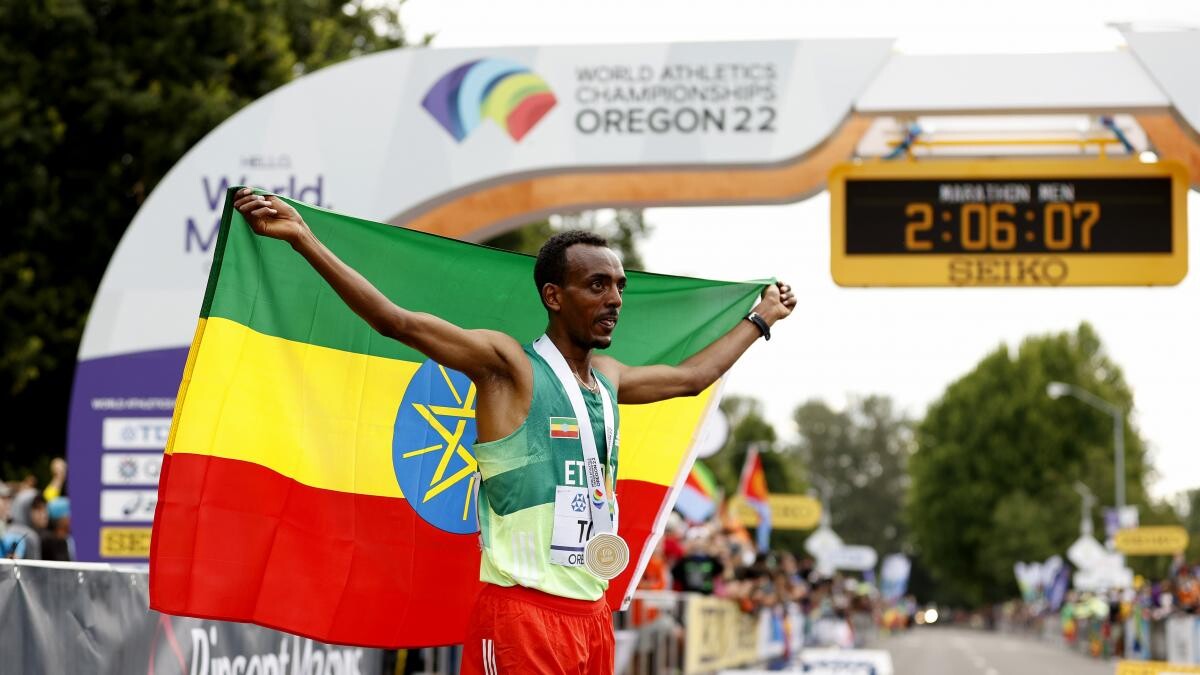
In addition to his success in the last World Cup in Eugene (United States), Tola, whose best time is 2:03:39, which he achieved less than a year ago in Amsterdam (Netherlands), was Olympic bronze in 2016 and world runner-up in 2017.
“It is a great pleasure to have accepted the invitation to run the Valencia Marathon after stopping running the London Marathon. After the victory in the World Championships I had to recover for 15 daysand that meant that with only 60 preparation it was not correct to present myself in London”, explained the Ethiopian in statements provided by the organization of the race.

The African knows that the Valencia circuit “is one of the fastest in the world”. “I hope I can get my personal best and the race record if all conditions are favorable,” he stressed.
In addition, the organizers also confirmed that the race will be the setting chosen by the Ethiopian Letesenbet Gidey to make her debut in the distance of 42,195 meters. The African has an idyll with the Turia capital since two of the four world records that she holds she has achieved there.
(08/26/2022) ⚡AMPby George Williams
VALENCIA TRINIDAD ALFONSO
The Trinidad Alfonso EDP Valencia Marathon is held annually in the historic city of Valencia which, with its entirely flat circuit and perfect November temperature, averaging between 12-17 degrees, represents the ideal setting for hosting such a long-distance sporting challenge. This, coupled with the most incomparable of settings, makes the Valencia Marathon, Valencia, one of the most important events in...
more...Ethiopians Yehualaw and Yimer look for fast times at Antrim Coast Half
British distance runners Marc Scott and Callum Hawkins are also set to race 13.1 miles while Haile Gebrselassie and Jo Pavey will run the one mile fun run this weekend.
Ethiopian distance running stars Ethiopians Yalemzerf Yehualaw and Jemal Yimer lead a world-class line-up at the ‘Mid & East Antrim’ Antrim Coast Half Marathon in Larne, Northern Ireland, on Sunday (Aug 28). There is plenty of British interest too with Marc Scott and Callum Hawkins among the entries.
The event, which is set to be covered live on BBC online from 8.55am, sees Yehualaw coming into this year’s race having broken the women’s world record over 10km with 29:14 in Castellon, Spain, earlier this year, in addition to running the fastest female debut marathon ever of 2:17:23 in Hamburg in April.
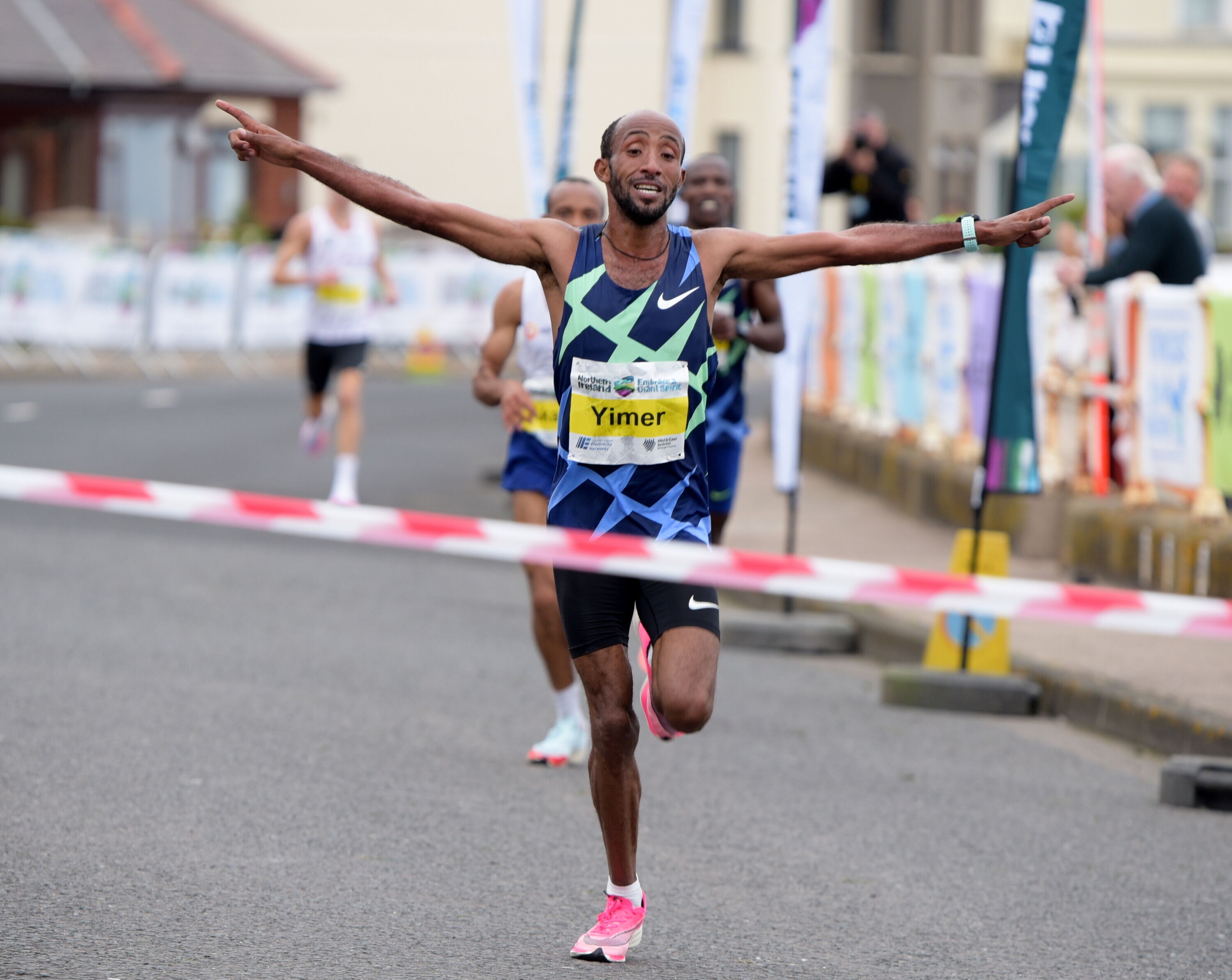
At the Antrim Coast event last year she appeared to break the world record for 13.1 miles with 63:43 but was denied the mark due to the course being found to be 54 metres short.
Yehualaw will be joined at this year’s Antrim Coast event by her training partner Tsehay Gemechu. The 23-year-old Ethiopian comes to this year’s with a personal best of 65:08 and has been winner of the Lisbon Half-Marathon two years in a row and Copenhagen Half-Marathon in 2021.

In addition for this World Athletics Elite Label road race there is Gete Alemayehu, who recorded 66:37 for second in Barcelona Half-Marathon in April. Beatrice Chepkemoi of Kenya, who has a PB of 67:29, will make it four women who have run under 67:30.
Three male pacemakers have been lined up and there is Northern Ireland interest courtesy of Emma Mitchell, Fionnuala Ross and Hannah Irwin.
The men’s field is led by Ethiopian record-holder and last year’s winner, Yimer. He is the quickest in the race with a PB of 58:33 but faces fellow Ethiopian Tesfahun Akalnew, who was was runner-up in Larne 12 months ago and has subsequently recorded a 2:06:55 marathon in Amsterdam.
Bethwel Birgen of Kenya is set to set the pace with Scott in particular hoping to be dragged under the 60 minute barrier. The Brit was not at his best in this summer’s track championships but has great pedigree on the roads after having won the Great North Run last year.
Could he get close to Mo Farah’s British record of 59:32 set in Lisbon seven years ago?
Also in the line-up are Shadrack Kimining of Kenya, Huseydin Mahamed of Ethiopia and Gizealew Ayana of Kenya, all of whom have broken the 60-minute barrier in the past.
Northern Ireland’s Stephen Scullion is also due to run plus Omar Ahmed of Birchfield Harriers.
The event has also secured a major coup with the signing of Haile Gebrselassie. The 49-year-old, who won multiple global titles during his career, will run the inaugural Antrim Coast Classic Street Mile for fun with Jo Pavey, young athletes and parents on Saturday evening (Aug 27) before joining race director James McIlroy to commentate on a half-marathon the next day.
(08/26/2022) ⚡AMPby Jason Henderson
MEA ANTRIM COAST HALF MARATHON
The MEA Antrim Coast Half Marathon 2022 has been approved by World Athletics as an Elite Event. The World Athletics certified course takes in some of the most stunning scenery in Europe, combined with some famous landmarks along the route. With it's flat and fast course, the race is one of the fastest half marathons in the world. Starting...
more...Three simple steps to running hills with ease
Running hills seems simple: you power over the top and continue, right? Once you’ve tried a few hill training sessions, or find yourself suddenly running uphill in a race, you’ll realize there’s an art to it. Here’s how to maximize your hill training by running both up and down effectively and efficiently, without getting hurt.
1.- Practice long climbs at sustainable paces
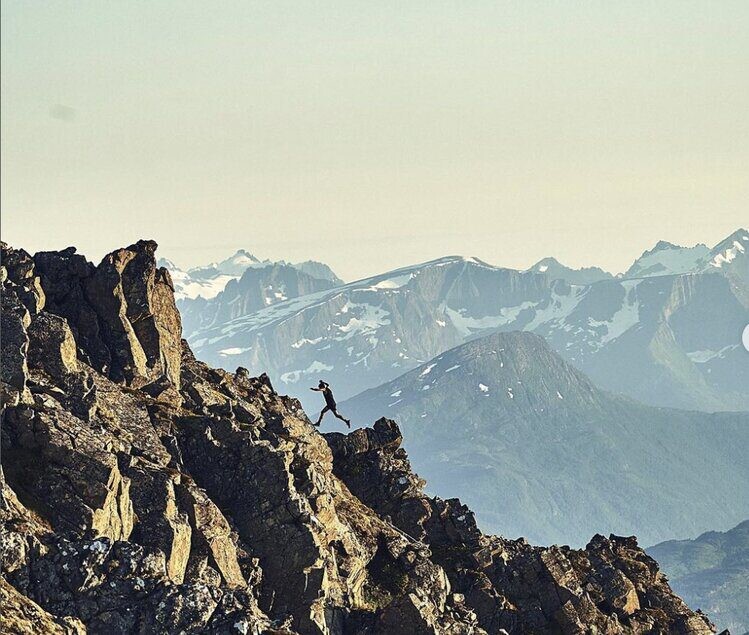
Studies show many runners tackle hills too quickly at the outset, dashing up a long climb at a greater effort than they can maintain. If you’re running a hill sprint workout, this is fine, but in any other circumstance you want to run at an even, sustainable pace. You risk burning energy you won’t be able to regain later in the race or workout if you run full-tilt up every hill you see.
Aim to find a hill that takes you 10 minutes or longer to run up (or set your treadmill incline to the point where you feel a burn, but can smoothly keep pace). Try to mimic the effort you would be expending if you were running on flat terrain, regardless of how slowly it feels like you’re going. If your breathing is noticeably heavier, slow down.
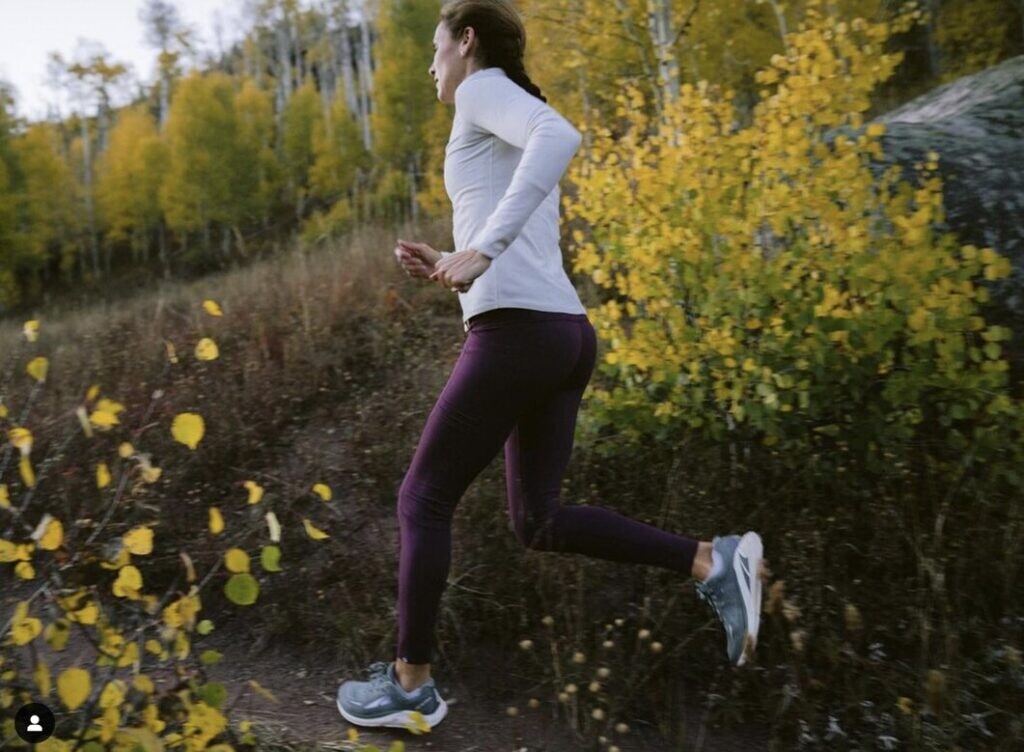
2.- Use ‘long strides’ at the top to transition
If you run too quickly up a hill, you may find yourself pausing at the top or slowing down greatly to catch your breath before resuming your normal pace. You’ll also have a shorter stride as you head uphill, and it takes a conscious effort to switch back to your regular gait quickly.
Cue yourself to open up your stride and accelerate. For practice, find a short hill that takes under a minute to reach the top of. Run hard to the top, lengthen your stride and pick up your pace for 15 seconds. Jog down the hill to recover, and repeat five to 10 times.
3.- Practice good running form on the way down
You’ve probably seen others run downhill at full speed–if you’re a person who can comfortably and safely do that, you’re lucky. For most of us, downhill running is a skill to practice. You want to avoid putting on the brakes too much, but you also don’t want to be pounding down the hill or running out of control.
After your regular run, add in four to six 100-metre strides down a slope, or a gentle hill with a grade you are comfortable tweaking your speed on. Shorten your stride, keep your arms wide and low for balance, and aim to run smoothly with quick steps. If you find your breathing quiets, you can push a little bit harder. Over time, find steeper hills to run down while maintaining the same form.
(08/26/2022) ⚡AMPby Keeley Milne
Here’s how kindness will make you a better runner
Renowned ultrarunner, coach and co-author (with his wife, Megan Roche) of The Happy Runner, David Roche has some suggestions about how we can practice kindness and positivity toward others in our running and racing, and he explains why science backs this up.
“Lifting others up can lift you up too,” says Roche. “It’s not just psychological, but in how physiology responds to stress. Uplifting emotions may improve running economy. Affirmations reduce cortisol and stress. Even adaptation processes on the cellular level may be improved by a positive neurophysical context,” he adds.

If that’s not enough for you, know that you’ll also have way more fun; whatever the end result of your race, you’ll look back on the experience with more joy.
Celebrate shared experience

While the running community still has a long way to go in supporting diversity and inclusivity, trails do tend to tear down barriers and bond people. Most of us feel far more comfortable talking to strangers on a trail than we would on a street. If you see someone struggling a little out there, you’ve probably been in that situation yourself, and you have some empathy for them.
That person you stopped to give a salt tablet to mid-race when you noticed them struggling hits the finish-line all smiles and tears, and you’ll feel their success like its you’re own. Roche explains that by building your running community, you will tend to be more process-focused and less results-focused (which was actually, in turn, help you run faster).
Thank every single volunteer and encourage every other runner
If you’ve ever had challenging race, you’ve probably experienced some moments of suffering. Mine, in ultrarunning, often involve struggling to keep enough nutrition in and combat nausea; I find it hard to carry on conversations when I feel that unwell. A much more experienced ultrarunner (who has also combated GI distress) once commented to me that the worse she felt, the more appreciative of the volunteers she tried to be. At first, that seemed unfathomable to me. Be extra thankful when I all I really want to do is cry or throw up?
I set out to test this theory when I ran a backyard ultra earlier in 2022. I dedicated myself to asking questions about others when my brain started to spiral into lowness, and to express my gratitude toward my crew and the race volunteers. That day was a certain kind of magic unlike any other I’ve had, and while I’m sure I can’t chalk it up entirely to practicing being nice, it certainly helped.
Roche sums up the concept of being a beacon of cheer when he says: “Spread the freaking love because life is too short and uncertain and scary to spend it alone, withholding affection.” I can’t argue with that. Even if you’re an introvert like me, up your kindness-game next race. You have absolutely nothing to lose by giving it a try.
You don’t have to be perfect at this–no one is. “The goal isn’t to exude an infallible aura of kindness, but to accept yourself and others as much as you can given the constraints of your background, brain chemistry, and perspective,” says Roche.
(08/25/2022) ⚡AMPby Running Magazine
Gelete Burka will be running the 2022 TCS Toronto Waterfront Marathon on October 16th
A three-time Olympian for her country, Gelete was also the 2008 World Indoor 1,500m champion and 2006 World Cross Country champion. But when she won the 2017 Ethiopian World Championships 10,000m trials and was not selected for London, she turned to the marathon. Her results in the classic distance have been sublime.
Her curriculum vitae includes a personal best time of 2:20:45 (2018 Dubai Marathon) and a splendid 3rd place finish in the 2019 Chicago marathon (2:20:55). Dipping under 2 hours 20 minutes remains a tangible objective.
This will be only the second time the 36-year-old star has raced in Canada. On her previous occasion in 2018 she set a Canadian All Comers’ marathon record of 2:22:17 in Ottawa, despite running with stomach cramps and completely alone for much of the race.
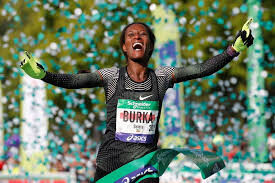
That record was beaten by one second at the Toronto Waterfront Marathon by Kenya’s Magdalyne Masai in 2019. The pair will battle in Toronto.
“My training is going well and I am so happy with my training,” Burka says from her home in Addis Ababa, the Ethiopian capital. The WhatsApp call had been delayed by a couple of hours when the lights went off during a power outage.

“We have two months until the race and I’m just working hard,” she adds. “It is sometimes raining here. We look at the weather and choose training places. We are working hard in Sendafa, Entoto, Sululta, Arafat. We train in five or six different places.”
Coached by Getamesay Molla, the group of elite runners she belongs to meet in those various locations all within half an hour of Addis by car. In a radical departure, Gelete even spent most of the month of July in Colorado Springs, Colorado where she joined Kenyan born US coach Haron Lagat. It is the rainy season in Ethiopia and heavy rains adversely affected the dirt roads back home.
“It’s nice for training there,” she says of the Colorado Rocky Mountains. “I was with some friends in the US Army Athletics (group). Do you know Haron Lagat? I was with him working there in Colorado Springs before the marathon training.”
Gelete had expected to race Ottawa earlier in May but although her Canadian visa was approved, she did not receive her passport in time to travel to Canada. After training for six months specifically for the race, the disappointment was enormous. It is not easy to train to peak for a specific marathon and then have to find an alternative. In any case, Ottawa is among the final spring marathons.
“One week I was sick. I was so heartbroken,” she reveals with a smile. “I haven’t any business, my only business is working in athletics. I just focus on my running. A little bit I was angry because I worked so hard. It is not like track racing.
“It was a big disappointment but sometimes you forget something that happened in life. I have forgotten it and now am only focused on Toronto.”
Gelete comes from Kofele in Arsi district of south-central Ethiopia. It’s the same region from where national hero, Haile Gebrselassie, originates.
Family is everything to her and currently her youngest sister together with her niece, Deborah, and nephew, Muse, share her home in Addis. After returning from Colorado, one of the first things she did was travel back to visit her mother and her other siblings in Shashamane, one of the main towns in Arsi. It is also known for its large Rastafarian community.
A devoted Christian, Gelete is also a member of the 40-member choir at the Glorious Life Church in Addis. They sing in Amharic, Oromo and English at two weekly services. In addition, she is an usher at the church and so must attend meetings and choir practices when called. Her faith is important enough that following her 2018 Ottawa victory she sought out an Ethiopian church to attend.
Given the news that Magdalyne Masai shaved a second off her Canadian All Comers record in 2019 - and will face her on the Toronto starting line - Gelete smiles. Asked whether Masai’s 2:22:16 standard will now be a target, she thinks for a moment.
“You have to see in the race how you are feeling and also what she is feeling,” Gelete explains. “In a race you think of records when your body feels ok. For now I am not sure. I will look inside the race for what I can do.”
Ethiopians were overjoyed with the performance of their 2022 World Championships team in Eugene, Oregon. With 10 medals, Ethiopia finished second in the medal table behind the host USA. Seeing her compatriot Gotytom Gebreslase take the women’s marathon gold was extra special.
“It is still in my head that I want to run under 2:20,” she says, “because you see the world championships I am so happy (Gotyom) ran 2:18. After you see in championships they are running 2:18 then I think under 2:20 (is possible) if the body is ok and the weather is ok. And, if the others want to run a very good time.”
Clearly this Ethiopian superstar has bold intentions for her future. Her race against Masai in this World Athletics Elite Label race is a tantalizing prospect.
About the TCS Toronto Waterfront Marathon
One of only two World Athletics Elite Label races in Canada, the TCS Toronto Waterfront Marathon is Canada’s premier running event and the grand finale of the Canada Running Series (CRS). Since 2017, the race has served as the Athletics Canada Canadian Marathon Championship and has doubled as the Olympic trials. During the 2021 event, participants raised over $3.08 million for 151 community charities. Using innovation and organization as guiding principles, Canada Running Series stages great experiences for runners of all levels, from Canadian Olympians to recreational and charity runners. With a mission of “building community through the sport of running,” CRS is committed to making sport part of sustainable communities and the city-building process.
(08/25/2022) ⚡AMPby Paul Gains
TCS Toronto Waterfront Marathon
The Scotiabank Toronto Waterfront Marathon, Half-Marathon & 5k Run / Walk is organized by Canada Running Series Inc., organizers of the Canada Running Series, "A selection of Canada's best runs!" Canada Running Series annually organizes eight events in Montreal, Toronto and Vancouver that vary in distance from the 5k to the marathon. The Scotiabank Toronto Waterfront Marathon and Half-Marathon are...
more...US record holder Keira d’Amato and Kenyan Nancy Jelagat Meto head Women’s Field At BMW Berlin Marathon Sept 25
The American record holder Keira d’Amato and Kenya’s Nancy Jelagat Meto lead a high quality women’s field for the 48th edition of the BMW BERLIN-MARATHON on Sunday, September 25. Keira d’Amato improved the US record to 2:19:12 which also gives her the accolade of the fastest in the women’s field, announced by the organisers today. Eight women will be on the start line with personal bests of under 2:21.
The return of Kenya’s double Olympic champion and world record holder Eliud Kipchoge had already been announced some weeks ago as well as the participation of the current BMW BERLIN-MARATHON champion Guye Adola of Ethiopia. Six men on the start lists have personal bests of under 2:06while the organisers SCC EVENTS expect more than 45,000 runners from around 150 countries for Germany’s top road race. The BMW BERLIN-MARATHON is an Abbott World Marathon Majors race and a Platinum Label Road Race, awarded by World Athletics, the international governing body of the sport.
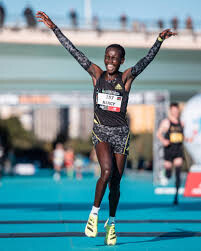
“After securing the presence of Eliud Kipchoge and Guye Adola, we are delighted also to have a very strong women’s field on the start line. With the right weather conditions there is certainly a good chance of very fast times,” said race director Mark Milde.

The presence of Keira d’Amato and Nancy Jelagat Meto brings to the event two women who have already run sub-2:20. At the age of 37, Keira d’Amato sprang a major surprise to break the American record with 2:19:12 in winning the Houston Marathon. That led to her late nomination for the World Championships in Eugene where she ran impressively to finish eighth. Sara Hall, who plans to run Berlin and then New York as well, went even better, finishing fifth.
Hall’s best time is 2:20:32. Nancy Jelagat Meto showed fine form in the past year, winning the prestigious Valencia title with a major improvement of 2:19:31. Four months previously she made a strong showing with second place in 65:21 at the GENERALI BERLIN HALF MARATHON.
Quite a few women runners will hope to put Berlin’s fast course, where Eliud Kipchoge set the current men’s world record of 2:01:39 in 2018, to good use in their bid to break 2:20: Gutemi Shone Imana has a best of 2:20:11 while Workenesh Edesa has run 2:20:24 and a third Ethiopian, Sisay Gola, has clocked 2:20:50. The Kenyans also have their contenders to break this landmark time in Maurine Chepkemoi, currently with a best of 2:20:18 and Vibian Chepkirui, who won the Vienna City Marathon in 2:20:59 in April.
Nor should marathon debutants be overlooked in the search for potential women winners, given that the Ethiopian Gotytom Gebreslase did just that to win last year’s BMW BERLIN-MARATHON title. Two possible contenders are Rosemary Wanjiru of Kenya and Ethiopia’s Nigisti Haftu. Both have strong performances at half marathon to their credit which could make them realistic challengers.
(08/25/2022) ⚡AMPBMW Berlin Marathon
The story of the BERLIN-MARATHON is a story of the development of road running. When the first BERLIN-MARATHON was started on 13th October 1974 on a minor road next to the stadium of the organisers‘ club SC Charlottenburg Berlin 286 athletes had entered. The first winners were runners from Berlin: Günter Hallas (2:44:53), who still runs the BERLIN-MARATHON today, and...
more...Is There a Right Age to Start Running?
Running is a versatile sport — which means that people take it up for a variety of reasons. You could start running either to improve your health, compete in a race, raise money for a charity, lose weight, or for a select few, to become a professional runner. Now, you might be wondering about the right age to start running — if there is such a thing as too early or too late — and how it affects your body differently. Let’s find out.
Most, though not all, professional distance runners start running very young, usually even before they turn 10. And if they haven’t been a long-time runner, they’d have likely participated in other endurance sports at a higher level from an early age. Most elite runners have years of competitive running under their belts before “going pro”.

It is important to note that speed and endurance are largely inversely related. As people age, their speed diminishes, but their endurance does not. However, one’s absolute aerobic capacity does decrease with the years. So, while there is no strict or right age where an individual must start running in order to become a professional, generally speaking, the latest age would be between the late 20s and early 30s.
When is it a good time to start running?

From a health perspective, there is never a wrong time. Running is a series of small one-legged jumps that most people can do. Many myths, such as running being hard on the knees, have been proven to be just that — myths. So, at the end of the day, there is no age that is not appropriate to start running.
Running is often introduced in middle school (grades 5 to 8) as part of physical fitness classes. When starting out at a young age, the focus should be on fun and possibly integrating running with other sports.
From one’s late teens to the thirties, the focus is often on competition and using fitness as a means to lose weight and get in shape. In one’s late thirties and beyond, the focus is often on overall health, weight loss, and stress reduction.
Are there any prerequisites?
Before undertaking any sort of physical fitness routine, regardless of the modality, it is a good idea to get a medical clearance from a professional. You may want to go to a sports cardiologist or any specialized sports clinic. Tests such as blood work and electrocardiography (ECG) are often performed to ensure that an individual has no underlying heart or other issues.
A medical screening would help to know if the potential runner has any contraindications (for instance, doesn’t have a heart rate above 140), which can be discussed before beginning an exercise program. Also, it helps in identifying any underlying conditions that may only occur during cardiovascular activity.
Cardiovascular fitness precedes musculoskeletal readiness
What this means is that one’s cardiovascular system develops at a faster rate than one’s bones, muscles, and connective tissue (i.e., tendons and ligaments). Just because a runner can handle a particular intensity and/or distance from a cardiovascular standpoint, doesn’t guarantee that their connective tissue, bones, and muscles can do the same. This is why many new runners are susceptible to issues such as tendinosis (or tendonitis), shin splints, and muscle strains.
Therefore, a running program for a beginner should focus on slow progression with adequate rest days. If someone is out of shape, a run/walk program is often suggested. A beginner runner should work with a coach on a customized program, which will help monitor their progress.
Running for beginners calls for personalized coaching, dedication, and persistence. And some love for the sport. So, when’s the right time to start running? Right now!
(08/25/2022) ⚡AMPby Rick Prince
Four reasons fall is the best time to race
There is nothing quite like the fall racing season, and now is the perfect time to sign up.
Every season has its pros and cons for running, but let’s be honest: fall takes the cake. In fall, it’s rarely too warm or too cold, there’s a fresh feeling and smell to the air, and you can’t beat the fall colors. If you don’t have a fall race on your calendar yet, now is the perfect time to sign up and start training so you can ace your race.
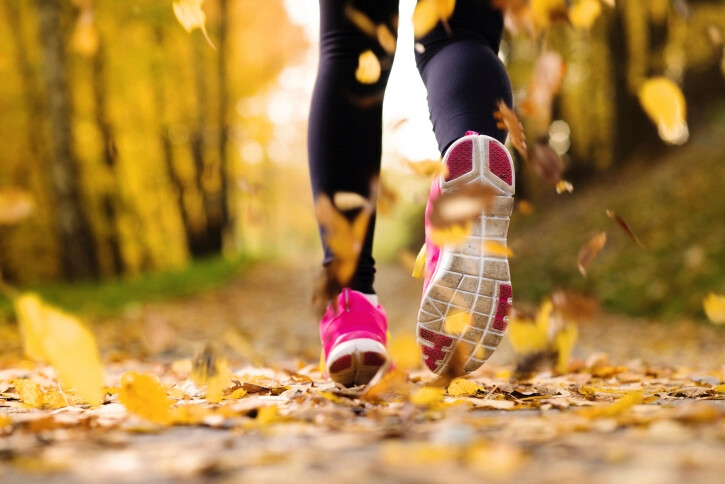
Here are four reasons why fall is the best time to race.
Ideal temperatures
After dealing with hot, humid runs all summer, nothing feels more refreshing than the cooler temperatures fall brings. Doing workouts or racing in the fall feels about 10 times easier, thanks to the cooler weather. After training in the heat all summer, your body will be acclimatized to warm conditions; so on a cooler race day, you’ll see better results.
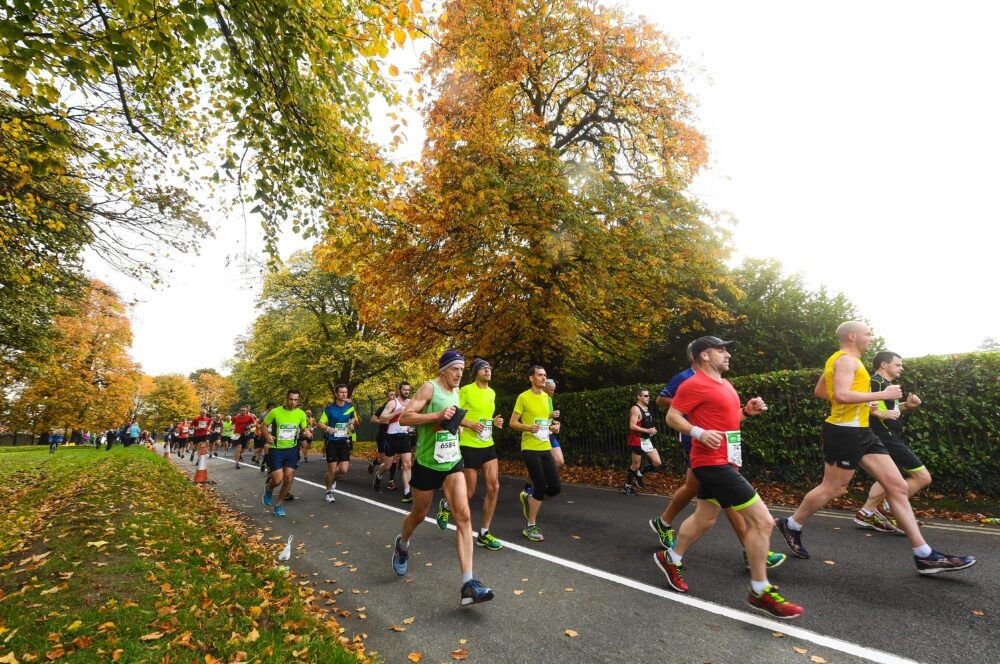
A plethora of races
If you’ve been training all summer and still haven’t registered for a fall race, don’t worry. There are many fall races across Canada, from the beginning of September to the end of November. There are plenty of half marathons, 10K’s and 5K’s taking place all across Canada this fall, check out our Canadian Race Guide for upcoming races in your province.
The fall season is the perfect time to put all your summer training on display and to watch your hard work pay off.
The best time for marathons
For marathoners, there are four Abbott World Majors within a six-week span: Berlin, London (which is back to its usual fall schedule this year), Chicago and New York, plus three Canadian marathons (in Montreal, Quebec City and Toronto). Fall is when you finally get to see your training partners and favorite elites throw down at some of the biggest marathons in Canada and around the world.
Beautiful scenery
Is there anything more scenic than a fall race as the leaves start changing color? The smell of the cool air and the crunch of the leaves under your feet is satisfying as it gets. Plus, it makes for great race photos.
(08/25/2022) ⚡AMPby Marley Dickinson
Five Ways to Make Running a Habit
This time of year is the perfect time to start getting back in shape, revamping your fitness routine, and falling in love with running. However, one of the most challenging parts of beginning to run is learning how to make running a habit.
Making running a habit is key to any long-term success.
Whether you’ve taken up running to lose weight, gain muscle, stay in shape or conquer new goals – you’ll be hard-pressed to accomplish much without consistency.
While running is known for its impressive health benefits, heading out the door for a run once every three or so weeks won’t do you much good.

The challenge of any sport is no doubt that it is difficult to begin. Trying something unfamiliar for the first time can feel uncomfortable and downright unpleasant. But persevering through these struggles is what makes us stronger.
If we’re lucky, we’ll find the motivation we need to continue on even when times are hard. Eventually, each day will feel a bit easier, and before long, this once foreign activity will become part of our routine.
But still, getting to this point can often be tricky. Even once you’ve started to feel comfortable running, making a habit out of it brings new challenges of its own.

One of the biggest obstacles you’ll face when incorporating running into your lifestyle is finding a way to make running a habit. When life gets busy, which is so often does, finding the time to head out for a run can feel nearly impossible.
However, these simple tips will help you quickly make running a habit – so you never have to think twice about heading out for your run. Before long, your friends will be calling you “their runner friend” and questioning how in the world you make time for it all.
1.- Schedule it in.
There’s nothing worse than knowing you have to run, but not knowing when you’ll be able to fit it in. Starting the day without a schedule or plan for your run will likely leave you scrambling to make time before you go to bed. And after a long day, the last thing you’ll want to do is any sort of physical activity – leaving you primed to succumb to those excuses.
Create a plan for your day ahead of time, and make a point to schedule in your run. If possible, make a plan for the entire week all at once. Look through the activities you have planned each day and decide on a time to run that makes sense.
If your Thursday is packed with evening activities, plan to set your alarm and run before work. If you have Tuesday afternoon off work, plan to run after lunch before settling down on the couch.
Proactively planning time to run will help minimize excuses and leave you with less reasons to skip out. Before long, you’ll know the plan for the day before it even begins.
2.- Find a time that works.
While the thought of running in the wee hours of the morning may feel motivating, it might not work best for you. Likewise, just because your friend fits their workout in after dinner doesn’t mean you’re going to want to head out after a big meal.
Find a time that works for you to run each day and stick to it. There is no such thing as the wrong time to run. Experiment with morning runs, lunchtime runs and evening runs until you find a time of day that works best with your schedule.
Once you’ve decided on a set time each day to run, your body and mind will begin to expect to run at this time. Stay consistent with your timing as much as possible to help establish a schedule. Before long, running will be a habit that you don’t even have to think twice about.
3.- Prepare ahead of time.
Frantically trying to round up your gear while you scramble to get dressed in time to run will just leave you wanting to skip it all together. The key to maintaining a consistent running habit is preparation.
Prepare your gear, clothes, shoes and mind ahead of time – no matter when you plan to run the next day. Set out all of your fuel, water, gadgets and clothes to take away as much decision making as possible.
It’s much harder toskip a run when everything is laid out and ready to go. Take the time to prepare your running gear the night before no matter when you are planning to run. Then, as soon as you wake up or get home from work, change into your running clothes.
4.- Don’t think twice about it.
Sometimes overthinking can be our biggest enemy. When we take the time to really think about our run, we often find ourselves coming up with a list of excuses to skip it.
Make a plan to run, prepare your things ahead of time, and then don’t think twice about it. When it’s that time of day, change into your running gear and head outside.
Allowing yourself extra time to procrastinate just leaves you feeling lazy and sluggish – and wishing you wouldn’t have wasted so much time when you finally do head out for a run.
In the beginning phases of creating a running habit, just doing it is key. Get out there every time, no matter how much you don’t want to. Stay consistent with your running each week and maximize your time by not thinking twice about it.
5.- Set a goal.
Creating a running goal is a great way to keep yourself motivated and help make running a habit. Decide on a certain distance, weekly mileage, pace, or race that you’d like to complete and focus on this goal when running feels challenging.
Working towards a goal gives you purpose every day. When you’re feeling lazy or unmotivated, reminding yourself of your goals will help you stay on track.
Set a goal as you begin running and remind yourself how easily success will come once running is a habit.
No matter how much you love running, there will always be days when you just don’t feel like it. Creating a running habit is key to succeeding during these times of low motivation.
Staying consistent as you start running is the best way to really make running a habit. Getting out there every week to run those miles will help show your mind and body what to expect. Before long, you’ll be heading out for your run without even a second thought.
(08/24/2022) ⚡AMPKenyan Evans Chebet eyes course record in New York Marathon race
Boston Marathon champion Evans Chebet will be looking to extend his winning form during the New York Marathon which goes down on November 6.
Chebet will be battling it out with defending champion Albert Korir among other top names in the elite field.
Korir stormed to victory last year after clocking two hours, 8:22 seconds ahead of Mohamed El Aaraby with 2:09:06 and Eyob Faniel came third in 2:09:56.

Four of the six Abott World Marathon Majors will be taking place this season. Berlin Marathon will be held on September 26, London Marathon on October 2, Chicago Marathon October 9 and New York Marathon in November.
In an interview with Nation Sport, Chebet said that he has started preparations to make his debut in the New York Marathon race.
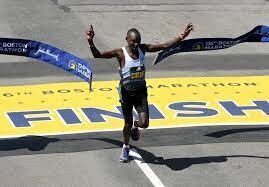
He said that the race looks competitive, given that only two Kenyans will be lining up for the contest, but he will do his best.
“I have started preparations for my first New Marathon race. I understand the course is tough but I believe with good training I will be able to register good results,” said Chebet.
The athlete said that he will apply the same tactics he used to win the Boston Marathon during the New York race, and if possible, run a course record.
But this could be a tall order because since Geoffrey Mutai registered the 2:05:06 course record in 2011, no athlete has run close to that time due to weather conditions.
“I have asked around and I have been told that the course is tough, and I have to prepare well for that. Marathon racing needs a lot of calculation and you just can’t run without thinking what awaits you in the last few kilometres,” added Chebet.
At the same time, he said that there is need for athletes to travel with translators because they can use Kiswahili language to express themselves during the pre-race conference and interviews after the race.
“I feel comfortable expressing myself in Kiswahili, and I know many athletes are struggling but I think it is high time we have translators when we compete abroad just like the way Ethiopians do when they talk in Amharic,” he said.
The big names in the New York Marathon include; the 2020 London Marathon champion Ethiopia’s Shura Kitata, Brazilian Olympian Daniel Do Nascimento, Japan’s Suguru Osako who was third at the 2018 Chicago Marathon, Dutcs Olympic silver medallist and national record holder Abdi Nageeye and four-time Olympian American Galen Rupp.
World Athletics Championships marathon champion Ethiopia’s Tamirat Tola is also in the mix. He won the world having won the World Championships marathon title in Oregon, USA on July 17.
Albert Korir won the last Abott Marathon Majors series after accumulating 41 points for the 2019-2021 season.
The Abott Marathon Majors series this season began with the delayed 2021 Tokyo Marathon race which world marathon record holder Eliud Kipchoge won on March 6 this year. Thereafter, Chebet won the Boston Marathon title on April 18.
Ethiopia’s Tamirat Tola is also in the mix having won the World Championships marathon title last month in Oregon, USA.
(08/24/2022) ⚡AMPby Bernard Rotich
TCS New York City Marathon
The first New York City Marathon, organized in 1970 by Fred Lebow and Vince Chiappetta, was held entirely in Central Park. Of 127 entrants, only 55 men finished; the sole female entrant dropped out due to illness. Winners were given inexpensive wristwatches and recycled baseball and bowling trophies. The entry fee was $1 and the total event budget...
more...One simple trick to master fuelling on the run, Practice, practice, practice: here's how
Practice. If you’re used to simply lacing up your shoes and heading out the door, it can seem like a nuisance to have to consider your meals, snacks, and what nutrients you should be taking in every single time you run. Becoming better at this key skill for any longer-distance race means incorporating it into your training as often as possible. Here’s why, and how to get started.
Experiment with gels and real food
If you’re training for a marathon distance or longer, you should be taking in some form of calories once your weekly long runs are longer than an hour. Regardless of what nutrition plan you follow in your life outside of running, you’ll probably turn to carbohydrates during a race, and for good reason. Simple carbohydrates, often in the form of glucose, are the easiest to digest and will give you an energy boost quickly.
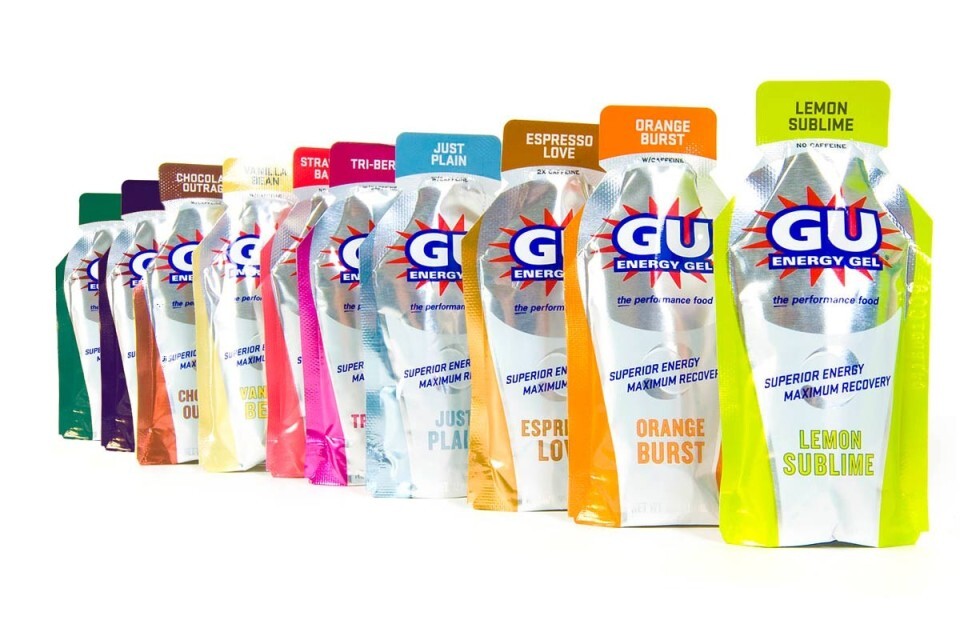
If you’re training for an ultra, depending on the distance, you need to co-ordinate consuming thousands of calories. Gels can be an easy form of simple carbs to take in, but when you’re logging many hours, you may want to turn to real food.
If you have tackled a few long runs, you’ll know that while you might feel hungry, not every type of food will satisfy or sit well in your stomach. Experiment on long runs with foods that appeal to you, and see if you can manage to eat and digest them while running without GI distress. Some runners have no issue eating a sandwich while logging mileage, others will feel sick trying to digest anything of substance. The good news is that you can actually train your gut to handle digesting food better while running; it just takes (you guessed it) practice.

Practice the actual act of managing to eat while running
If you’ve ever volunteered at a marathon or ultra aid station, you have probably noticed people struggling to open gels, drink from little cups, or unscrew the lids on their hydration packs. While some very experienced athletes have their fueling down to a fine art, the vast majority of runners aren’t at their most dextrous during a hard run.
When most of the calories you are consuming are being used to keep your legs moving, your body temperature regulated and your brain functioning enough to keep you on the course, you lose fine motor skills. Practicing eating and drinking on long runs can make a vast difference when it comes to race day.
Learn how your body responds to salt and caffeine
Caffeine can be a very effective stimulant for athletes, but knowing how much and how to use it is unique to each runner. A large body of research has shown that caffeine enhances mental alertness and delays physical fatigue, but it can be tricky to determine how much is ideal for your body and how you prefer to ingest it. Test out gels or drink mixes that contain caffeine, caffeine pills and caffeine chewables to see if you find them effective.
We know that sodium is an essential electrolyte, and salt is one of the thing things the body becomes depleted of most quickly during hard efforts. Salt also contains electrolytes like magnesium, calcium and potassium, so it’s good for more than just sodium replenishment. Experiment with salt pills, chewable salt tablets, or simply add a pinch of salt to some water.
Drink mixes have varying amounts of electrolytes, so be sure to keep track of what you try and what seems effective–hotter days will require more salt to keep your body running smoothly.
While it can seem like one more thing to juggle when you head out to train, making sure you’re keeping track of fuel and experimenting at every opportunity will make you a more wise, prepared and strong athlete. When it comes to fuelling, practice really does make perfect.
(08/24/2022) ⚡AMPby Keeley Milne
How to run every street in your town
Is your training lacking a bit of motivation? Try finding and exploring places you've never run before with CityStrides.
The #RunEveryStreet challenge started organically for runners like Vancouver’s David Papineau, who set out with a pen and paper to run all 1,090 streets in the Vancouver area in 2014. It wasn’t until 2018 that renowned ultrarunner Rickey Gates ran every street in San Francisco over 46 days, which put CityStrides on the map and opened the realm of possibilities for runners like Toronto’s Stephen Peck, who recently did the same thing on his city’s 11,000 streets.

In case you do not know what CityStrides is (i.e. me, six months ago), it’s an Internet open street map software that syncs with MapMyRun, Garmin and Strava, creating a heatmap which shows you how much of a city you’ve run. CityStrides uses the GPS data from the third-party apps and throws all the runs or walks you’ve ever done on a map, giving you a super precise detail of the streets you’ve covered and when you’ve covered them.
When Papineau first uploaded his runs to CityStrides in 2018, he was shocked at how much of Vancouver he still had to cover. “I used to print a map on paper and bring it with me on my run,” says Papineau. “Trying to run every street is like building a house: most runners have covered the main streets and parks (the foundation), and running every street is just filling in the gaps between.”
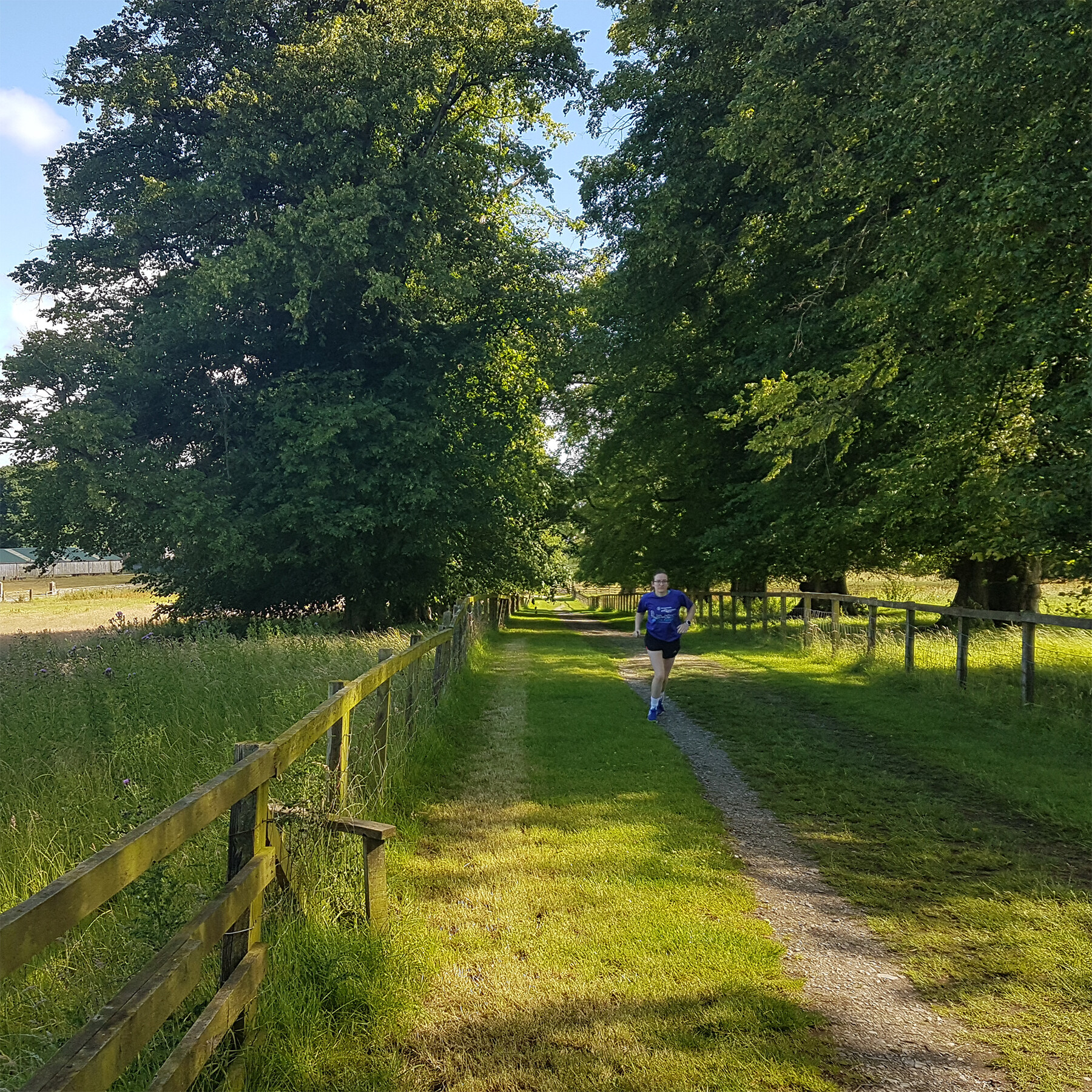
How to get started?
If you use a third-party app like Strava or Garmin Connect for your training, getting started on CityStrides is easy. Visit the CityStrides website and connect to the third-party app to create your profile within seconds.
The application will automatically create a profile for you and connect all your previous runs and all runs moving forward.
If you are just starting with running, using CityStrides is an easy way to keep yourself motivated. Use your progress as motivation to run every street in your neighbourhood or town. “One of the rewarding things about CityStrides is that you will often see places you would often never go to,” says Papineau.
Papineau said the best way to get started is to get out and do it! “Start with the short runs around your immediate neighbourhood on streets you have not run down, and branch out from there.”
Some techniques Papineau used while completing Vancouver were pre-setting his route on his GPS watch, plus graphing out runs in areas he’s never been. “In grid cities or towns, it’s easy to tackle running every street in a particular neighbourhood since the roads are restricted to parallel and perpendicular directions.”
“I’d travel to an area and write down the streets I needed, then run them,” says Papineau.
“When you start seeing your total completion percentage go up, you almost get this endorphin rush for completing new streets,” he says. “It’s rewarding to see all your hard work documented.”
CityStrides may become an obsession, or you may not like it at all, but at least you get to see and experience new places you’d never see in your own backyard.
(08/24/2022) ⚡AMPby Marley Dickinson
Tim Murphy founder of San Diego Elite Racing Inc has died at age 77
Tim Murphy, founder of San Diego’s Elite Racing, Inc., the man who reinvented running, not once but three times, succumbed to pneumonia Wednesday night (August 17, 2022) passing in hospice care at his home in San Diego, California. He was 77 years old.
Today, though smaller than it once was, the Rock ‘n’ Roll Marathon Series remains the largest purveyor of running events in the world, with 29 events in 16 U.S. states, Washington D.C., and seven foreign countries. But a quarter century ago, who knew what lay ahead in the wild open spaces of the first Rock `n` Roll Marathon?
Some observers even questioned the concept of rock bands strung along the marathon course altogether. What does rock`n` roll have to do with San Diego, much less with running a marathon, the ultimate test of endurance?
Well, on June 21, 1998 the world got its answer. With the snarl of a blistering guitar solo, the tight syncopation of a snare drum, and the slap of millions of accompanying footfalls, the second-wave running boom announced its arrival in San Diego with a carnival of music, endorphins, and sweat. It’s like Tim turned over the calendar two years early to introduce the new century.

“We created a theme marathon without intending to,” said Tracy Sundlun, Tim’s long-time partner at Elite Racing.
NEW DEMOGRAPHICS
No new major marathon had sprung up in the U.S. or the world since the Los Angeles Marathon arrived in 1986. In its first year, LA registered 10,787 runners, making it the largest inaugural marathon in history. Instantly, that number became Tim‘s goal for San Diego to beat LA.
Even before its first steps were run, though, there was the feel of a major marathon about the Rock ‘n’ Roll Marathon. Tim had conceived the idea years before while running the final lonely miles of the Heart of San Diego Marathon out along Friar’s Road to Qualcomm Stadium in Mission Valley. Wishing there were some kind of support along the road to help out, Murphy thought, wouldn’t it be great to have music to run to.
It took a long time for his idea to gestate, but the seed had been planted.
After a decade of developing his reputation as an event innovator, beginning in 1986 with the Carlsbad 5000 just north of San Diego – the event that proved runners in a then 10k / marathon focused world would run a 3.1 mile race, while introducing “spectator running” where the professional field followed age and gender specific races over the same tight-looped course – Murphy’s idea of a musical marathon came to life, born out of two separate, but catalyzing events.
“When they opened the Rock & Roll Hall of Fame in Cleveland (1995), there was so much hype about it,” Tim told San Diego YuYu in 2004. “So I was running along one morning and I thought, “If I lived in Cleveland I would do a marathon that would start and finish at the Rock & Roll Hall of Fame and do a big concert afterwards.”
One year later 273 San Diegans were among the record 38,000 entrants at the 100th anniversary of the Boston Marathon.
“Afterwards, they had this get together and all they could talk about was why there wasn’t a major marathon in San Diego. And all the runners, some of them pretty important, just wouldn’t leave me alone about it. So I essentially dusted off the old idea I had for Cleveland and started.”
With the backing of a set of investors, led by Hollywood A-list producers Frank Marshall and wife Catherine Kennedy – “Jurassic Park”, “Indiana Jones” , “Jason Bourne” – along with celebrity ambassadors like basketball Hall of Famer Wilt Chamberlain, Tim promoted his concept relentlessly at race expos around the country, touting his new baby with posters and ads that said, ‘You missed the first Boston. Don’t miss the first Rock ‘n’ Roll!’
No longer a simple feat of speed endurance, the grueling marathon had been reinvented as a rollicking 26-mile long block party through America’s Finest City.
Despite a 37-minute delay at the start due to some perceived traffic issues on the course – which led to a water-dousing through the first aid station – the high-spirited music rocking the sidelines caused an immediate sensation.
Nearly 20,000 entrants from 30 countries and all 50 states passed the word, ‘You gotta try this one!” And that was before they got to the post-race concert that night featuring Huey Lewis and the News, Pat Benatar, and the Lovin’ Spoonful!
The makeup of year one’s field proved historic, as well. 50% of the field was women, far and away the largest such percentage of any co-ed road race of any distance to date, and a pivot-point in the history of the sport. Before RnR San Diego, the largest percentage of women in a major marathon had been just 23% at New York City. Most road races had only 10% to 15% women at the time.
Rock ‘n’ Roll’s runners were also slightly older than the norm, slightly wealthier, and slightly slower than the average marathon runners.
At a time when road race courses were designed to be minimally visible and impact their communities as little as possible, the initial Rock ‘n’ Roll Marathon layout was designed to be an infomercial for the city, regardless of the potential inconvenience for some.
When city officials asked how long they would have to keep the streets closed, Tim based his projections on the New York City Marathon, saying, ‘we might have 50 or 60 runners who will take longer than six hours 30 minutes. But we’ll just direct them onto the sidewalk, so you can reopen the streets.’ As it turned out, 1500 runners took over seven hours to complete their 26.2 mile journey.
But Tim Murphy wasn’t just in it for the large participation numbers, important as they were. He always had his eye on top talent, too, and urged elite athlete coordinator Mike Long to pull in a world-class field, like he did every year for the Carlsbad 5000 where so many world records were set.
Mike Long, the late Elite Racing athlete recruiter with Rock `n` Roll 1999 champs Tarus & Bogacheva
Nobody knew how fast RnR could be run until young Kenyan, Philip Tarus, busted a 2:10 opener for the men, with Russian women Nadezhda Ilyina and Irina Bogacheva battling just nine seconds apart at the finish for the women in 2:34. That told the athletes of the world, ‘This one is worth having a go,” especially after all the Suzuki products and prize money checks were handed out.
Not since the New York City Marathon’s first five-borough extravaganza in 1976 had a marathon come on the calendar with such dramatic impact: The largest first-time running event in history; the most ingenious show along the sidelines and at the finish ever produced; $18.6 million (net) raised by and for The Leukemia & Lymphoma Society’s Team In Training charity – the largest amount ever for a single-day sporting event; and to cap it off, world-class performances by its champions.
Though the race lost over $1 million in its first year, it instantly became the number one economic impact event in Southern California, generating $39.3 million in its inaugural year, as two-thirds of its entrants came from outside the region. With Murphy’s persistence and the continued backing of his investors, Rock ‘n’ Roll eventually broke even in year three. Thus was the foundation set for what has become a global phenomenon, the so-called second-wave running boom.
Born and raised with two sisters in Denver, Colorado, Tim attended high school in Nebraska where he competed in the 880-yard run and threw the discus. He then spent the first part of his professional life toiling in the health care industry, selling hospital supplies on the road while moving across the country time and time again. Finally, in the late 70s, he decided to abandon the rat race and settle in San Diego where his two sisters lived.
Though he ran track in high school, he wasn’t a distance man. But once in San Diego and introduced to the area’s vibrant running community, like so many before him, he got hooked on the sport. Tim often trained up to 10 miles a day, which led him into the race organization business and the founding of Elite Racing in 1988.
Always more of a behind the scenes workaholic than a flashy frontman, Tim did serve as interim race director for the troubled Chicago Marathon in 1989. But mostly he focused like a laser on the business side of Elite Racing. Tracy Sundlun, former head of New York City’s Metropolitan Athletics Congress, and a former collegiate and club track coach, joined as Tim’s partner in 1997, taking on the role of political go-between and liaison with the sporting world.
Through it all, Tim used his marketing and sales skills to build his race business from a fledgling local concern into the most successful for-profit organization in running.
“We have lost someone who – I don’t think many of the insiders even grasp his importance, his significance,“ said Tracy Sundlun. “Besides Fred Lebow in New York City, Tim was the best retail marketer the sport has ever known. It makes me happy all the people who’ve reached out from all over the world when they heard news of his passing. Tim would’ve felt good knowing the people recognized what he built, what he reinvented.”
Beginning with the Carlsbad 5000 in 1986, Tim bucked the conventional norms of the sport. Nobody thought people would pay to run a 5K. Running at the time was a 10K and marathon trade. But Tim turned it into a 5K and half marathon business and the sport soon followed along.
Ethiopian great Tirunesh Dibaba breaks another world record at Carlsbad 2005 (14:51)
The success of the Rock ‘n’ Roll Marathon in San Diego changed Murphy’s fortunes for good. Over the next several years, Tim developed the brand into a seven event juggernaut that spread from San Diego to Virginia Beach, Nashville to Phoenix, San Jose, California to San Antonio, Texas.
Elite Racing was the first organization to stage more than one marathon in a year, and the first to put on events outside their own home city. Designed as a for-profit company in a not-for-profit industry, Elite Racing was the first organization to build a brand in the sport, though, initially they didn’t realize they were doing it. They were also the first to buy events and the first to sell to private-equity.
When the City of Virginia Beach, VA wanted to start a new marathon on Labor Day weekend in 2001, Tim made a site visit. He realized that with the heat and humidity of late summer in Virginia Beach, and not wanting to conflict with the fall marathons which had been so supportive of his races in San Diego in the summer and Nashville in the spring, there was no way that a full marathon would work. So Tim convinced VB to create the first destination half-marathon, The Rock ‘n’ Roll Virginia Beach Half Marathon. Until then, half marathons were just local training races for marathons.
“Just like with Carlsbad in the 5K, nobody thought people would travel to run a half marathon,“ remembered Sundlun. “When we proposed Virginia Beach, we were one of Runner’s World Magazine‘s biggest advertisers. We said we were going to sell out at 12,000 for the Labor Day weekend race. People at Runner’s World said we were nuts. At the time, the largest half marathon was the Philadelphia Distance Run at 6000, the largest inaugural half marathon was on Long Island at 2900.
“Runner’s World bet us a full, center-spread, double page ad that we wouldn’t hit our number. They didn’t even think vendors would come to a Labor Day weekend race in Virginia Beach. But we sold out by July and eventually got 14,990 entrants. Getting that check back from Runner’s World, that was really something.”
Deena Kastor headlined the inaugural Rock ‘n’ Roll Virginia Beach Half Marathon in 2001, setting an American debut record as a prep race for her marathon debut in New York City that fall. Kenyan superstars Martin Lel and Paul Tergat both tuned up for fall marathon victories with wins in Virginia Beach.
Records were always important to Tim. He would often have side bets with Mike Long about the outcome of races. Two-time Olympic champion and multiple-time world record holder Haile Gebrselassie of Ethiopia broke the half marathon world record at Rock ‘n’ Roll Arizona in 2006 (58:55). And with 16 World Records / Bests and 11 American Records, Carlsbad was always recognized as The World’s Fastest 5K.
“Tim felt if you created special events with a team of people who were passionate about the space they were in, the money would follow,” Sundlun told me. “He also understood that an event was only as good as its weakest link. So he was laser-focused on every aspect of the event, from the expo to the medal to the course to the elite athletes to the give-a-ways to the ads to the water stations, you name it.
“We never had a meeting about what to cut, just about how to improve. Tim understood you had to invest and promote relentlessly. He was tireless in his pursuit of greatness. Good people would join him and he empowered them and got out of their way. But he refused to take no for an answer, and had a single-minded focus.”
Tim even bought television’s Road Race of the Month from Salmini Films in 1991, the series that aired on ESPN for over a decade featuring the best races in the country and around the world. Tim understood that with television as a promotional arm, he could sell more advertising and attract more runners.
The string of happy days ended abruptly in July 2007, however, when Elite Racing’s beloved athlete recruiter Mike Long died suddenly of a heart attack. Mike’s passing seemed to take the spark out of Tim.
Later that year he sold the business to Falconhead Capital for more than $40 million. Elite Racing essentially became the event division of the new Competitor Group, Inc., and Tim moved on. Eventually, after Tracy also left, CGI abandoned the elite aspect of running altogether, before leaving San Diego, as well.
At times, Tim could be a volcanic boss, as his business was his life’s passion. Yet he engendered a deep dedication and respect from his Elite Racing family, out of which 17 marriages were spawned (including my own with Toya), growing families, and lifelong friendships. Tim’s final years were spent quietly, visiting with friends and his two sisters who were with him at the last.
R.I.P., Tim. You were a true visionary who has left a legacy that moved us all both body and soul.
(08/23/2022) ⚡AMPby Toni Reavis
Ferdinand Omanyala and Julius Yego lead protests over new World Athletics qualifying standards
The qualifying standards published on Friday by the World Athletics for the World Athletics Championships due for August 19 to 27 in Budapest, Hungary next year, continue to illicit mixed reactions.
However, most athletes and coaches say it will be a tall order to achieve them.

World Athletics have shortened times for most track events as well as increased the distances in field events save for men's 400m and women's 800m where it has eased the the standards compared to the World Athletics Championships held last month in Oregon, United States.
The men's qualifying time for Oregon was 44.90 seconds, but the time has been reviewed to 45.00 sec, while the women's time has been put at 1:59.80 from Oregon's 1:59.50.
The men and women's 20 kilometers race walk and marathon qualifying times have been reduced.
As was the case in 2019 and 2022, athletes will be able to qualify for the World Championships by achieving an entry standard or through their World rankings.
The qualification period for the marathon and 35km race walk opened on December 1, 2021 and ends on May 30, 2023.
For the 10,000m, 20km race walk and combined events, the window runs from January 31, 2022 until July 30, 2023.
For all other disciplines, the qualification period is July 31, 2022 to July 30, 2023.

Athletics Kenya head coach Julius Kirwa, Africa, Commonwealth Games 100m champion Ferdinand Omanyala and Commonwealth Games javelin bronze medalist Julius Yego said that it will be a tall order to achieve some of the standards set.
"For instance, the 51.00sec set in women's 400m will be achieved by a handful of athletes. Africa will be most hit," said Kirwa, adding that women will be the most affected.
Kirwa noted that only 34 women have achieved that time in 400m this year including one from Africa, Kenya's Mary Moraa, who posted 50.84 sec in June, which is outside the qualifying period.
"I don't know the logic of the times and distances set but they will have to reconsider them," explained Kirwa pointing out that it's only Edward Zakayo who meets the 10,000m time of 27:10.00.
Kirwa said not even Daniel Simiu and Kibiwott Kandie who returned personal best times of 27:12.26 and 27:20.34 to settle for silver and bronze at the Commonwealth Games attained that time.
"No athlete attained that time even at the World Athletics Championships in Oregon," said Kirwa. "It will simply discourage many athletes and that isn't growing the sport. It will continue to push many to road racing."
Omanyala said the bar is a bit too far for some athletes to meet.
"This year, we have only 25 going under 10 seconds and 11 are Americans. That means the rest of world has to put in the work," said Omanyala, who hopes to attain the set standards in the coming races.
"That means that Athletics Kenya has to put in more electronic races for our athletes to have a chance of qualifying," explained Omanyala.
Yego noted that the move by World Athletics might have been informed by many athletes around the globe having beaten that distance over the last few years in javelin.
"Most of them are coming outside Europe unlike before," said Yego, adding that it now calls for serious training program and many pre competitions.
"Africa will be the most disadvantaged because few athletes get the chance to compete in many events," explained Yego.
World Athletics has offered defending world champions wild card entry, as will the winners of the 2022 Diamond League, World Race Walking Tour and World Combined Events Tour.
The leading hammer performers on the Continental Tour will get wild cards but this is all subject to selection by the athlete's national federation.
Area champions in selected disciplines and subject to certain conditions, top-five finishers at Platinum Label marathons during the qualification period and winners of Gold Label marathons held in 2023 shall also be considered as having achieved the entry standard.
The number of athletes in some events has been adjusted, compared to 2022. Most noticeable is in the field events, where the number has been increased from 32 to 36.
The mile – both in-stadium and road mile – will now be a qualifying event for the 1500m, while performances achieved on the road in the 5km and 10km will be eligible for qualification in the 5,000m and 10,000m, respectively.
In addition, the top eight athletes in the world cross country rankings not otherwise qualified through other pathways will be considered qualified for the 10,000m.
(08/23/2022) ⚡AMPby Ayumba Ayodi
World Athletics Championships Budapest 23
From August 19-27, 2023, Budapest will host the world's third largest sporting event, the World Athletics Championships. It is the largest sporting event in the history of Hungary, attended by athletes from more than 200 countries, whose news will reach more than one billion people. Athletics is the foundation of all sports. It represents strength, speed, dexterity and endurance, the...
more...Fit-again Peres Jepchirchir to debut at Great North Run
Olympic marathon champion Peres Jepchirchir will make her return from injury when she debuts at the Great North Run Half Marathon on September 11 in England.
Jepchirchir, who resumed training three weeks ago, said the pain from the hip injury that locked her out of the World Athletics Championships in July in Oregon, United States, had eased.
“I feel much better now with the pain having subsided. My doctor advised me to return to training gradually and all is well as for now,” said Jepchirchir, ahead of the race that will start at Newcastle upon Tyne before ending at South Shields.
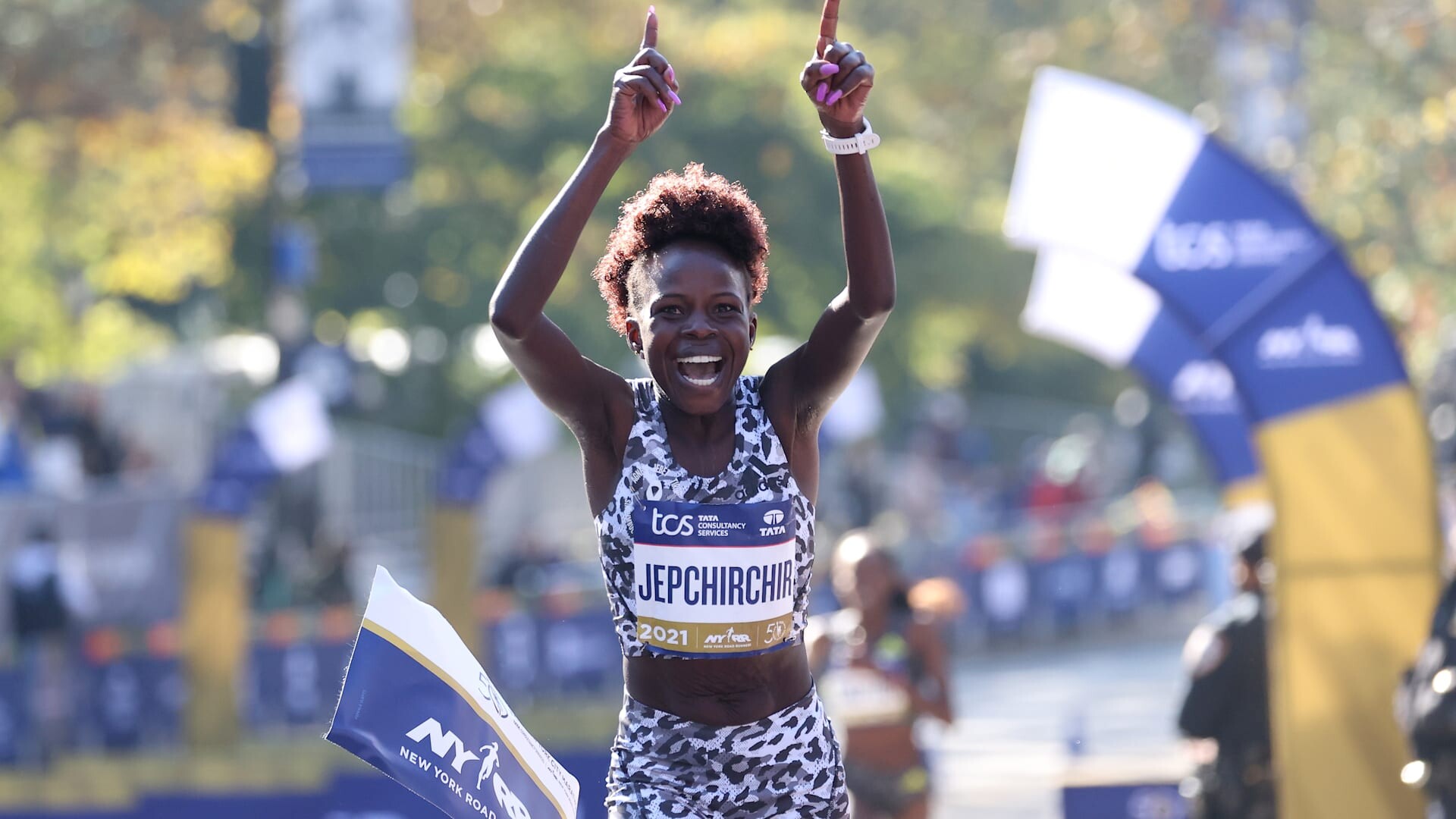
Jepchirchir was a late inclusion in the women’s marathon team for the World Athletics Championships, but withdrew days before the start of the event on July 15 with the advice from Team Kenya physician Victor Bargoria.
“It was disappointing, but I would rather not aggravate the injury since we still have another world event next year before my Olympic title defence at the 2024 Paris Summer Games,” said Jepchirchir, who hopes to use the Great North Run as part of her preparations for her New York City Marathon title defense on November 6 this year.
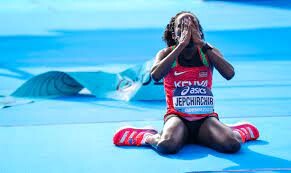
Judith Jeptum went on to claim silver for Kenya in Oregon, clocking a personal best of two hours, 18 minutes and 20 seconds, as Ethiopian Gotytom Gebreslase won the race in a Championship Record time of 2:18:11.
Another Kenyan Angela Tanui settled sixth in 2:22:15 as defending champion Ruth Chepngétich pulled out during the race with stomach problems.
Jepchirchir became the second Kenyan woman to win the Olympic title when she swept to victory in the streets of Sapporo, Japan in 2:27:20 seconds on August 7, 2021.
Kenyan women have won the last eight editions of the Great North Run with Hellen Obiri claiming victory last year in one hour, 07 minutes and 42 seconds.
Women’s world marathon record holder Brigid Kosgei holds the Great North Run course record with her victory of 1:04:28 in 2019.
The 2020 event was canceled due to Covid-19.
(08/23/2022) ⚡AMPby Ayumba Ayodi
Great North Run
Great North Run founder Brendan Foster believes Britain is ready to welcome the world with open arms after the launch of the event's most ambitious plan to date. The Great World Run campaign seeks to recruit one runner from every country in the United Nations – 193 in total – to take part in the iconic half marathon in...
more...Three ways to loosen your piriformis for your best performance
If you sit in an office chair all day, you probably have tight hips, a problem that affects many runners. Tight hips may lead to pain and tension in your piriformis muscle, which can affect both your enjoyment of your run and the quality of your workout. (It may even lead to more serious injury.) Here are some ways to loosen up the area and activate your piriformis muscle, which can be done both before and after your run.
The piriformis is a muscle in the gluteal area which lies deep in the gluteus maximus. When it comes to running, the piriformis muscle carries the large responsibility of stabilizing the hip joint and moving the thigh in various directions.
1.- The modified runner’s lunge

This exercise is called a crescent lunge, which provides a deeper stretch to the hips, glutes and thighs. You can do it from standing or go into it from one knee.
Start by bringing your right leg into the air, drawing it in through your centre of gravity and plant your foot between your hands. Make sure your right knee is not going past your ankle. Allow your back left knee to drop to the ground, resting the top of your left foot on the ground.

Keep your core engaged and body upright. Push into your left hip, with both hips pointing straight ahead. You should feel the stretch at the top of your hips. (Do both sides.)
2.- 90/90
The 90/90 stretch is a staple for improving your hip mobility. During this movement, you’ll rotate one hip externally and the other hip internally, creating two 90-degree angles with your legs.
Sit on the floor and bend one leg in front of your body with your hip rotated outward. Position it so your lower leg and knee are resting on the ground, and your ankle should be at ease, with your foot pointing straight ahead. Position your other leg beside you, with your hip rotated inward and your shin and ankle on the ground.
To enhance this stretch, ensure your back knee is in line with your hip, and your ankle should be neutral. Keep your back straight and resist the urge to bend to one side. Think about sitting into both hips equally and easing the lifted hip straight down toward the floor.
Hold for 20 to 30 seconds on each side.
3.- Supine piriformis stretch
To begin this stretch, lie down and bend your knees upward, then cross one leg over the other, bending it upward toward your chest.
Grab your knee with one hand and your ankle with the other, then pull the bent leg across your body until your glutes are pulled tight.
Hold this stretch for 30 seconds, then release.
(08/23/2022) ⚡AMPby Marley Dickinson
Kilian Jornet and NNormal launch their first trail shoe
Kilian Jornet calls the Kjerag "a shoe that can be used for everything from a VK to a 100-mile race”
The Kjerag [pronounced: sche-rak], a trail running shoe and the first product launched by ultrarunning phenom Killan Jornet’s brand NNormal. The Kjerag is named for a 1,100-metre-high mountain in Norway, which can be conquered by running up challenging trails or tackled via some moderate hiking.
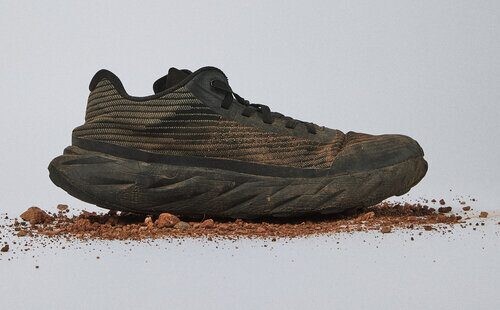
The made-for-everyone versatility of the mountain inspired the name of the shoe, touted as being made for every runner at every level. At 200 g, the Kjerag is a lightweight shoe boasting unique shock absorption and stability, with a stack height of 23.5 mm and a heel-to-toe offset/drop of 6 mm.
The design team at NNormal worked with Jornet to create a shoe that’s made to be versatile enough to switch between road running and scrambling up technical trails.
Jornet explained in a press release on Monday: “Our goal with Kjerag was to find the highest-quality materials, cutting-edge technologies, planet-friendly production processes–the best of everything. Then to bring them together in a shoe that can be used for everything from a VK (vertical kilometer) to a 100-mile race.”

The Kjerag has a generous front volume to provide comfort for runners tackling long races or trekking through hot days. Jornet has been test-driving the shoe throughout the 2022 season. “You forget about them when you run,” he reports. “They follow the natural movement of the foot, which helps prevent muscle fatigue and blisters. The shoes adapt to you.”
The Kjerag has a super-sticky, extra durable Megagrip Vibram sole, with 3.5 mm lugs intended to prioritize speed and allow sensitivity to the terrain. The shoe boasts a “new generation of foam” with its EExpure midsole, sitting in direct contact with your feet via a very thin membrane. “No inner sole means best-possible propulsion and compression, less slippage and fewer blisters,” explains NNormal.
NNormal will be launching a range of apparel and accessories alongside the Kjerag that align with the same principles: lightweight and breathable attire made for both intense and less strenuous activities at every level. All the clothing designs are intended to be both timeless and durable.
A shoe as all-encompassing as the Kjerag is hard to imagine, and it will be interesting to see if regular runners find the trail runner as versatile as NNormal claims it to be.
(08/23/2022) ⚡AMPby Running Magazine
Keira D’Amato Will Attempt to Lower Her American Record at Berlin Marathon
After winning the Falmouth Road Race on Sunday morning, Keira D’Amato confirmed that she will be running the Berlin Marathon on September 25 in an attempt to lower her own American record.
D’Amato set the current record of 2:19:12 in Houston in January, eclipsing Deena Kastor‘s 16-year-old American record of 2:19:36.
“I think I can run faster than I did in Houston, and I’m going to go to try to prove it in Berlin,” D’Amato told Citius Mag after Falmouth, confirming what many insiders expected as she wasn’t listed in the NY or Chicago elite fields and former NY elite athlete coordinator David Monti had previously tweeted out (but then deleted) that D’Amato was headed to Berlin.

This will be D’Amato’s second Berlin Marathon. In 2019, she finished 17th in 2:34:55 in what was then a PR of more than six minutes. This time around, she will be looking to run more than 35 seconds per mile faster.
As the American record holder, D’Amato would have attracted a hefty appearance fee from either of the two American major marathons this fall, Chicago and New York. She also would have had more time to recover from her last marathon, an eighth-place finish at the World Championships on July 18 (there are 10 weeks between Worlds and Berlin; there are 12 weeks between Worlds and Chicago and 16 between Worlds and NYC).

But D’Amato typically bounces back quickly between races — she won Falmouth less than five weeks after Worlds — and did not log a full buildup for Worlds as she was named as a late injury replacement for Molly Seidel barely two weeks before the championships. Additionally, American records result in big endorsement bonuses from shoe sponsors.
Berlin has become the go-to course for world record attempts in recent years, as it has hosted the last seven men’s world records and was also the venue of choice for Shalane Flanagan‘s American record attempt in 2014 (Flanagan fell short of the AR but still ran her lifetime best of 2:21:14). But three of the last four women’s world records have fallen in Chicago, including the current mark of 2:14:04 set by Brigid Kosgei in 2019. Either would have been fine options for an American record attempt; the better option may come down to weather on race day.
(08/23/2022) ⚡AMPby Jonathan Gault
BMW Berlin Marathon
The story of the BERLIN-MARATHON is a story of the development of road running. When the first BERLIN-MARATHON was started on 13th October 1974 on a minor road next to the stadium of the organisers‘ club SC Charlottenburg Berlin 286 athletes had entered. The first winners were runners from Berlin: Günter Hallas (2:44:53), who still runs the BERLIN-MARATHON today, and...
more...Super star Eilish McColgan takes a much deserved short break but still got in ten miles
"Treated myself to 48hrs of R&R but back to work tomorrow! I say 'rest and recovery' but really it was a mental break. I still did 10 mile this morning on the treadmill," twitted Eilish this morning.

"Few road races on my calendar! So I'll have a proper holiday and a two week break after those!"
Eilish McColgan won the women’s 10,000 metres in Birmingham, setting a new Commonwealth Games record after a stunning last lap in the closing stages of the event.
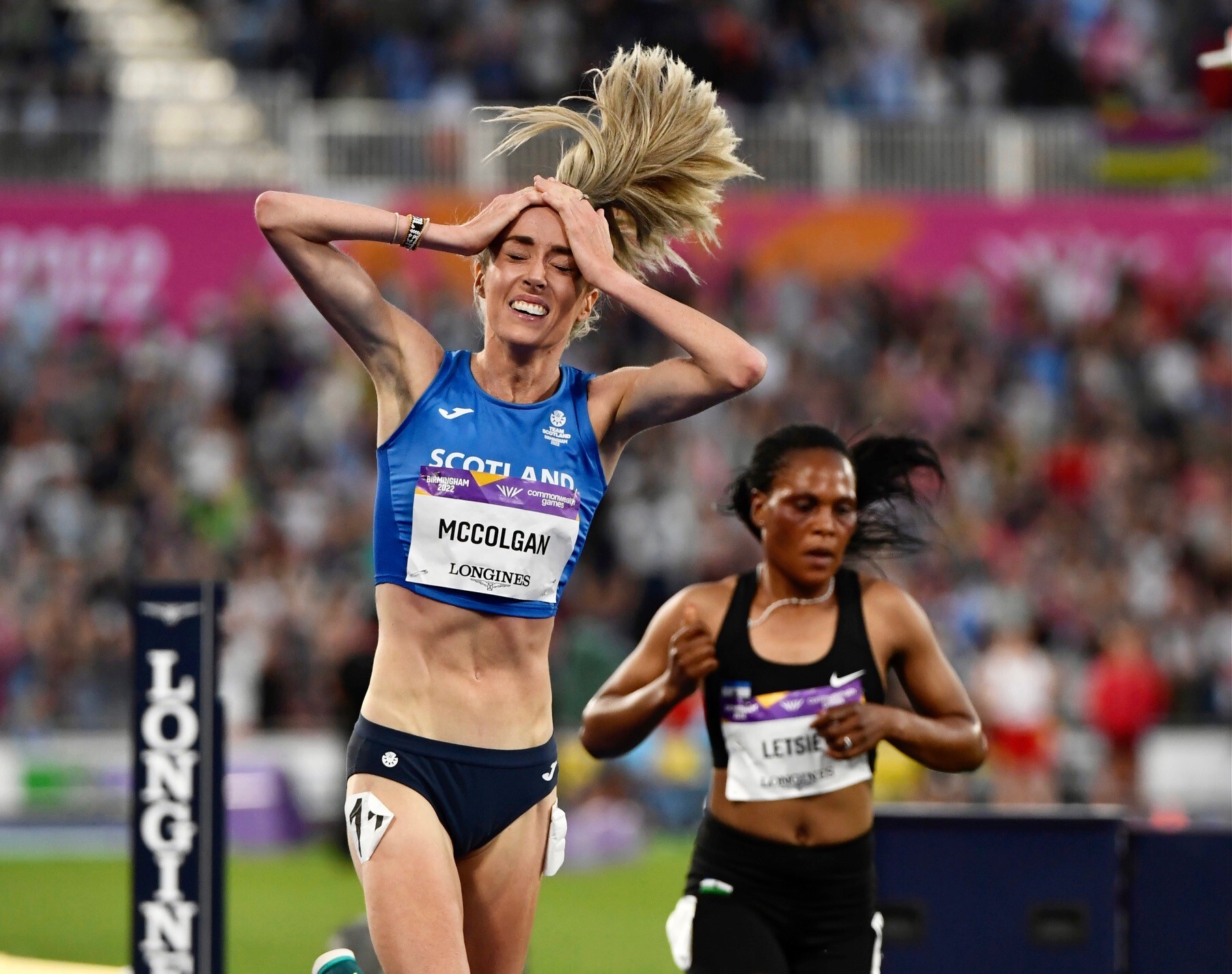
The sold-out crowd of 32,000 at Birmingham’s Alexander Stadium roared as McColgan sprinted to her first gold medal at an international competition. She ran straight to the arms of her mother, Liz, where the two shed tears of joy and triumph, while wrapped in the Scottish flag.
Eilish followed in the footsteps of her mother Liz - Commonwealth 10,000m champion in both 1986 and 1990 - as she recorded the biggest win of her career on August 4.
(08/22/2022) ⚡AMPSelf-reporting is as accurate as blood testing and other objective measurements, new study finds
Researchers determined that you can trust how you feel when it comes to training load, recovery and general well-being.
A study published in the British Journal of Sports Medicine found that athletes’ self-reported info on stress, fatigue and well-being did not line up with information reflected in objectively measured data, such as heart rate response and blood markers; the self-reported data was actually more sensitive and more accurate, not less.

As a regular runner, you may have struggled with conflicting info in your own training: your heart rate is elevated, but you feel great. Should you still go for your run?
Maybe you’ve experienced the opposite, where you feel terrible but there seems to be nothing physiologically wrong with you. It can be hard to determine what information is most important and will help you stay healthy without overtraining.
Researchers reviewed and compared subjective information (self-reporting, including athletes responding to surveys on fatigue or general well-being) and objective data (measurements including heart rate, blood markers, oxygen levels), both to see whether the responses correlated and which type of information was most useful.

Athletes’ self-reporting consistently accurately reflected training load–general well-being was impaired with a large increase in training load and improved with a reduction.
While the study recognizes that it was limited in not being able to take non-training stressors into account (for example, work or family stress that may influence how an athlete feels), the results determine that self-reporting is a useful and reliable tool for both coaches and athletes.
The researchers explain: “given that subjective measures reflect changes in athlete well-being and provide a practical method for athlete monitoring, coaches and support staff may employ self-report measures with confidence.”
The takeaway for regular runners
Blood markers, heart rate variability, and VO2 max measurements can all be useful and informative ways to track how your body is handling your training load, or the amount of physical stress you are putting on it.
Self-reporting, however, is more accurate than physiological measurements and can be relied upon as a reflection of how you are doing. As a regular runner, you may not have access to the objective data that elite athletes do, and you don’t necessarily need it.
Paying attention to how well you feel on a regular basis, and occasionally doing a self-assessment of how rested and energized you are is an accurate way to determine how hard you should run or train.
(08/22/2022) ⚡AMPby Keeley Milne
Spain’s Mariano Garcia Runs Smart Race To Win Thrilling European 800m Title
On the final evening of the 25th European Athletics Championships at Olympic Stadium here, Spain’s Mariano Garcia and Italy’s Yemaneberhan Crippa captured the final two distance medals on offer. Garcia, who won the world indoor title at 800m last March, added the European outdoor title here tonight in a personal best 1:44.85. Crippa, who won the bronze medal in the 5000m five days ago, won the 10,000m in 27:46.13. He became the first Italian man to win the European 10,000m title in 32 years.
Although he came into the race as the current world indoor champion, Garcia wasn’t the favorite for gold. He had never broken 1:45 –either indoors or out– and he was faced with the daunting challenge of beating reigning world 1500m champion, Jake Wightman of Great Britain. Wightman, who stepped down in distance for these championships after running the 1500m at both the World Athletics Championships and Commonwealth Games, said before these championships began that he was particularly motivated to compete well here.
“Coming here to do the 800 is just something I’m actually excited to do,” Wightman said. He continued: “I want to show I can be as competitive over eight as fifteen.”
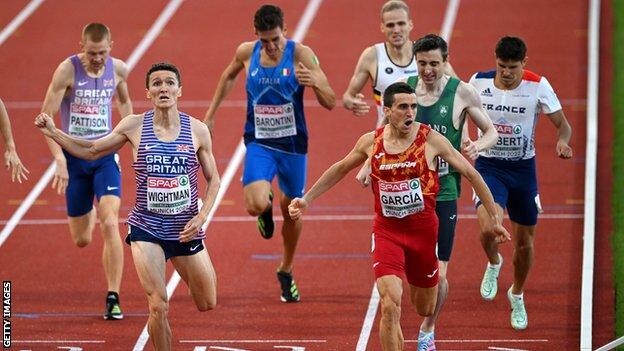
And indeed, he was. Running an intelligent race, Wightman let Garcia lead at 400 meters (52.07). The Scotsman sat in the main group with Ireland’s Mark English and his British teammate Ben Pattison and continued to stay slightly behind Garcia through 600 meters (1:18.59). Wightman was where he wanted to be.
“I was just ready to race and did not care too much about the splits,” Wightman told the European Athletics mixed zone team. “It was more about the position in the race to get medals.”

Coming around the final bend Garcia had the slightest of leads, but he was running on the rail and had the shortest line to the finish. English was also well-positioned behind Garcia, while Wightman was out in lane two and also had Belgium’s Eliott Crestan to pass who was between him and Garcia. The Spaniard’s strategy of leading in the second half was about to pay off.
“When I decided to take the lead, I knew I had to give it my all,” Garcia said. “Because towards the end of the race, that’s when you have less energy, so I need to get this right.”
In the final 100 meters Wightman was able to make it close. He got ahead of English and was closing down Garcia but just couldn’t catch him before the line. Only 6/100ths of a second separated them, and Wightman got silver in 1:44.91.
“I was very close to the gold, and I would be very glad to get that, but still I am pretty happy with the silver,” Wightman said. “I was not quite close enough in the last straight and it is tough when you are not that close with a strong opponents.”
English, who won the bronze medal at his first European Championships in 2014, got the bronze in 1:45.19.
“I am really pleased to get the bronze medal,” English said. “I can’t really ask for more.”
Sweden’s Andreas Kramer nearly caught English and finished fourth in 1:45.38. He was in last place with 110 meters to go in the race.
Crippa’s victory was achieved by a fast start, a slow middle and a fast finish. France’s Jimmy Gressier decided to attack the field right from the gun, running an improbably-fast first lap of 61.6 seconds. The Frenchman said that he felt most comfortable going hard from the gun.
“I go fast because it’s my best strategy,” Gressier told Race Results Weekly in English. “I like (to) run fast. It is the same as cross country; I like to push the run.”
The field immediately strung out. Gressier had Britain’s Marc Scott and Turkey’s Aras Kaya right on his heels through 3000m (8:09.9), and the leaders were on pace to run 27:13. Scott expected Gressier to push early and was ready for that.
“I thought he’d do something like that just knowing the type of character he is,” Scott told Race Results Weekly. “But it’s nothing most of the field can’t handle because we all knew it was going to come back.”
Indeed, when Scott took over the lead at 3600 meters, lap times fell to the 70-second range and the field bunched up again. France’s Yoann Kowal tried a solo breakaway but by 4800 meters he was absorbed. Kaya was the nominal leader at 5000m (13:54.2) with Crippa and Scott right behind. Crippa, who won the bronze medal at the 2018 edition of these championships, was feeling confident.
“Compared to fours years ago, in Berlin 2018, I feel I have changed a lot – especially my mindset,” he said. “I am much stronger mentally than I was in the past.”
He used that mental strength to hold back in the second half of the race. He led for five laps through 8400 meters averaging a not-too-fast 67 seconds per lap. He didn’t immediately react when Norway’s Zerei Kbrom Mezngi took the lead at 8800 meters and built up a small lead over Crippa, Gressier, Britain’s Emile Cairess, and France’s Yann Schrub. Instead, he waited for the final 200 meters to try and catch the tall Norwegian. The crowd roared as Crippa began to close from at last 50 meters back.
“I believed in myself, and I knew I could do what I did tonight,” Crippa said.
With about 80 meters to go, Crippa passed Mezngi to seal the victory. Mezngi held his speed and got the silver in 27:46.94, a personal best, while Schrub managed to pull away from Gressier and get the bronze in 27:47.13, also a personal best.
“I kept some energy and was able to use it on the last meters,” said Schrub, who is a medical student. “I would have never thought that I could win a medal today.”
(08/22/2022) ⚡AMPby David Monti
European Athletics Champioships Munich 2022
European Championships Munich 2022 will be the biggest sports event in Germany since the 1972 Summer Olympics. From 15-21 August 2022, European sport will be united as its best athletes compete for the highest accolade of their sport on the continent – the title of ‘European Champion’. The second edition of the European Championships will feature nine Olympic sports:Athletics, Beach...
more...Kenya's Hellen Obiri to train in US for New York Marathon
World 10,000 meters silver medalist Hellen Obiri plans to travel to America ahead of time before making her debut in New York Marathon race on November 6.
In an interview with Nation Sport, the double 5,000m world champion said that she will be heading to Colorado, USA to acclimatize.

Obiri said that she will be depending on her new coach Dathan Ritzenhein, who heads On Athletics Club, for guidance.
Ritzenhein is a former athlete who has previously competed in the New York Marathon.

Obiri, who has plans to relocate to the US, said that she is not moving yet.
“There is still some paperwork that I’m working on before finalizing my move to the US. But, I will be going to Colorado for training because I want to acclimatize before the race. I look forward to a good race, but the most important thing for me is to learn,” she said.
The World Athletics Cross Country Championships title holder, who has been training in Ngong, Kajiado County, said that when she stepped up to marathon racing, it was not easy because the training is different.
“Marathon training is different from what I was used to while competing in track races. At fast it was tricky, but I persevered and I am now used to it,” she said.
The Olympic 5,000m silver medalist said that she was inspired to switch to marathon by two-time world marathon champion Edna Kiplagat.
“I was really inspired by Edna Kiplagat who has been doing well for long and is still competing. I have interacted with her, and when I learned that she was part of the elite field at New York Marathon, I felt encouraged that she will be racing with me,” said Obiri.
“Before the competition, I look forward to train with Edna in the US.”
The Istanbul Half Marathon champion said that she took a leap of faith to compete in full marathon after performing well in half marathon races.
Obiri clocked 64:38 to win this year’s Istanbul Half Marathon after having triumphed in the same race last year in 64:51.
The former 5,000m African champion has had a good season which climaxed in her winning a 10,000m silver medal at the World Athletics Championships in Oregon, USA on July 16.
In New York, Obiri will be up against defending champion and Olympic marathon champion Peres Jepchirchir, Edna, debutante Sharon Lokedi, Caroline Rotich and US-based Viola Lagat, who was second last year.
Other top names in the race are newly crowned world champion Ethiopian Gotytom Gebreslase and her compatriot Senbere Teferi, world bronze medalist Israel’s Lorna Chemtai Salpeter, USA’s Sara Hall and Aliphine Tuliamuk.
(08/22/2022) ⚡AMPby Bernard Rotich
TCS New York City Marathon
The first New York City Marathon, organized in 1970 by Fred Lebow and Vince Chiappetta, was held entirely in Central Park. Of 127 entrants, only 55 men finished; the sole female entrant dropped out due to illness. Winners were given inexpensive wristwatches and recycled baseball and bowling trophies. The entry fee was $1 and the total event budget...
more...Ben Flanagan wins his third Falmouth Road Race
Kitchener, Ont. native Ben Flanagan has done it again, winning his third Falmouth Road Race in four years. Flanagan finished the seven-mile (11.3 km) course in 32:25, outlasting runner-up Biya Simbassa (32:32) for a second straight year in Falmouth, Mass.
With two Falmouth victories to Flanagan’s name, and his partner, Hannah, growing up in Falmouth, he was the race favourite heading in and was keen to defend his 2021 title. In a pre-race interview, Flanagan chatted about his familiarity with the course and how he was already dreaming of his celebration when he won his third.
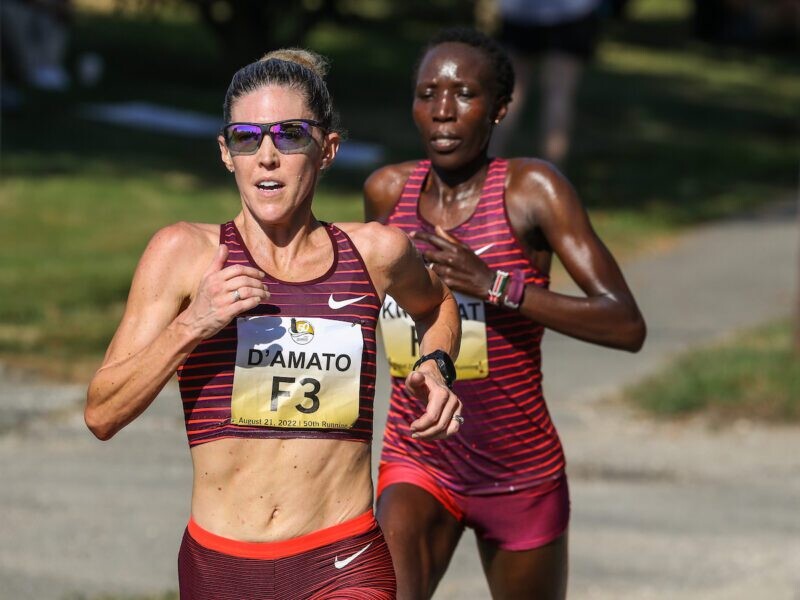
Like in previous years, the 27-year-old broke the tape by jumping into it, holding up the “number three” with his hand.
Flanagan again made his attack at the top of the Scranton Ave. hill at the 5.5-mile marker. Simbassa, who lives and trains in Flagstaff, Ariz., followed Flanagan’s move along with David Bett of Kenya. The Canadian 10K record holder ousted Bett and Simbassa on the final downhill to win, nine seconds shy of his personal best on the course: 32:16 from 2021.

Flanagan now joins an exclusive group of six runners to successfully defended their titles at Falmouth. The group of six features: Alberto Salazar (‘81 and ‘82), Frank Shorter (’75 and ’76), and David Murphy (‘84 and ‘85). Next year, he will have the chance to join Kenya’s Gilbert Okari as the only men to win three straight (2004-06)
The American women’s marathon record holder, Keira D’Amato, won the women’s 11.3 km race in a nail-biting finish (36:14). She managed to hold off a surging 2017 Boston Marathon champion Edna Kiplagat (36:28) to claim the women’s title in her Falmouth debut.
This race was a quick bounce back for the 37-year-old, who placed eighth at last month’s 2022 World Athletics Championships marathon for Team USA in 2:23:34. Earlier this year at the Houston Marathon, D’Amato set the U.S. marathon record of 2:19:12.
D’Amato will take another stab at breaking her American marathon record on Sept, 25. at the Berlin Marathon.
Daniel Romanchuk won the men’s wheelchair title in 22:02, and Susannah Scaroni won the women’s division in 25:30.
(08/21/2022) ⚡AMP
by Marley Dickinson
Falmouth Road Race
The Falmouth Road Race was established in 1973 and has become one of the premier running events of the summer season. Each year the race draws an international field of Olympians, elite runners and recreational runners out to enjoy the scenic 7-mile seaside course. The non-profit Falmouth Road Race organization is dedicated to promoting health and fitness for all in...
more...Does the 80/20 Rule Apply to Low-Mileage Runners?
Even those running less get faster in races when abiding by this golden ratio of training intensity.
The well-known 80/20 rule of intensity balance stipulates that runners should aim to spend about 80% of their weekly training time at moderate intensity (i.e. at a pace at which you can comfortably carry on a conversation) and about 20% at moderate to high intensity. This ratio was first observed in elite endurance athletes by exercise physiologist Stephen Seiler in the early 2000’s. His research found that the 80/20 rule is followed almost universally by top-level runners, cyclists, swimmers, triathletes, cross-country skiers, and rowers around the globe.

But it wasn’t always. Historical analysis has shown that elite endurance athletes of the mid-20th century and earlier did not train this way. Because today’s top athletes are a lot faster than those of earlier generations, Seiler believes that an 80/20 intensity balance is optimal for them, yielding better results than any alternative.
The thing about elite endurance athletes, though, is that they train at very high volumes. So it’s natural to ask whether the same ratio is also optimal for non-elite athletes who train at lower volumes, or whether these athletes are better off spending more time at higher intensities to make up for training less. If you only run three times per week, for example, should each run be equivalent to one of an elite’s harder workouts, since you took a day off when the elite was putting in more long easy miles and so you’re ready to roll hard again?
Seiler and other scientists have not only asked themselves this very question, but also addressed it in controlled studies. In one such study, 30 club runners with 10K times just under 40 minutes were divided into two groups and placed on separate training programs for nine weeks. One group adhered to an 80/20 intensity balance while the other hewed to a 50/50 ratio, which is actually what most recreational runners do. All of the runners completed 10K time trials before and after the training period.
On average, members of the 80/20 group improved by 5% and members of the 50/50 group improved by 3.6%. This seemingly small difference in percentage improvement translated into a 35-second difference on the clock. And when the authors of the study looked at the six individuals in the 80/20 group who did the best job of adhering to the prescribed ratio, the performance improvement jumped to 7%, equal to an additional an 12-second lowering of 10K times.
The runners in this study ran just over 30 miles per week, or slightly less than the typical self-described “recreationally competitive” runner does, according to one survey. Thus, we have pretty solid evidence that if there is a threshold of training volume below which the 80/20 rule no longer applies, it’s under 30 miles per week. Additional research is needed to find out exactly how much lower this threshold might lie.
As a coach, I encourage runners who log substantially less than 30 miles per week and want to improve their race times to stick with an 80/20 balance and run more rather than try to make up for running less by spending more time at high intensity. It is true that, minute for minute, high intensity yields bigger improvements in aerobic capacity than lower intensity. But this doesn’t mean that high intensity can completely substitute for low intensity.
No amount of high-intensity interval training, for example, will give you the endurance you need to complete a marathon. Regardless of how little you train, it’s important that you balance your workouts in a way that develops all of the fitness components you need to race successfully (assuming that’s your goal).
Recently I asked Stephen Seiler — a former competitive rower and cyclist who still keeps fit — how he would approach his own training if he were confined to the extreme low end of the volume spectrum. “If I could only train two times a week,” he replied, “I would probably end up combining some high-intensity and low-intensity work in both sessions, aiming to try to stimulate every muscle fiber I could, as much as I could!” As you see, even in this extreme scenario, the person who knows more than anyone about optimizing intensity ratios would not go all-in on high intensity.
It should be added, however, that Seiler would never voluntarily train just twice per week in the first place if he intended to race, nor choose to race if he could only train twice per week — and I hope you wouldn’t either!
(08/21/2022) ⚡AMPby Outside
Matt Hudson-Smith wins 400m gold in the European Championships
Matt Hudson-Smith continued his hugely impressive season by winning 400m gold at the European Championships in Munich last night, retaining the title he won in Berlin in 2018.

By doing so he made history by becoming the first British athlete to win three major medals in three different outdoor championships in the same year, after taking World Championships bronze in Oregon in July, followed by Commonwealth silver in his home city of Birmingham earlier this month.

The 27-year-old sprinter ran a pretty much flawless race, moving clear of the pack on the closing bend before extending his lead in the home straight to win in 44.53 seconds, securing Great Britain and Northern Ireland's first gold medal of the Championships.
Another Briton, Alex Haydock-Wilson, took bronze in 45.17. Separating them was Ricky Petrucciani of Switzerland, who came second in 45.03.
(08/20/2022) ⚡AMPby Andy Dixon
European Athletics Champioships Munich 2022
European Championships Munich 2022 will be the biggest sports event in Germany since the 1972 Summer Olympics. From 15-21 August 2022, European sport will be united as its best athletes compete for the highest accolade of their sport on the continent – the title of ‘European Champion’. The second edition of the European Championships will feature nine Olympic sports:Athletics, Beach...
more...Laura Muir Storms To European 1500m Title
With a savage move about 25 meters before taking the bell, Britain’s Laura Muir overwhelmed the field here at Olympic Stadium tonight and successfully defended her European Athletics 1500m title. Muir, a Scotswoman, ran the final lap in 60.4 seconds and won in 4:01.08. Her victory tonight came just 12 days after she won the Commonwealth Games title at the same distance.
“Physically I’m not too bad, but mentally, oh my God that was hard,” Muir told reporters. “I’m used to feeling tired, I’m used to training and racing, but that was something else.”
When Muir, 29, consulted with her coach Andy Young before the race they both agreed that her ability to jump the field late in the race was her best weapon. So, she immediately dropped to the back of the twelve-woman field after the gun to save energy, then waited for two laps to go before moving to the front. Ireland’s Ciara Mageean shadowed her closely, and Poland’s Sofia Ennaoui tried to stay close. Muir was only just beginning her wind-up.
“Speaking with Andy, we knew I could run the last lap faster than anybody else,” Muir explained. “So, if I was tired the best –the safest– way to run it was to do that.”

But Mageean would not give up so easily. She had planned for this exact kind of race.
“It’s funny visualizing different types of races, and in my 20 minute warm-up that’s exactly what I visualized,” Mageean told Race Results Weekly. “Laura’s probably going to go, and in my mind she’s going to go a little sooner than at Commonwealth Games; she’s going to go earlier, which she did. I said to myself, you be her shadow.”
Coming down the homestretch the penultimate time, Muir switched on the afterburners even before getting to the bell. Mageean reacted immediately and stayed close, but Ennaoui was too far back to catch up (she would have to settle for bronze in 4:03.59). Mageean was still close as she and Muir rounded the final bend, but Muir was just too fast.

“I thought going up the home straight that maybe I was going to have her, but she’s just got a little bit more strength than me,” said Mageean, who ran a season’s best 4:02.56. “Laura’s a 3:55 runner and I’m just not there yet.”
With her gold medal tonight, Muir won medals at all three of this summer’s major championships. At the World Athletics Championships in Eugene she took bronze in the 1500m, and at the Commonwealth Games she won the 1500m and took bronze in the 800m.
“I really wanted to win; to get a medal at Worlds as well I’m so pleased,” Muir said.
There was more success for the British team today in the semi-finals of the 800m.
During the morning session all the medal favorites advanced to the final of the women’s 800m, including all three British women who ran today. In the first of two heats, Olympic and World Championships silver medalist Keely Hodgkinson got the win in 2:00.67 and confirmed her status as the gold medal favorite. She finished comfortably ahead of Poland’s Anna Wielgosz (2:01.05) and Ireland’s Louise Shanahan (2:01.15).
“I’m just really happy to have got through,” Hodgkinson told the British Athletics media team. “I’m tired, but I’m taking it race by race. I could have taken it on, but the Polish girl set the pace which certainly helped me, so I’m just pleased to have got the job done.”
Frenchwoman Renelle Lamote narrowly won the second heat over Hodgkinson’s British teammate Jemma Reekie, 2:00.23 to 2:00.30. A third British woman, Alex Bell, got third in 2:00.53 putting three British women into the final.
“It’s great to see all three of us through,” said Bell who finished sixth in the Commonwealth Games 800m. “I think even though I have been racing for so long, it’s only been this season that races are stressing me less when it gets bargy and clumpy and trippy. In the past I have panicked at that point, so I am just conserving more energy, because the more composed you are the more energy you save.”
Much to the delight of the German fans here, Christina Hering advanced on time by finishing fourth in the second heat in 2:00.86.
“WOW,” Hering wrote on her Instagram just after the race. “Home crowd gave me wings.”
In the men’s 800 semi-finals tonight, reigning world 1500m champion Jake Wightman advanced to the final by going from fifth place to second place in the homestretch of heat two, stopping the clock in 1:46.61. The Scotsman finished behind Spain’s Mariano Garcia (1:46.52) and just ahead of Ireland’s Mark English whom Wightman passed in the final 20 meters.
Although he made the final, Wightman wasn’t happy with his performance.
“I didn’t run good there,” he told the British Athletics media team. “I think the one thing I am taking from it is I must be pretty fit because tactically I was all over the place, but I was still able to get through. I hope I don’t get lane one in the final as I didn’t run too well from there.”
The first heat went slow, and Poland’s Patryk Dobek (the 2021 Olympic bronze medalist) only managed to finish fourth in the final sprint and did not make the final. Instead, Sweden’s Andreas Kramer (1:48.37), Italy’s Simone Barontini (1:48.51) and France’s Benjamin Robert (same time as Barontini). Moved on to the final. Kramer performed a deft move in the final 50 meter, slicing through the center of the field to get the win.
“I just waited for it, because I didn’t want to disturb anyone,” Kramer told Race Results Weekly. “Just kicked and waited for the small opening. Then when it came, I just went for it.”
In tonight’s other medal event within the distance disciplines, Finland’s Topi Raitanen fended off a triple attack from the Italian twins Osama and Ala Zoghlami and their teammate Ahmed Abdelwahed. Raitanen, 26, helped set the early pace then allowed the Italians to lead the final laps before making his bid for victory.
“My strategy was to keep a decent pace, and everybody’s happy and nobody wants to push harder, so I saved some energy for the last laps,” Raitanen told Race Results Weekly. “Italy guys, really strong guys, started to push the pace and I just knew that I needed to follow them and keep up, and just wait the last lap so everything is possible.”
Coming down the backstretch on the final lap, Raitanen moved to the lead then carefully took the final water jump. He began to sense that victory would be his.
“After the last water jump I saw a small gap behind me and I really can take the medal,” he said. “I was just taking it really, really carefully and not fall down. A couple of meters and I was watching the screen and I still had a small gap behind me and I know I can win.”
(08/20/2022) ⚡AMPby David Monti
European Athletics Champioships Munich 2022
European Championships Munich 2022 will be the biggest sports event in Germany since the 1972 Summer Olympics. From 15-21 August 2022, European sport will be united as its best athletes compete for the highest accolade of their sport on the continent – the title of ‘European Champion’. The second edition of the European Championships will feature nine Olympic sports:Athletics, Beach...
more...Include some intervals into your trail runs to improve your speed
Becoming a faster trail runner is not easy, but have you tried taking your interval workouts to the trails? Mixing in some different terrain can not only help you become a better trail runner, but it can translate to faster times on the roads.
On the trails, you have the option to make the workout as hard (or easy) as you want. Take your interval workout to a more technical trail or singletrack path to help you improve your strength and cadence.
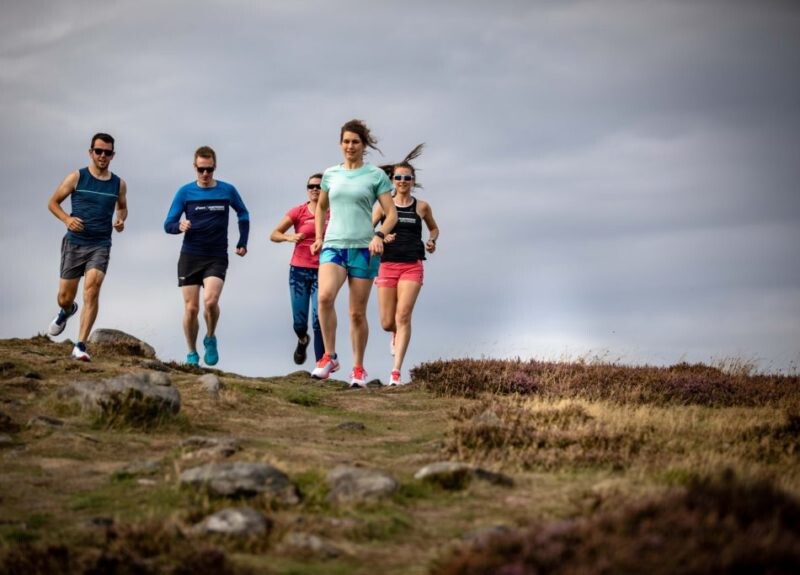
The workout
10 to 15 reps of one-minute fast and one-minute jog
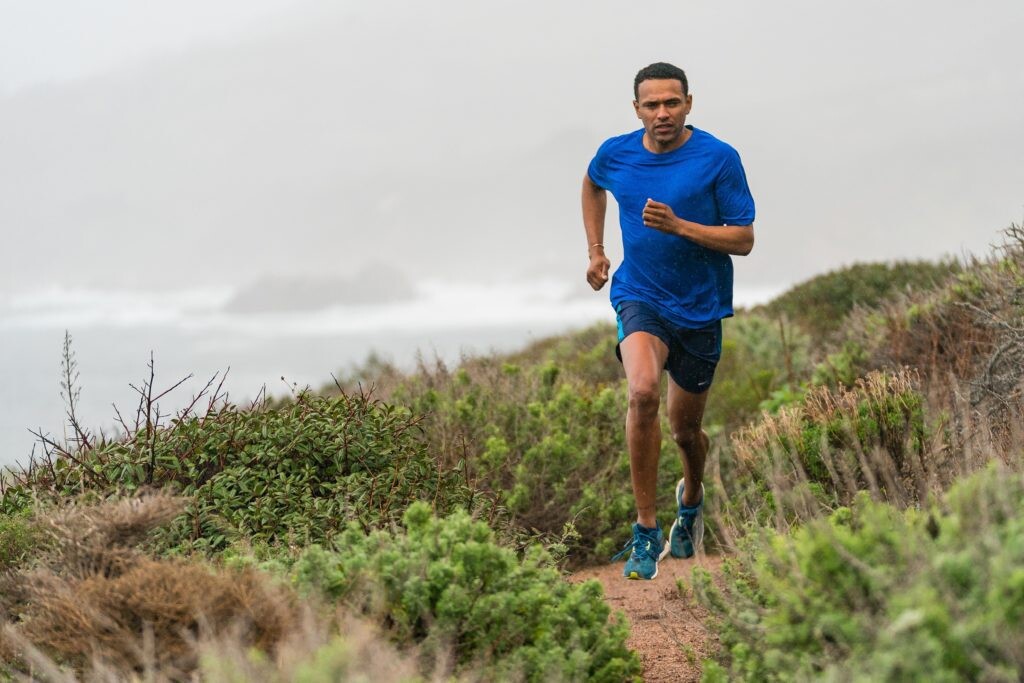
The idea behind this short interval workout is simple: run at your perceived 5K goal pace for one minute, followed by one minute of easy slow jogging, and repeat.
The up and down terrain will make this short speed workout feel tougher than it is. Try to keep a cadence of 175 strides per minute or higher, altering your pace and cadence to the gradient. The short active rest combined with faster intervals will challenge your endurance and strength.
Since the intervals are short, it is easy to get carried away on the first three or four reps, but the key to doing this workout is managing your speed in the early intervals, so you’re able to pick up the pace later on. Ideally, you should do at least 10 reps, but if you’re training for anything over 10K, you should do 12 to 15 reps.
(08/20/2022) ⚡AMPby Marley Dickinson
This Siberian Yupik Ultrarunner Is Ready To Take On Leadville
Just 170 miles from Russia, Nome, Alaska is perhaps best known as the finish line for the Iditarod Trail Sled Dog Race. Nome's population is near 3,500, but grows in the summer with an influx of gold dredgers and panners.
Crystal Toolie is a Siberian Yupik ultrarunner from Nome, and is one of five Indigenous runners in this weekend's Life Time Leadville Trail 100 Run presented by La Sportiva. In Nome, Siberian Yupik peoples are from the villages of Gampbell and Savoonga on Saint Lawrence Island (164 miles west), off the coast of Alaska. Even here, they're a relatively small community compared to other Alaska Natives.

Training in Nome harbors unique challenges that develop spades of endurance and strength.
Training in Muskox Country
"It's a very isolated town. This year, we've had a lot more [brown] bears. And we have [musk oxen]," said Toolie. "So if you're a runner and you train outside, you have to be aware of your surroundings." The small but supportive running community in Nome leans on social media to update each other on bear and other wildlife sightings.
"There was one winter when I strictly just ran on the treadmill. It was torturous," said Toolie. "There are other years that no matter what the temperature or if there's a blizzard out, I made sure to get outside and run."
Blizzard conditions are commonplace in remote Alaska, making appropriate gear mandatory. "I would wear regular running shoes but double up on socks and wear cleats, so I don't slip," said Toolie. "Layers, if it's a blizzard. I would wear snow pants and a winter coat. My inner layer will be something that's sweat-wicking, something to cover up my face and hood. Sometimes goggles, sometimes not. And then wear really good gloves."
In addition to layering, Toolie sticks to Nome's limited road system as a safety measure, making it a priority to be visible during runs. Looking to Leadville, she incorporated hiking local mountains into her training.
"This year, I've been able to get out of the road system and get into the mountains, which is great for training for Leadville," said Toolie.
Running Under the Lights
During winter runs, Toolie has nature's headlamp guiding her way. Best seen just outside of the city, the Northern Lights present colorful bands of greens and whites that illuminate the sky. The lights are generated from electrically-charged particles in the earth's magnetosphere colliding with gases, creating energy in the form of light.
Though beautiful, the lights were sometimes frightening to Toolie as a child.
"Our elders would tell us if you're outside late, when you know you're not supposed to be, making noise, the Northern Lights would come down and steal you up," said Toolie. "And so if you whistle or make loud noises, the Northern Lights dance and become more vibrant. It looks like it's coming down."
Nome-St. Lawrence Island Dance Group
Beyond ultrarunning, Toolie is dedicated to preserving the movements of her culture. Several years ago, Toolie reinstated the Indigenous dance group in the area. Toolie's great grandfather, Nick Wongittillin, was the leader of the first Nome dance group, when he passed away, they stopped. "We all wanted our children to be able to learn about our culture, to be able to pass down that tradition," said Toolie.
Composers set the tone on drums (Saguyak) - constructed from tightly stretched walrus stomach linings from the Bering Sea - based on how they're feeling at that moment. The zen-like movements are reminiscent of Qigong from southeast Asia. Toolie and her relatives even have a particular song dedicated by an elder to their running pursuits.
The women wear regalia that is distinguishable from other Alaska Natives in the region. Traditionally, their dress-like garments have three to four red lines sewn at the bottom, symbolic of the Russian Orthodox influence on the culture. The women wear their hair in two braids with beads sewn into them.
The group performs at local events of celebration and mourning, a way to bring the community together. The elders ensure the dances are appropriately conducted so that the integrity of the movements is consistent over time.
Climate Threats and Commercialism
The Town of Nome sits mainly on permafrost (permanently frozen ground). Permafrost is particularly sensitive to increases in air temperature and changes in snow cover, making it especially vulnerable to climate change. Permafrost stores carbon from life buried years ago. As the permafrost thaws, carbon is converted to carbon dioxide and methane, which hasten climate warming. Generally, climate scientists are finding that the Arctic is warming four times as fast as the rest of the world.
"Climate change is a huge topic when you live in our region. We have generations of hunters that know the land like the back of their hand. When scientists study the Arctic in our area, they will seek out the trained hunters and ask them questions because they know that they are observers of that area," Toolie said.
The hunters and families have noticed changing behavior patterns in the region's polar bears.
"We used to see them more frequently. One would always come up to the East End beach, and it would have to be redirected out of town," said Toolie. "I haven't heard of a polar bear going to Nome for years now."
Lately, commercial fishing and cruise liners have affected the lifelines of local families, too. The cruise industry disrupts the area's food system in the waters and creates challenges for the local fishing industry. In some instances, cruise ships have even dumped human waste on Alaska beaches, Toolie explained.
Moreover, commercial fishing overseen by state governments often harms subsistence family fishers in Nome. These residents store fish and other seafood for the winter to feed their families, not to make a profit.
"Subsistence living is rooted in our culture. We have big families that live in one home. To feed them, you need to hunt, fish, and berry pick for survival," said Toolie. Whaling is also part of that equation.
"I think it's just because people don't understand, don't have an understanding that this feeds communities. It's not done in a way that is disrespectful to animals or the earth. In Native culture, we're taught not to over-hunt or over-pick, and we use everything," said Toolie. "We don't waste what we get. And so I think that's something that would be nice for people who are unfamiliar with our culture to learn about."
This year, at Leadville, she will be paced by fellow Native skier and ultrarunner Connor Ryan. Since this is Toolie's first time taking on Leadville, her approach to the race will be to take it easy. "I'm going to take it slow," said Toolie. "And if I feel comfortable, I'm going to take it slower."
(08/20/2022) ⚡AMPby Trail Runner Magazine
Will Jim Walmsley Be the First American Man to Win UTMB?
Jim Walmsley has always been an outlier among American trail runners.
Not only is he as fast and talented as any ultrarunner the U.S. has ever produced, but he's also been bold and even a little brash about his intentions. His off-the-front racing style is something to be revered-and respected if you're one of his competitors -because the lanky 32-year-old Hoka-sponsored runner from Flagstaff, Arizona, has proven time and time again that it works for him.

On August 26 in Chamonix, France, Walmsley will embark on his latest and most prodigious quest yet: to win Ultra-Trail du Mont-Blanc (UTMB). It's his fourth attempt at trying to follow up on his stated intention of becoming the first American man to win the race, but he's gone to extra lengths this year to prepare for it. It would certainly add to what has already been a great year, given that he and longtime girlfriend Jessica Brazeau got married on May 4 in Silverton, Colorado.
But if Walmsley is going to pull it off this year, he will have to fend off three-time UTMB winner and 2022 Hardrock champion Kilian Jornet, of Spain, among other strong runners in the talent-loaded field.
UTMB has been one of the pinnacle events in the sport of trail running since its inception in 2003. Not only does the course send runners on a grueling 171.5K loop (106.5 miles) around the Mont Blanc massif with nearly 33,000 feet of vertical gain, it also brings together the deepest international field of the year and more hype and media attention-including epic coverage and commentary via livestream-than any other event in the world by far.
One of several top-tier Americans in this year's UTMB field, Walmsley skipped the Western States 100 this year and since June has been living and training in the mountains of the Rhne Alpes region of France near Beaufort, not far from good friend Franois D'Haene, who knows a thing or two about training for big mountain ultras.
Last year, D'Haene not only became the first male runner to win UTMB for a fourth time, but he also became the first runner to win both Colorado's Hardrock 100 and UTMB in the same year.
The Frenchman was crewed and paced by Walmsley at Hardrock in 2021 and was one of the first people to suggest that Walmsley spend a summer training in the French Alps in order to best prepare for UTMB, rather than showing up in Chamonix 7-10 days before as he-and many other American men-have in the past.
Aside from Jornet, who won this year's Hardrock 100 for the fifth time on July 16, the top international runners include Frenchman Aurelien Dunand-Pallaz, the runner-up at UTMB last year; Germany's Hannes Namberger; New Zealand's Scott Hawker; and Spain's Pau Capell, who won the race in 2019.
D'Haene certainly thinks Walmsley is capable of winning UTMB, but points out that there are always numerous capable runners who are contenders and it all depends on how the race plays out. The idea of Walmsley stating his intent out front-that he wants to win UTMB-is more of a bold American approach, D'Haene says, as opposed to a more subtle European style he prefers.
"Just to explain to people, 'I am here to be the first American to win the UTMB,' puts a lot of pressure on him," D'Haene says. "He thinks UTMB, he sleeps UTMB, he eats UTMB, so it's a lot of pressure. If you take the approach that I just want to smash that course and win that race, then it's a lot of pressure. I'm not sure if he'll win or not win, but at least he's training well in the Alps and his confidence is up."
Walmsley has raced UTMB three times already-taking fifth in 2017 but DNF-ing in 2018 and 2021. The fact that no American man has ever won UTMB is irrelevant in the scope of this year's race, but it certainly adds a heightened focus in Walmsley's quest and a brighter spotlight on him before and during the race.
Whereas four American women have won the women's UTMB race a total of seven times-including the 2019 and 2021 champion Courtney Dauwalter-only a handful of U.S. men have made it to the UTMB podium. The highest finish came when when Topher Gaylord and Bradon Sybrowsky tied for second in the inaugural race in 2003.
While Walmsley appears to be the top American this year, it would be foolish to focus on him as the only American capable of winning. Other U.S. runners with momentum and motivation heading into UTMB include Tim Tollefson, who finished second at CCC in 2015 and third in UTMB in 2016 and 2017; Tyler Green, fourth at Western States 100 this year and 10th in the TDS 145K in Chamonix last year; Zach Miller, winner of the CCC 100K in 2015 and sixth and ninth, respectively, in UTMB in 2016 and 2017.
Miller went for broke trying to win UTMB in 2016 and held a 35-minute lead beyond the halfway point. He still led at the 100K mark, only to struggle over the final 50K and wind up sixth. What makes UTMB different, he says, is that the endless string of long climbs and descents demands a more moderate rhythm and effort over the first half of the course so you don't blow up before the race really begins.
"I don't think there's a super-secret code to crack. We've had a number of really good American men run there, it's just we have to have one of them have a good day all day one of these years," Miller says. "It's not anything we can't figure out or accommodate for. I think we've done it in other European-style races. It's just this one has kind of eluded us. I think it's possible that someone is going to have that 'right' day, but you almost have to have to get a little lucky, too."
Tollfeson is coming off three DNFs at UTMB in 2018, 2019, and 2021, and had a tough Western States this year (21st). Miller also DNF'ed at UTMB in 2018 and 2019 and then was away from racing because of injuries. He finished his first long ultra in several years in late June, winning the Andorra 100K to earn his place in Chamonix.
Other Americans in the field include David Laney (third at UTMB in 2015), Jason Schlarb (fourth in 2014), Seth Swanson (fourth in 2015 and seventh at TDS last year) and Sage Canaday (48th at UTMB in 2017), who is back after suffering a pulmonary embolism and a devastating house fire in 2021.
As for Walmsley, his front-running style has helped him snag three Western States 100 titles, three JFK 50 wins, a 50-mile world-best time, a 100K American record and the Fastest Known Time running across the Grand Canyon and back. It also helped him produce a solid 2:15:05, 22nd-place effort at the 2020 U.S. Olympic Marathon Trials.
Most recently, he tore up the trails (and the competition) at the rough and rugged Madeira Island Ultra Trail 115K in Portugal in April. Otherwise is been running in the Beaufortain Mountains with D'Haene and training a lot on a Wahoo bike trainer in France. Two weeks ago, he completed the arduous 114K (71-mile) Ultra Tour du Beaufortain loop with 7,300 meters (25,000 feet) of vertical gain as one of his last big training days.
"I hope Jim can change it this year," D'Haene says. "I hope he will be OK and can run a good race, of course, but it's UTMB and, of course, it's always difficult."
(08/20/2022) ⚡AMPby Trail Runner Magazine
So You Think You’re “Elite”
A new way of classifying athletes aims to quantify the thresholds that distinguish recreational athletes from their trained, highly trained, and elite brethren A new way of classifying athletes aims to quantify the thresholds that distinguish recreational athletes from their trained, highly trained, and elite brethren
“Like monkeys,” a review of the neural and psychological foundations of social hierarchy explains, “we tend to use certain cues, like physical strength, to make status judgments.” This is presumably why running messageboards like Letsrun feature seemingly never–ending debates about the precise thresholds that distinguish “serious,” “sub-elite,” and “elite” runners from the unwashed masses. “Elite,” according to one typical if slightly hyperbolic poster, is “the time that sets a world record and/or wins. Everything else is hobby jogging.”

But figuring out these thresholds isn’t just about pissing contests. As a new paper in the International Journal of Sports Physiology and Performance puts it, “the term ‘elite subjects’ might be one of the more overused and ill-defined terms in the exercise science literature.” That matters, because the results of a training study on semi-fit college students may not apply to Olympic athletes, and vice versa. Beet juice, for example, reliably boosts performance in recreational athletes, but doesn’t seem to help elite athletes to the same degree. The same appears to be true of training with deliberately depleted carbohydrate levels. To interpret the results of an exercise study, you need to know who the subjects were and have a consistent way of classifying them.
That’s the goal of the new IJSPP paper, which comes from a team of prominent sports scientists in Australia, Canada, Spain, and the United Kingdom, led by Alannah McKay of Australian Catholic University. They’ve put together a detailed framework to classify athletes into six distinct categories based on exercise patterns and athletic ability across a broad variety of sports.
It’s an inherently intractable challenge, since the characteristics of, say, well-trained table tennis players, marathoners, and archers are so different. But they’ve tried to make the framework flexible enough to work in different contexts by anchoring it in population statistics. You don’t get elite status by running a certain time or training a certain number of hours; it’s based on where you stand relative to everyone else.
Here are the categories:
Tier 0: Sedentary
~46 percent of the global population
This one is pretty straightforward. If you’re not hitting the World Health Organization recommended minimum level of physical activity—150 minutes of moderate exercise or 75 minutes of vigorous exercise per week, plus a couple of muscle-strengthening activities—then you’re sedentary.
Tier 1: Recreationally Active
~35-42 percent of the global population
In this tier, you’re hitting those WHO guidelines, and may participate in a few different sports or activities, but you’re not focused on training or competing in a specific sport.
Tier 2: Trained/Developmental
~12-19 percent of the global population
Now we’re getting more serious. In this tier, you identify with a specific sport, and you’re probably training three or more times a week for the purpose of competing. You might represent a local club, play in a rec league, or be on the junior varsity high school team.
Tier 3: Highly Trained/National Level
~0.014 percent of the global population
There’s a huge drop-off from Tier 2 to Tier 3: not many people meet the requirements of being highly trained. You’re competing in state- or national-level tournaments and competitions, or perhaps for an NCAA Division II or III team, and you’re training not just for fitness but to improve sport-specific skills. For sports measured in time or distance, you’re typically within about 20 percent of the top performance in the world.
Tier 4: Elite/International Level
0.0025 percent of the global population
At this point, you’re likely training as hard as anyone in your sport trains. You dream of the Olympics (or whatever the pinnacle of your sport is). You might be an NCAA Division I athlete or a member of your national team. You’re probably ranked somewhere between 4th and 300th in the world in your event, and you’re within seven percent of the top performances in the world.
Tier 5: World Class
<0.00006 percent of the global population
This is what I think of as the Spinal Tap tier: a notch above elite. Crunch the numbers, and you find that there are fewer than 5,000 people in the world, across all sports, in this category. To join the club, you’re probably an Olympic medalist, or at least a finalist, or an all-star in a professional team sport. You’re within two percent of the world record or yearly top performance.
The last three categories remind me of the cliché about the Inuit having dozens of words for different types of snow. Put together, tiers three to five total less than a couple hundredths of a percent of the population, so a very rarefied group. But to sports scientists, those distinctions matter. The higher up the ladder you climb, the closer the subjects are to their maximum adaptive potential, and the more likely that any study you try will find no meaningful improvement. Under this microscope, the difference between a good college athlete and an Olympic medalist is substantial.
Of course, there are an infinite number of nuances. If your classification depends on comparison to your peers, then the competitive depth of your sport matters. A lot more people compete in running than in, say, dressage or sailing. In freestyle snowboarding, the authors suggest that you need to be a medalist at a major international event to be in the top tier, while making the final eight puts you in Tier 4. In track and field, making the final (which means placing in the top 8 to 15) at a major international competition puts you in Tier 5, because the competition is much deeper. If you want to dig into these nuances, the paper is freely available to read online.
As for the eternal Letsrun debates about what counts as elite, the paper includes a table of running times that delineate the various tiers based on a combination of Olympic winning times, gap from world record, gap from top yearly time, world ranking, and other measures. To be world class in this formulation, a male marathoner would need to run 2:04:33, and a female marathoner 2:20:01. For elite, it’s 2:12:15 and 2:31:03; for highly trained, 2:27:54 and 2:50:41. Those are pretty lofty thresholds, and I can’t help wishing that there were a few more rungs to climb between “trained” and “highly trained.” For practical classification purposes, I’ll probably stick with the sliding scale I’ve been using for the past few decades: the definition of “fast” is a half-step ahead of me.
(08/20/2022) ⚡AMPby Outside
Camouflaged Speed Work You Can Do Year ’Round
Three types of training that will improve your speed, stride, and stamina, but won’t burn you out.
Long ago, runners and coaches learned that intense speed work (VO2 Max workouts like 400–800m intervals at 3,000m pace) and anaerobic training (lactic acid-producing workouts like 300m repeats at 1500m pace) performed year-round often lead to a plateau in performance and at worst, overtraining and chronic fatigue.

Instead, runners are encouraged to take a break from VO2 Max and lactic acid-producing workouts during their off-season (a.k.a. base, foundational, pre-competition, preparatory phases). Too much intensity in this range can actually damage the mitochondria and aerobic enzymes you’re working to build during the base phases of training.
Many of us, however, worry about losing speed, or at the very least, don’t want to skip our running group’s weekly track workouts. Not to worry. Here are three great ways to maintain speed yet rest the VO2 Max and anaerobic systems:
Leg speed/form training is by far my preferred way to include faster running during the base/off-season phase. In fact, all of my Base plans include leg speed training in the last few weeks as a great way to prep the body for faster running. Runners completing the Base plan find they are very ready for their more intense workouts and enjoy the break from just doing easy runs all the time.
An example of a leg speed/form training workout is 10–15 reps of 10–15 seconds at a fast but controlled effort using excellent running form with full recovery (usually 45–90 seconds) walk or jog. Done 1–3 times per week, this develops great running form, leg turnover and makes the transition to faster workouts later in the training cycle, much easier.
Leg speed/form training is also the safest way to keep doing some faster running while avoiding VO2max and lactic acid-producing training. Each repeat is short enough that you never get winded during the interval nor have to “dig deep” to complete it. Leg speed (aka strides) take very little out of the runner and recovery is very quick.
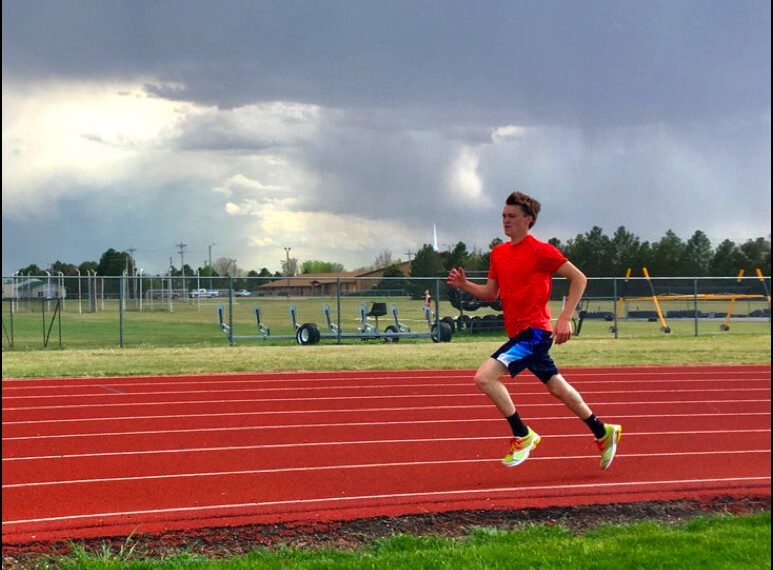
Leg speed/form training works great for inexperienced, young and/or long-distance runners and, completed 1–3 times per week, feed the “need for speed” but don’t stress the musculoskeletal, VO2 Max or lactic acid systems.
Leg speed/form training also works great for runners who lack self-discipline and/or don’t have an onsite coach controlling the intensity of the off-season workouts. These runners often run too fast in less intense workouts and thus turn appropriate off-season training into the stressful workouts that we are trying to avoid.
Lastly, you can easily do this workout alongside your running mates who may still be doing more traditional speed workouts. Warm-up with them and then do your strides on the track as you cheer them on. Win-win.
Hill sprints are another popular workout that can be used year-round. These short, intense runs up a steep hill recruit lots of muscles fibers yet the body remains alactic (meaning lactic acid does not build up).
Hill sprints work really well for runners who are used to frequent speed work (and thus their muscles are used to very powerful strides) and are injury-free. As an effort-based workout, they also work very well for runners who tend to “race” the watch on repetition workouts and/or can’t control their intensity in workouts.
A steep hill (8–12% incline) is needed and for a hill sprint, you run very, very fast (using excellent running form) up the hill for around 10 seconds. Then, you recover for 2–3 minutes before the next sprint. Like the leg speed/form training workout, 10 or so repetitions is enough.
Again, you should not get out of breath during hill sprints. The workout should also not feel “hard” like a speed workout, so if you are getting out of breath or are struggling to run fast, you are running uphill for too long. Shorten the repeats till you can run fast and strong but not get out of breath.
Hill sprints, often described as strength training for the legs, offer a big improvement in running economy, running form and leg strength. While they are very intense, they don’t take a lot out of the runner so there is little residual fatigue in the coming days.
Injury-prone runners should stick with leg speed/form training workouts first, then in the next off-season add some hill sprint workouts.
Just can’t stand not going to the track every week to meet up with your group? Tweener repeats are for you. Tweener repeats, aka cruise interval/critical velocity interval workouts, are repetitions at an intensity that is slower than your VO2max yet faster than your lactate threshold (thus the “tweener” moniker).
In the McMillan Calculator, tweener repeat paces are listed as “Cruise Intervals” in honor of legendary coach Jack Daniels who popularized these less intense repetition workouts. You may have also heard them called “Critical Velocity” workouts, a term popularized by successful elite coach Tom Schwartz. (Schwartz defines critical velocity as 90% of VO2 Max.)
No matter what you call them, the concept is that shorter repetitions (Daniels suggests three minutes as the perfect duration) performed at this tweener intensity allow the runner to get in a good workout yet not create a lot of fatigue, perfect for the purpose of off-season training.
The key, of course, is control. Running too fast and turning the workout into a VO2max workout is a big no-no, so many runners and coaches find that using heart rate to control the workout is a good technique. In the off season, I tend to start runners at their lactate threshold heart rate (approximately 85–87% of heart rate max) and then allow the heart rate to increase slightly in the later repetitions (up to 88–92% of heart rate max).
As with any repetition workout, you can modulate the stress of the workout by adjusting the volume and recovery. During the off season, I recommend keeping these workouts shorter (2–4 miles of total fast running) and the recoveries longer if you begin to breathe heavily. Again, these repeats should feel fairly easy compared to your normal VO2 Max speed workouts and your anaerobic longer sprint workouts.
Note: If you are a runner who can’t control herself on the track or a marked course during repetition workouts, then don’t time the tweener repeats, so you focus more on effort and/or heart rate and avoid pushing too hard. Fartlek-style workouts work great in the off-season.
Another great benefit of tweener repeats is that you can essentially turn any workout from your weekly track group into this type of workout. Just make sure you run within the “cruise interval” pace range from the McMillan Calculator and you are good to go. My go-to tweener workout during the base phase is 6–8 x 800m at cruise interval pace with 200m jog, performed once every 2–4 weeks. As always, though, essentially any short repeats (from 30 seconds to around 3 minutes) at this tweener intensity work great.
I don’t recommend these faster off-season workouts when you are using the off-season to advance to a new mileage level. It’s not a good idea to add both volume and intensity at the same time.
Also, if you are very tired (mentally and physically) from the previous training cycle, avoid these workouts for 4–8 weeks as you begin your next training cycle then ease into them once your body has freshened up. The same goes if you are frequently injured or your performances have plateaued. Both indicate the body/mind needs a few weeks of low-intensity running before adding these off-season workouts.
As long as you remember the main goal of off-season fast running of avoiding both a big VO2 Max stimulus as well as the buildup of lactic acid, you can include these camouflaged speed work sessions to get in some fast running while resting your VO2 Max and lactic acid-producing system.
(08/20/2022) ⚡AMPby Outside
5 Run-Improving Exercises You Can Do During Daily Life
Improve your running by integrating these strength, mobility and balance exercises into your daily routine—so you’ll be sure to do them regularly. Improve your running by integrating these strength, mobility and balance exercises into your daily routine—so you'll be sure to do them regularly.
We all know we could benefit by doing exercises that compensate for the weakness and mobility issues caused by our mostly-sedentary lifestyles. But finding time to do them and doing them regularly enough to make a difference is difficult. I’ve found the key is to integrate them into my daily routines so that they become habitual by being linked to something I’m doing already, and they get done without taking up more time out of my busy schedule. Here are five creative strategies to fit essential balance, strength, and mobility exercises into your daily life.


Standing on one leg develops balance, proprioception and muscle activation required for effective running—which is, itself, a series of one leg stances. One easy way to integrate this into a daily habit is to stand on one leg while brushing your teeth every morning and night. Alternate legs, and as it gets easier, integrate some side leg lifts, swings and hip circles with the raised leg.
Another option I’ve found easy to make a habit is to stand whenever putting on pants, shoes socks and shoes. This provides a built-in dynamic challenge as you pull on each pant leg, reach for each sock, tug it on, reach for a shoe, get it on and tie it. Alternate which foot you start with, so each day you’re balancing barefoot on a different side. Once it becomes a habit, you don’t have to remind yourself to stand: It is just what you do to get dressed. You know you’re getting good when you can balance on one foot while putting on Injinji toe socks.
Glutes, which are the largest and most fatigue-resistant muscles in running, get ignored and lazy during our days of sitting. But adding exercises to our days sometimes seems like too much, and hard to remember to fit into a busy schedule.
For several years I’ve been doing air squats while grinding coffee beans with a hand-crank grinder. At first I had to focus to do 10 effective squats that used my glutes, not my quads. Now I can finish 15 bilateral squats and 10 single-leg squats on each side while cranking enough for an espresso.
Lately, I’ve alternated single-leg deadlifts and Tippy Twist exercises for the squats on some days. Most importantly, I can’t grind without doing exercises; it’s part of the same action in my mind.
Another option is to do exercises while your coffee (or tea) is brewing. Making coffee is something you do every day, and you have to wait for it anyway. Link the wait time to a habitual exercise and you’ll be more consistent and effective than ever at activating and strengthening target muscles.
Sitting puts our hips in a perpetually flexed position, so that our hip flexors become shortened and we lose essential hip mobility. Most of us can benefit from regularly stretching our hip flexors, but who has the time to take 3-5 minutes several times a day to focus on this?
The solution? Do the stretch at your work desk. Just push the chair back or to the side and kneel in a lunge position in front of your desk. Lift your torso tall, straighten the curve of your spine and rotate your pelvis backward—imagine an axle sticking straight out of your hip bone and you are rotating your hip around it, so that the front comes up and the back goes down. You should feel the stretch in the muscles at the front of your hip over your kneeling leg, and feel your glute contracting on that side.
Hold this position while you work on your computer. Five minutes per side goes quickly during the work day. I try to do this two or three times per day: mid-morning, after lunch, and when I need a change to loosen up and wake up during the late afternoon.
Feet also get ignored and coddled, with hours idle and stuffed under desks. It doesn’t take much focus to do regular foot exercises to activate and strengthen intrinsic muscles used for stability and propulsion while running—and no one needs to be the wiser.
Three easy exercises are the short foot, foot splay and toe yoga. For short foot, pull the ball of your foot toward the heel while keeping your toes flat and relaxed, doming and contracting the arch. Hold for 8 seconds and relax. Repeat whenever you think about it (or use a reminder, like every time you check email) and feel your arch getting stronger throughout the day. Toe splay, which is simply pulling the toes apart as wide as you can and holding, also activates and strengthens the arch effectively. Toe yoga involves pushing your big toe into the ground while lifting the others, then reversing and lifting only the big toe. Toe yoga enhances foot control for improved balance and stability.
All of these are easier and more effective if you can surreptitiously take off your shoes, or, at minimum, have shoes that allow your toes to move. Minimalist models with ample toe boxes not only enable more natural foot movement all the time, but their low heel lift also helps strengthen your achilles in a safe—and effortless—manner as you walk around during your day.
When you’re at the wheel, you can’t work on your hip position—since you are sitting—but you can work on posture from the waist up by sitting as tall as you can. Bring your chest up and shoulders back, tighten your lower abs and reduce the curve of your spine. Lift your head straight and high. You’ll notice that you’re several inches taller.
I set my rear-view mirror for this height—so every time I slouch it gets out of line and reminds me to get tall again. You’ll find your upper back and lower abs get tired; keep working at it to improve your postural endurance which will help you run tall and balanced for longer.
(08/20/2022) ⚡AMPby Outside
How Much Will Hitting the Wall Hurt Your Marathon Time?
New big-data study digs into hitting the wall in the marathon, revealing who is most likely to crash, when, and how much it will cost you. New big-data study digs into hitting the wall in the marathon, revealing who is most likely to crash, when, and how much it will cost you.
A massive new analysis of marathon splits and finish times provides us with more information on “hitting the wall” than anything previously published. It also answers some questions we have never thought to ask before.

Ireland’s Barry Smyth became interested in marathon data about five years ago. Since then, he has published a handful of big-data articles analyzing performances and even the training behind performance. He has summarized some of this work in nontechnical articles at Medium.com. Smyth is director of the Insight Centre for Data Analytics at University College Dublin.
In his new paper, “How recreational marathon runners hit the wall: A large-scale analysis of late-race pacing collapse in the marathon,” Smyth dug into an astonishing 4.1 million marathon performances achieved by 2.7 million different runners from 2005 to 2019. For each performance, he collected every 5K split (8 of them per marathon), plus the final 2.195K split. The paper is published by PLOS One and is available in free, full-text form.
Smyth eventually refined his list of runners to 717,000 unique individuals for whom he could locate multiple marathon performances. This allowed him to draw conclusions about the career arc of individual performances. He managed to collect marathon finish-times that extended backwards and forward nine years from the time of each runner’s personal best marathon.
With all this data, Smyth could have chosen to concentrate on any number of different explorations. In this paper, he focused on: male vs female HTW (hitting the wall) differences, how much time you will lose when you HTW, and when in your career you are most likely to HTW.
A last preliminary note: Smyth established an arbitrary but objective definition for HTW. He took runners’ splits from 25K to the finish, and compared this pace with their splits from 5K to 20K. Runners who slowed by at least 20 percent for at least a 5K distance late in the race were defined as HTW-ers.
The guy. No contest. Twenty-eight percent of male runners hit the wall versus just 17 percent of female runners. This data held relatively constant for different ability levels and age-groups.
Women tended to hit the wall slightly sooner than men — at 29.3K vs 29.6K — but their bad patch lasted slightly less distance than the men’s — 9.61K vs 10.7K. This meant that more women recovered from their slow running prior to the finish line than men.
On average, men lost 31.5 minutes and the women lost 33.2 minutes.
Men slowed more when they hit the wall, suffering a relative slowdown of 40 percent vs 37 percent for women. This was calculated by comparing the runner’s finish time in the given HTW marathon with their best marathon time in recent years.
The time difference is a trivial amount, mostly influenced by the well-established male-female gap in marathon finish times. In Smyth’s data set, men who HTW had an average finish time of 4:37 vs women who averaged 5:07.
Both men and women are most likely to hit the wall in the three years prior to their PR effort. This is the point where you are improving, and “going for it,” but maybe haven’t put all the pieces together yet. During this 3-year period, 40% of men are likely to HTW vs 28% of women.
During years 4–9 prior to your PR, the equivalent percentages are lower: 26% (men) and 16% (women). In the three years after your PR, the percentages are 32% (men) and 21% (women). Smyth speculates that we may ease off on the throttle a bit in the years after a PR.
The answer here is faster runners, which is a bit counterintuitive. You might expect that they have less to lose. However, Smyth’s data shows the opposite. “Faster runners are associated with higher costs when they hit the wall,” he noted in an email. This is both an absolute and relative cost.
Smyth believes this finding is a function of the fact that fast runners have very fast personal records. When they attempt to beat these records, they risk a lot. Also, slower runners may have proportionally slower PRs. They might not have tried as hard in their marathon bests as fast runners did. This means that slower runners may have more margin for error if they mis-pace a marathon.
Here’s a table with data from a few marathons (including the 6 world marathon majors) showing an example of Smyth’s approach:
In his concluding remarks, Smyth notes that his huge data set allows him to do lots of slicing and dicing.
Yet he cautions that we shouldn’t lose sight of the big picture. The reasons for HTW and the outcomes of HTW are largely similar across all runners: You probably didn’t train enough, you probably didn’t pace the marathon correctly, maybe you didn’t fuel and hydrate properly… and, as a result, you’re going to pay a price — a steep price.
“Runners and coaches have the potential to impose some level of control on whether a runner will hit the wall by focusing on making better decisions,” he writes. He adds that these better decisions could be especially helpful to male runners and to all marathoners who are chasing a personal record.
(08/20/2022) ⚡AMPby Outside
Four runners collapse during half-marathon in London heatwave
On Sunday morning at the RunThrough Richmond Park Half Marathon, in London, U.K, four runners collapsed and were rushed to hospital. (Reports say the temperature was 33 C at 9 a.m.)
The race began at 9:30 a.m., from Richmond Park in southwest London, with the temperature reaching a high of 34 degrees by 10 a.m. The London Ambulance Service took four people to hospital, who collapsed during the race. Race officials confirmed in a Facebook post at RunThrough confirmed the four individuals who went to hospital on Sunday were doing OK.
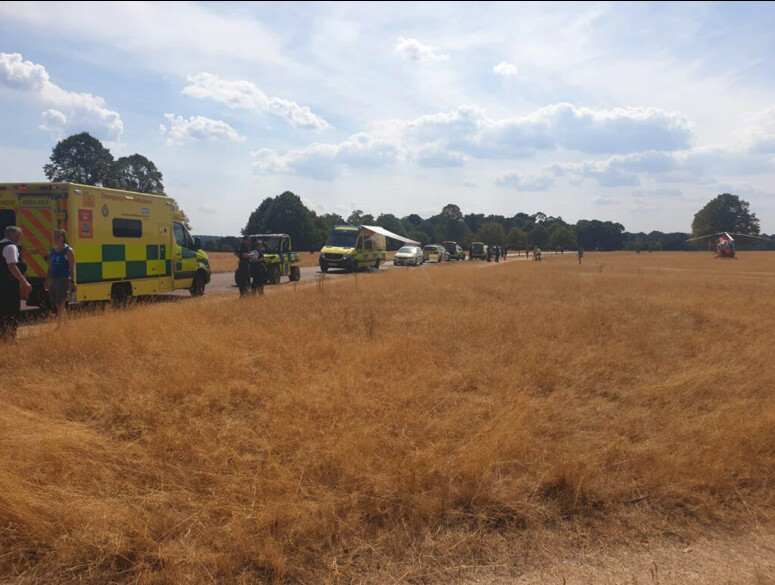

Four hundred runners took part in the event, and reportedly there were only a few water stations on the course.
On Sunday morning on Twitter, the Royal Parks Police issued a warning for exercising during a heatwave.
Several race participants took to social media questioning whether the RunThrough event should have been allowed to go ahead despite the high temperatures.
Thomas Davies, a runner who took part in the race, said on Twitter: “I don’t think the race should have gone ahead. The heat was absolutely mad!”
Many runners were upset that the start was not moved to an earlier time.
On Saturday, the RunThrough event posted a warning message on Instagram: “If you are competing this weekend, remember to slow down the pace and hydrate before, during and post-race. Know your fitness and stay safe.”
(08/20/2022) ⚡AMPby Running Magazine
The new 2023 World Championships entry standards are wild
On Thursday evening, World Athletics published the entry standards for the 2023 World Athletics Championships in Budapest. The time athletes are required to run for automatic qualification is faster than ever.
The championship will run later in the year than in 2022, from Aug. 19 to Aug. 27, 2023. Although these standards mean automatic qualification, there are still ways to qualify through a confusing qualification system that the World Athletics implemented for the World Championships in 2019. If an athlete is highly ranked in their respective event but has not run the standard, the athlete is still eligible for nomination by their national governing body.

For the first time ever, the mile – both in-stadium and road mile – will now be a qualifying event for the 1500m, while performances achieved on the road in the 5K and 10K will now be eligible for qualification in the 5,000m and 10,000m, respectively. In addition, the top eight athletes in the world cross country rankings not otherwise qualified through other pathways will be considered qualified for the 10,000m.
The 2023 championships will be held in the National Athletics Centre in Budapest, which is currently under construction, and will have a capacity of 36,000.
The 2022 championship standards were similar, but some events have gotten a lot quicker. Most notably, the men’s 800m, 100m, 5,000m and marathon standards have become more challenging, along with the women’s 3,000m steeplechase, 1,500m and 10,000m. The 2022 standards are below.
Due to the postponement of the 2022 World Championships and the 2020 Tokyo Olympics, athletes now have five years of straight major games, with Budapest 2023, the Paris Olympics in 2024 and the Tokyo world championships 2025 on the horizon.
(08/20/2022) ⚡AMPby Running magazine
Five records fall on opening day of NACAC Championships
Laulauga Tausaga-Collins led a gold medal sweep for the USA as five records fell on the opening day of the North and Central American & Caribbean (NACAC) Championships at the Grand Bahama Sports Complex in Freeport, The Bahamas, on Friday (19).
A World Championships finalist, Tausaga-Collins broke the discus championship record twice in her first two throws (62.21m and 63.18m) to claim one of the eight titles for the USA.
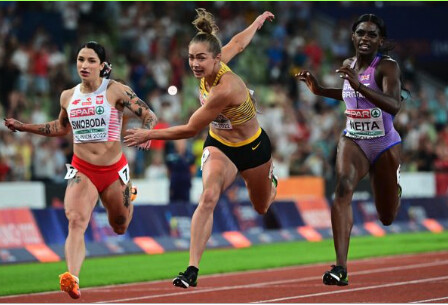
Three other women surpassed the 60-metre mark, all in the final round, but it was not enough to catch the US thrower, who was pleased with her win before heading to the Wanda Diamond League final.
Cuba’s 2015 world champion and 2016 Olympic bronze medallist Denia Caballero returned to competition after a full pause following the 2021 season and moved from fourth to silver with 61.86m in the sixth round, finishing ahead of USA’s Rachel Dincoff (61.56m) and Cuba’s Silinda Morales (60.73m).
Despite the hot and humid weather conditions, US distance runners rewrote three records: Gabrielle Jennings in the women’s 3000m steeplechase (9:34.36), Natosha Rogers in the 5000m (15:11.68) and Sean McGorty in the 10,000m (29:23.77) with the latter erasing one of the two remaining men’s championship records from the inaugural edition in El Salvador in 2007.
Not only did Jennings and Rogers break the championship records, they also led medal sweeps for the USA. Katie Rainsberger and Carmen Graves took silver and bronze in the steeplechase, while Fiona O’Keefe and Eleanor Fulton secured the other podium places in the 5000m.
USA’s 2016 world indoor champion Vashti Cunningham found some redemption after failing to reach the World Championships final on home soil. The three-time global medallist and Olympic finalist cleared 1.92m on her first attempt in the women’s high jump final, breaking St Lucia’s three-time winner Lavern Spencer’s 1.91m record set in Toronto in 2018.
One of the biggest surprises of the first day came in the women’s hammer, where USA’s world bronze medallist Janee’ Kassanavoid got the better of world champion Brooke Andersen. Kassanavoid won with 71.51m as Andersen managed 68.66m, recording just her second defeat of what has otherwise been a highly successful breakthrough season.
Oop The other winners on the opening day were Chris Bernard in the men’s triple jump (16.40m) and Roger Steen in the shot put (20.78m).
In other action outside the finals, world and Olympic champion Shaune Miller-Uibo delighted the home crowd with an easy semifinal win in the women’s 400m in 50.84, only 0.02 off the championship record. Jamaica’s Olympic bronze medallist Megan Tapper led the semifinals in the 100m hurdles (12.62) while her compatriot Andrew Hudson (20.25) and USA’s Brittany Brown (22.59) led the 200m semifinals.
A total of 17 finals will be contested on Saturday, including the men’s and women's 100m and 400m, featuring two other individual world champions from Eugene: Jamaica’s Shericka Jackson (200m champion running 100m) and Miller-Uibo.
The fourth edition of the championships, held for the first time to the Caribbean, was opened by the Prime Minister of The Bahamas, Philip Davis, and is dedicated to the late Anita Doherty, an educator of many generations of Bahamians, who competed for the island nation in the pentathlon at the 1970 Commonwealth Games.
(08/20/2022) ⚡AMPby World Athletics
Run stronger by using these words four tips from Olympian Kara Goucher
Two-time American Olympian and NBC sports analyst Kara Goucher‘s tips for creating a mantra come from personal experience with nerves and intimidation. “Working on a mantra helped me shut out the negativity and focus on the present,” the athlete shares in her book Strong.
On race day, Goucher would repeat ‘I belong.’ to herself. “It centered my mind and allowed me to execute the race I knew I was capable of running,” she explains. Use Goucher’s suggestions to create a phrase or mantra that will elevate your own racing.
Keep it simple
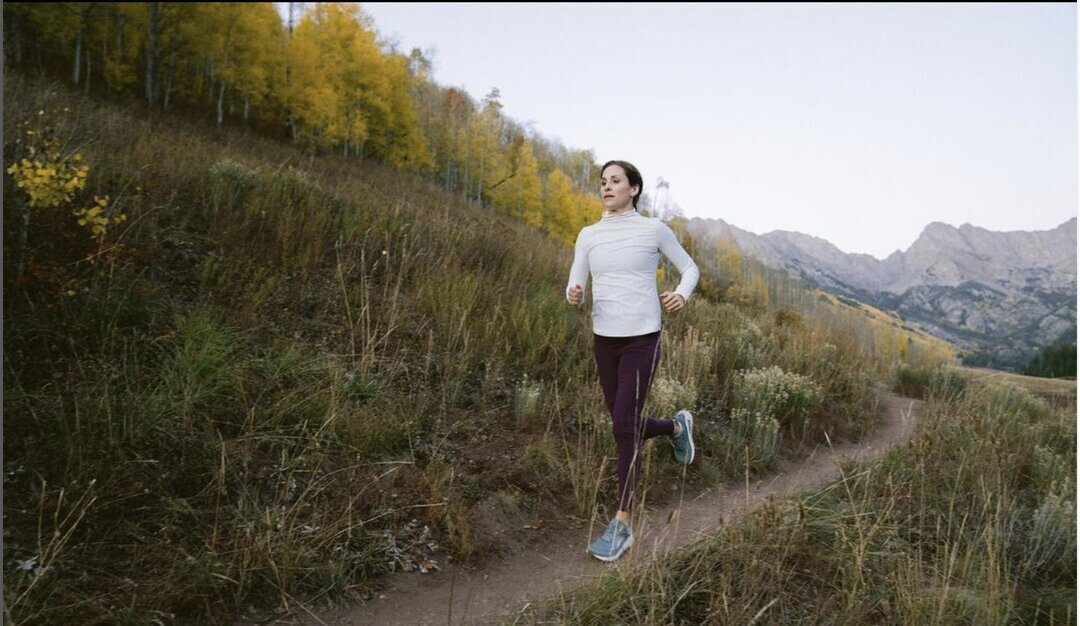
A single word or short phrase is enough. “Short and sweet works best,” Goucher says. When you’re running hard, deep thinking is challenging and your mantra should be easy to remember and repeat.
Use present tense

Performance relies on an athlete’s ability to stay in the now. “Active words like ‘focus’ and ‘execute’ can help pull you into the moment to concentrate on the task at hand,” says Goucher.
Establish an emotional connection
A great mantra will be connected to a strong mental state and positive feelings. Goucher suggests thinking of words or phrases that “light you up with confidence, motivation, and readiness.” For her, phrases like ‘grit and grace’ and ‘why not me?’ elevated her ability to perform at her best.
Test your material
Test your mantras by using words and phrases in workouts and races. If you find something you repeat to yourself resonates strongly, write it down. Goucher suggests placing mantras strategically on water bottles, sports bags, or even on your wrist or arm as a reminder on race day.
Mental strength comes into play whenever you put forth a hard effort: be creative and consistent with your mantra, and you’ll have a new tool to bring out reserves of mental toughness you weren’t aware you had.
(08/19/2022) ⚡AMPby Keeley Milne
Jakob Ingebrigtsen Completes “Double-Double” by Winning 2022 European 1500 Title
Jakob Ingebrigtsen is golden again.
After claiming 5,000-meter gold at the European Athletics Championships in Munich on Tuesday, Ingebrigtsen doubled back and won Thursday’s 1500-meter final in wire-to-wire fashion, setting a championship record of 3:32.76 in the process. Jake Heyward, who just missed out on making the British team for the World Championships and finished 5th at the Commonwealth Games for Wales, took silver in 3:34.44, running down Spain’s Mario Garcia Romo, who held on for bronze in 3:34.88.

The victory for Ingebrigtsen improves his record to 4-0 in European outdoor finals and means he has completed the “double-double” by winning the 1500 and 5000 at both the 2018 and 2022 European championships. All at the age of 21.
As is his custom, Ingebrigtsen started slowly off the line, but worked his way into the lead on the home straight of the first lap and would stay there the rest of the way. He hit 400 in a quick 56.34, 800 in 1:54.11 (57.77 lap), and 1200 in 2:51.68 (57.57 lap), at which point a pack of four men — Garcia Romo, Heyward, Italy’s Pietro Arese, and Poland’s Michal Rozmys were in close pursuit. Ingebrigtsen opened a small gap on the back straight before blasting away over the final 200, using a 55.24 last lap (27.14 last 100) to crush all opposition.

The only drama in the final half-lap centered around silver and bronze as Heyward passed Garcia Romo in the home straight to take silver and Garcia Romo held off the 22-year-old Arese — who ran a 2+ second pb of 3:35.00 — to earn bronze to go with the Euro U23 silver he won last year.
(08/19/2022) ⚡AMPby Jonathan Gault
European Athletics Champioships Munich 2022
European Championships Munich 2022 will be the biggest sports event in Germany since the 1972 Summer Olympics. From 15-21 August 2022, European sport will be united as its best athletes compete for the highest accolade of their sport on the continent – the title of ‘European Champion’. The second edition of the European Championships will feature nine Olympic sports:Athletics, Beach...
more...Have a blast on your easy runs, just like olympian Molly Seidel
U.S. Olympic marathoner Molly Seidel can run a magnificently fast race, but she’s also an expert on running slowly. She completed the #slowestmilechallenge in 2020 and revived it this year, managing to run a mile in an impressively slow 36:56. Her enthusiasm, along with her sister Isabel Seidel‘s commentary, will motivate you to keep those easy runs sloth-like (OK, maybe not quite that slow).
The slowest mile challenge is funny, but you can also use it as inspiration to inject some zest into your own easy runs.
Easy runs can get boring. Most of us know we should maintain a slow (for us) pace most days, but it can be ever-so-tempting to pick it up–you might even catch yourself speeding up accidentally. Many runners associate that completely wiped-out feeling you get after speedwork with a great workout, and it’s time to change that perspective.

Turn it into a challenge
It certainly doesn’t have to be as extreme as Molly’s slowest mile, but adding a personal challenge to your run can motivate you to get out the door. Set a (slow) goal pace, and see if you can maintain it throughout your run, catching yourself when you start speeding up. Not only will this keep you focused during your time out there, but you’ll reap the benefits of practicing discipline and patience on race day.

Try new, unique (and fun) routes
An easy run is a perfect opportunity to explore a new area or route. Use your easy runs as a chance to finesse your route-mapping skills on Strava, or aim for a specific destination.
Make your end (or mid-point) goal a coffee shop, ice cream stop, or local park, and for bonus points, invite some friends to meet you. The small reward will give you a boost to get going and to maintain your easy-pace goals.
Be open to suggestions
Runners can be notoriously stuck in their habits–I once listened to the same playlist for an entire year. We’re often reluctant to throw something new into the routine. To spice up those easy runs, be open to ideas from others.
If a friend recommends a fantastic audiobook and you generally only listen to music, a slow run is a perfect time to give the book a fighting chance. If you always run alone, but know of a local running group, join them on a slow day. It might feel initially uncomfortable to throw a small wrench into your routine, but you’ll have the opportunity to work through the discomfort, another integral skill to fine-tune for races.
Slow runs have a multitude of benefits: you’ll increase running efficiency, have the opportunity to work on better form, and build strength without needing a lot of recovery time. By upping the enjoyment of your easy run days, you’ll be less likely to skip them or to run too quickly.
(08/19/2022) ⚡AMPby Running Magazine


